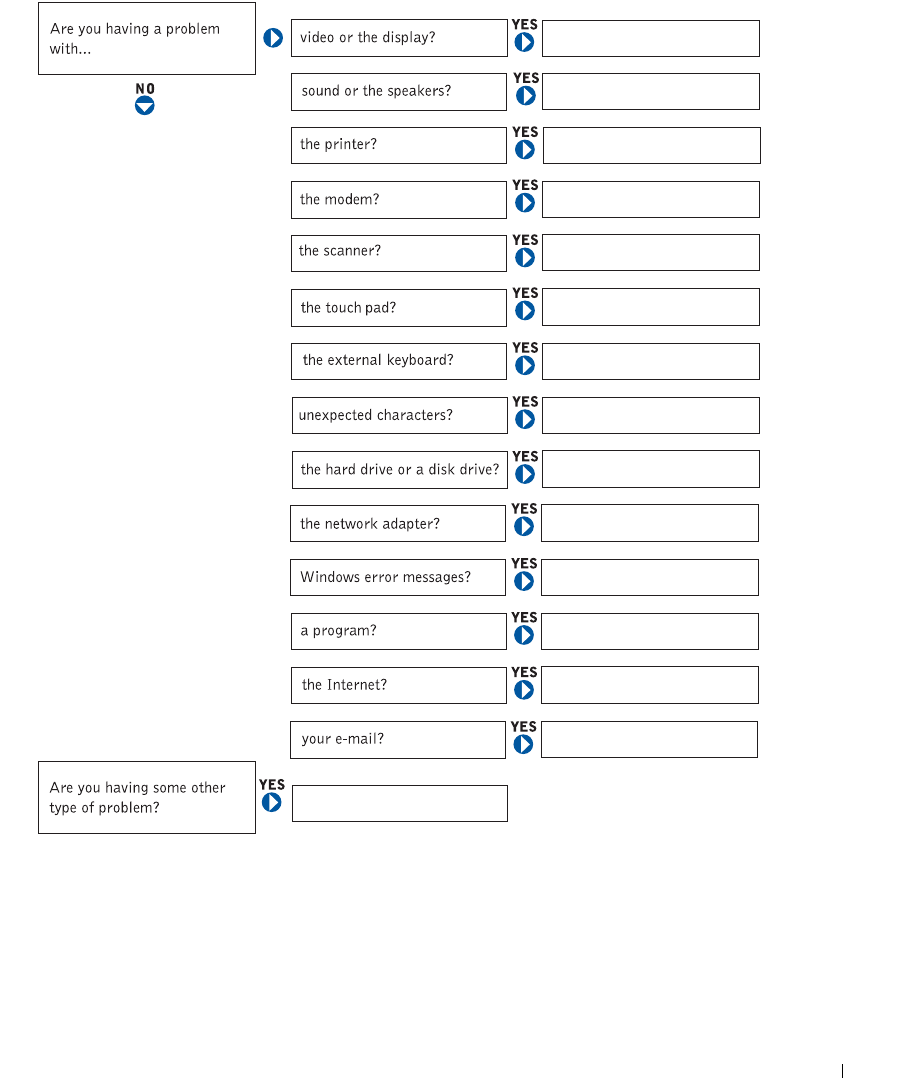Broadcom BRCM1017 Broadcom 802.11ag WLAN mini PCI card User Manual 2U589bk0
Broadcom Corporation Broadcom 802.11ag WLAN mini PCI card 2U589bk0
Broadcom >
Contents
- 1. Users Guide
- 2. user guide
- 3. Updated portable user guide
- 4. user guide PP07L
- 5. user guide PPT
- 6. PP02X user guide part 1
- 7. PP02X user guide part 2
- 8. PP05L user guide part 1
- 9. PP05L user guide part 2
- 10. Updated User guide partable platform
- 11. User guide PP02X part 1
- 12. User guide PP02X part 2
- 13. User guide PP05L part 1
- 14. User guide PP05L part 2
- 15. User guide PP07L
- 16. User guide PPT
- 17. users manual
- 18. Host Manual 1
- 19. Host Manual 2
user guide PP07L

www.dell.com | support.dell.com
Dell™ Inspiron™ 5100
Owner’s Manual

Notes, Notices, and Cautions
NOTE: A NOTE indicates important information that helps you make better
use of your computer.
NOTICE: A NOTICE indicates either potential damage to hardware or loss of
data and tells you how to avoid the problem.
CAUTION: A CAUTION indicates a potential for property damage,
personal injury, or death.
Abbreviations and Acronyms
For a complete list of abbreviations and acronyms, see the Tell Me How help
file. To access the help file, see page 74.
____________________
Information in this document is subject to change without notice.
© 2002 Dell Computer Corporation. All rights reserved.
Reproduction in any manner whatsoever without the written permission of Dell Computer
Corporation is strictly forbidden.
Trademarks used in this text: Dell, the DELL logo, AccessDirect, Inspiron, Dell Precision,
Dimension, OptiPlex, Latitude, Dell TrueMobile, and DellNet are trademarks of Dell Computer
Corporation; Intel, Pentium, and Celeron are registered trademarks of Intel Corporation; Microsoft
and Windows are registered trademarks of Microsoft Corporation; EMC is a registered trademark
of EMC Corporation.
Other trademarks and trade names may be used in this document to refer to either the entities claiming
the marks and names or their products. Dell Computer Corporation disclaims any proprietary interest
in trademarks and trade names other than its own.
Model PP07L
December 2002 P/N 2U589 Rev. A00

Contents 3
Contents
CAUTION: Safety Instructions . . . . . . . . . . . . . . . . . . . 11
General . . . . . . . . . . . . . . . . . . . . . . . . . . . . . 11
Power . . . . . . . . . . . . . . . . . . . . . . . . . . . . . . 12
Battery . . . . . . . . . . . . . . . . . . . . . . . . . . . . . 13
Air Travel . . . . . . . . . . . . . . . . . . . . . . . . . . . . 14
EMC Instructions . . . . . . . . . . . . . . . . . . . . . . . . 14
California Residents . . . . . . . . . . . . . . . . . . . . . . . 14
When Using Your Computer . . . . . . . . . . . . . . . . . . . . 15
Ergonomic Computing Habits . . . . . . . . . . . . . . . . . . 16
When Working Inside Your Computer . . . . . . . . . . . . . . 16
Protecting Against Electrostatic Discharge . . . . . . . . . . . 17
Battery Disposal . . . . . . . . . . . . . . . . . . . . . . . . 17
1A Tour of Your Computer
Front View . . . . . . . . . . . . . . . . . . . . . . . . . . . . . 20
Left Side View . . . . . . . . . . . . . . . . . . . . . . . . . . . 23
Right Side View . . . . . . . . . . . . . . . . . . . . . . . . . . . 24
Back View . . . . . . . . . . . . . . . . . . . . . . . . . . . . . . 26
Bottom View . . . . . . . . . . . . . . . . . . . . . . . . . . . . 29
2Setting Up Your Computer
Connecting to the Internet . . . . . . . . . . . . . . . . . . . . . 32
Setting Up Your Internet Connection . . . . . . . . . . . . . . 32

4Contents
Modem and Internet Connection Problems . . . . . . . . . . . . 33
E-Mail Problems . . . . . . . . . . . . . . . . . . . . . . . . . . 34
Transferring Information to a New Computer . . . . . . . . . . 35
Setting Up a Printer . . . . . . . . . . . . . . . . . . . . . . . . 36
Printer Cable . . . . . . . . . . . . . . . . . . . . . . . . . 37
Connecting a USB Printer . . . . . . . . . . . . . . . . . . . 37
Printer Problems . . . . . . . . . . . . . . . . . . . . . . . . . 37
Power Protection Devices . . . . . . . . . . . . . . . . . . . . . 38
Surge Protectors . . . . . . . . . . . . . . . . . . . . . . . . 38
Line Conditioners . . . . . . . . . . . . . . . . . . . . . . . 39
Uninterruptible Power Supplies . . . . . . . . . . . . . . . . 39
Turning Off Your Computer . . . . . . . . . . . . . . . . . . . . 39
3Using a Battery
Battery Performance . . . . . . . . . . . . . . . . . . . . . . . 42
Checking the Battery Charge . . . . . . . . . . . . . . . . . . . 43
Power Meter . . . . . . . . . . . . . . . . . . . . . . . . . . 43
Low-Battery Warning . . . . . . . . . . . . . . . . . . . . . 43
Charging the Battery . . . . . . . . . . . . . . . . . . . . . . . 44
Removing a Battery . . . . . . . . . . . . . . . . . . . . . . . . 44
Installing a Battery . . . . . . . . . . . . . . . . . . . . . . . . 45
Storing a Battery . . . . . . . . . . . . . . . . . . . . . . . . . 45
Battery and Power Problems . . . . . . . . . . . . . . . . . . . 45
If the battery is not charging . . . . . . . . . . . . . . . . . . 46
If battery life is short . . . . . . . . . . . . . . . . . . . . . 46

Contents 5
4Using the Keyboard and Touch Pad
Dell™ AccessDirect™ Button . . . . . . . . . . . . . . . . . . . . 48
Reprogramming the Button . . . . . . . . . . . . . . . . . . . 48
Numeric Keypad . . . . . . . . . . . . . . . . . . . . . . . . . . 48
Keyboard Shortcuts . . . . . . . . . . . . . . . . . . . . . . . . 49
System Functions . . . . . . . . . . . . . . . . . . . . . . . . 49
Display Functions . . . . . . . . . . . . . . . . . . . . . . . . 49
Power Management . . . . . . . . . . . . . . . . . . . . . . . 49
Speaker Functions . . . . . . . . . . . . . . . . . . . . . . . 50
Microsoft® Windows® Logo Key Functions . . . . . . . . . . . 50
Touch Pad . . . . . . . . . . . . . . . . . . . . . . . . . . . . . . 50
Customizing the Touch Pad . . . . . . . . . . . . . . . . . . . 51
Touch Pad or Mouse Problems . . . . . . . . . . . . . . . . . . . 52
External Keyboard Problems . . . . . . . . . . . . . . . . . . . . 52
Unexpected Characters . . . . . . . . . . . . . . . . . . . . . . . 53
5Using CDs, DVDs, and Other Multimedia
Using CDs and DVDs . . . . . . . . . . . . . . . . . . . . . . . . 56
CD or DVD Problems . . . . . . . . . . . . . . . . . . . . . . . . 56
If you cannot play a CD, CD-RW, or DVD . . . . . . . . . . . . 56
If you cannot eject the CD, CD-RW, or DVD drive tray . . . . . 56
If you hear an unfamiliar scraping or grinding sound . . . . . . 56
If the CD-RW drive stops writing . . . . . . . . . . . . . . . . 56
Sound and Speaker Problems . . . . . . . . . . . . . . . . . . . 57
If you have a problem with integrated speakers . . . . . . . . . 57
If you have a problem with external speakers . . . . . . . . . . 57

6Contents
Copying CDs . . . . . . . . . . . . . . . . . . . . . . . . . . . . 58
Using Easy CD Creator Basic . . . . . . . . . . . . . . . . . 59
Using Blank CD-R Discs or Blank CD-RW Discs . . . . . . . . 59
Helpful Tips . . . . . . . . . . . . . . . . . . . . . . . . . . 59
How to Copy a CD . . . . . . . . . . . . . . . . . . . . . . . 60
Connecting a Television to the Computer . . . . . . . . . . . . . 61
S-Video Connection . . . . . . . . . . . . . . . . . . . . . . 62
Composite Video Connection . . . . . . . . . . . . . . . . . . 64
Enabling the Display Settings for a Television . . . . . . . . . 66
6Setting Up a Home and Office Network
Connecting to a Network Adapter . . . . . . . . . . . . . . . . 68
Network Setup Wizard . . . . . . . . . . . . . . . . . . . . . . 68
Network Problems . . . . . . . . . . . . . . . . . . . . . . . . . 69
7Solving Problems
Finding Solutions . . . . . . . . . . . . . . . . . . . . . . . . . 72
Accessing Help . . . . . . . . . . . . . . . . . . . . . . . . . . 74
Error Messages . . . . . . . . . . . . . . . . . . . . . . . . . . 74
Video and Display Problems . . . . . . . . . . . . . . . . . . . . 75
If the display is blank . . . . . . . . . . . . . . . . . . . . . 75
If the display is difficult to read . . . . . . . . . . . . . . . . 76
If only part of the display is readable . . . . . . . . . . . . . . 77
Scanner Problems . . . . . . . . . . . . . . . . . . . . . . . . . 77
Drive Problems . . . . . . . . . . . . . . . . . . . . . . . . . . 78
If you cannot save a file to a floppy drive . . . . . . . . . . . . 78
If you have problems with a hard drive . . . . . . . . . . . . . 79
PC Card Problems . . . . . . . . . . . . . . . . . . . . . . . . . 79

Contents 7
General Program Problems . . . . . . . . . . . . . . . . . . . . . 80
A program crashes . . . . . . . . . . . . . . . . . . . . . . . 80
A program stops responding . . . . . . . . . . . . . . . . . . . 80
Error messages appear . . . . . . . . . . . . . . . . . . . . . 80
Resolving Other Technical Problems . . . . . . . . . . . . . . . . 80
If Your Computer Gets Wet . . . . . . . . . . . . . . . . . . . . . 81
If You Drop or Damage Your Computer . . . . . . . . . . . . . . 82
Drivers . . . . . . . . . . . . . . . . . . . . . . . . . . . . . . . 82
What Is a Driver? . . . . . . . . . . . . . . . . . . . . . . . . 82
Identifying Drivers . . . . . . . . . . . . . . . . . . . . . . . 83
Reinstalling Drivers . . . . . . . . . . . . . . . . . . . . . . . 83
Manually Reinstalling Drivers for Windows XP . . . . . . . . . 85
Resolving Software and Hardware Incompatibilities . . . . . . . 86
Using System Restore . . . . . . . . . . . . . . . . . . . . . . . 87
Creating a Restore Point . . . . . . . . . . . . . . . . . . . . 87
Restoring the Computer to an Earlier Operating State . . . . . . 87
Undoing the Last System Restore . . . . . . . . . . . . . . . . 88
Reinstalling Microsoft® Windows® XP . . . . . . . . . . . . . . . 89
Before You Reinstall . . . . . . . . . . . . . . . . . . . . . . 89
Reinstalling Windows XP . . . . . . . . . . . . . . . . . . . . 89
8Adding and Replacing Parts
Before You Add or Replace Parts . . . . . . . . . . . . . . . . . . 94
Memory . . . . . . . . . . . . . . . . . . . . . . . . . . . . . . . 94
Modem and Mini PCI Card . . . . . . . . . . . . . . . . . . . . . 96
Adding a Modem . . . . . . . . . . . . . . . . . . . . . . . . 97
Adding a Mini PCI Card . . . . . . . . . . . . . . . . . . . . 98

8Contents
Hard Drive . . . . . . . . . . . . . . . . . . . . . . . . . . . . . 100
Returning a Hard Drive to Dell . . . . . . . . . . . . . . . . . 102
CD or DVD Drive . . . . . . . . . . . . . . . . . . . . . . . . . . 102
Keyboard. . . . . . . . . . . . . . . . . . . . . . . . . . . . . . 104
9Appendix
Specifications . . . . . . . . . . . . . . . . . . . . . . . . . . . 110
Using the System Setup Program . . . . . . . . . . . . . . . . . 117
Overview . . . . . . . . . . . . . . . . . . . . . . . . . . . . 117
Viewing the System Setup Screens . . . . . . . . . . . . . . . 117
System Setup Screens . . . . . . . . . . . . . . . . . . . . . 117
Commonly Used Options . . . . . . . . . . . . . . . . . . . . 118
System and Battery Performance Optimization . . . . . . . . . 119
System Performance Overview . . . . . . . . . . . . . . . . . 119
Optimizing Power Consumption and Battery
Charge Time . . . . . . . . . . . . . . . . . . . . . . . . . . 120
Variable Speed Fan . . . . . . . . . . . . . . . . . . . . . . 120
Dell Technical Support Policy (U.S. Only) . . . . . . . . . . . . 121
Definition of "Dell-Installed" Software and Peripherals . . . . . 121
Definition of "Third-Party" Software and Peripherals . . . . . . 122
Contacting Dell . . . . . . . . . . . . . . . . . . . . . . . . . . 122
Regulatory Notices . . . . . . . . . . . . . . . . . . . . . . . . 140
NOM Information (Mexico Only) . . . . . . . . . . . . . . . . 141
Limited Warranties and Return Policy . . . . . . . . . . . . . . 143
Limited Warranty for the U.S. . . . . . . . . . . . . . . . . . 143
"Total Satisfaction" Return Policy (U.S. Only). . . . . . . . . . 146
Limited Warranty Terms for Canada . . . . . . . . . . . . . . 147
"Total Satisfaction" Return Policy (Canada Only) . . . . . . . . 150
Dell Software and Peripherals (Canada Only). . . . . . . . . . 151

Contents 9
One-Year End-User Manufacturer Guarantee
(Latin America and the Caribbean Only) . . . . . . . . . . . . 152
Intel® Warranty Statement for Pentium® and
Celeron® Processors Only (U.S. and Canada Only) . . . . . . . 153
Index . . . . . . . . . . . . . . . . . . . . . . . . . . . . . . . . . . 155

10 Contents

CAUTION: Safety Instructions 11
CAUTION: Safety Instructions
Use the following safety guidelines to help ensure your own personal safety and to help protect
your computer and working environment from potential damage.
General
• Do not attempt to service the computer yourself unless you are a trained service
technician. Always follow installation instructions closely.
• If you use an extension power cable with your AC adapter, ensure that the total ampere
rating of the products plugged in to the extension power cable does not exceed the
ampere rating of the extension cable.
• Do not push objects into air vents or openings of your computer. Doing so can cause fire
or electric shock by shorting out interior components.
• Do not block air vents or openings of your computer. Doing so can damage the computer
or cause fire.
• Do not store your computer in a low-airflow environment, such as a carrying case or a
closed briefcase, while the computer is turned on or connected to the AC adapter.
Restricting airflow can damage the computer or cause a fire.
• Keep your computer away from radiators and heat sources. Also, do not block cooling
vents. Avoid placing loose papers underneath your computer; do not place your computer
in a closed-in wall unit or on a bed, sofa, or rug.
• Place the AC adapter in a ventilated area, such as a desk top or on the floor, when you use
it to run the computer or to charge the battery. Do not cover the AC adapter with papers
or other items that will reduce cooling; also, do not use the AC adapter inside a carrying
case.
• The AC adapter may become hot during normal operation of your computer. Use care
when handling the adapter during or immediately after operation.
• Do not allow your portable computer to operate with the base resting directly on exposed
skin for extended periods of time. The surface temperature of the base will rise during
normal operation (particularly when AC power is present). Allowing sustained contact
with exposed skin can cause discomfort or, eventually, a burn.
• Do not use your computer in a wet environment, for example, near a bath tub, sink, or
swimming pool or in a wet basement
• If your computer includes an integrated or optional (PC Card) modem, disconnect the
modem cable if an electrical storm is approaching to avoid the remote risk of electric
shock from lightning via the telephone line.

12 CAUTION: Safety Instructions
www.dell.com | support.dell.com
• To help avoid the potential hazard of electric shock, do not connect or disconnect any
cables or perform maintenance or reconfiguration of this product during an electrical
storm. Do not use your computer during an electrical storm unless all cables have been
disconnected and the computer is operating on battery power.
• If your computer includes a modem, the cable used with the modem should be
manufactured with a minimum wire size of 26 American wire gauge (AWG) and an FCC-
compliant RJ-11 modular plug.
• Before you open the memory module cover or Mini PCI card/modem cover on the bottom
of your computer, disconnect all cables from their electrical outlets and disconnect the
telephone cable.
• If your computer has a modem RJ-11 connector and a network RJ-45 connector, insert the
telephone cable into the RJ-11 connector, not the RJ-45 connector.
•PC Cards may become very warm during normal operation. Use care when removing PC
Cards after their continuous operation.
• Before you clean your computer, disconnect the computer from the electrical outlet.
Clean your computer with a soft cloth dampened with water. Do not use liquid or aerosol
cleaners, which may contain flammable substances.
Power
• Use only the Dell-provided AC adapter approved for use with this computer. Use of
another AC adapter may cause a fire or explosion.
• Before you connect the computer to an electrical outlet, check the AC adapter voltage
rating to ensure that the required voltage and frequency match the available power
source.
• To remove the computer from all power sources, turn the computer off, remove the
battery pack, and disconnect the AC adapter from the electrical outlet.
• To help prevent electric shock, plug the AC adapter and device power cables into properly
grounded power sources. These power cables may be equipped with 3-prong plugs to
provide an earth grounding connection. Do not use adapter plugs or remove the
grounding prong from the power cable plug. If you use a power extension cable, use the
appropriate type, 2-prong or 3-prong, to mate with the AC adapter power cable.
• Be sure that nothing rests on your AC adapter’s power cable and that the cable is not
located where it can be tripped over or stepped on.
CAUTION: Safety Instructions
(continued)

CAUTION: Safety Instructions 13
• If you are using a multiple-outlet power strip, use caution when plugging the AC
adapter’s power cable into the power strip. Some power strips may allow you to insert the
plug incorrectly. Incorrect insertion of the power plug could result in permanent damage
to your computer, as well as risk of electric shock and/or fire. Ensure that the ground
prong of the power plug is inserted into the mating ground contact of the power strip.
Battery
• Use only Dell™ battery modules that are approved for use with this computer. Use of
other types may increase the risk of fire or explosion.
• Do not carry a battery pack in your pocket, purse, or other container where metal objects
(such as car keys or paper clips) could short-circuit the battery terminals. The resulting
excessive current flow can cause extremely high temperatures and may result in damage
to the battery pack or cause fire or burns.
• The battery poses a burn hazard if you handle it improperly. Do not disassemble it.
Handle a damaged or leaking battery pack with extreme care. If the battery is damaged,
electrolyte may leak from the cells and may cause personal injury.
• Keep the battery away from children.
• Do not store or leave your computer or battery pack near a heat source such as a radiator,
fireplace, stove, electric heater, or other heat-generating appliance or otherwise expose it
to temperatures in excess of 60ºC (140ºF). When heated to excessive temperatures,
battery cells could explode or vent, posing a risk of fire.
• Do not dispose of your computer’s battery in a fire or with normal household waste.
Battery cells may explode. Discard a used battery according to the manufacturer’s
instructions or contact your local waste disposal agency for disposal instructions. Dispose
of a spent or damaged battery promptly.
CAUTION: Safety Instructions
(continued)

14 CAUTION: Safety Instructions
www.dell.com | support.dell.com
Air Travel
• Certain Federal Aviation Administration regulations and/or airline-specific restrictions
may apply to the operation of your Dell computer while you are on board an aircraft. For
example, such regulations/restrictions may prohibit the use of any personal electronic
device (PED) that has the capacity for intentional transmission of radio frequency or
other electromagnetic signals while on an aircraft.
– In order to best comply with all such restrictions, if your Dell portable computer is
equipped with Dell TrueMobile™ or some other wireless communication device,
please disable this device before you board the aircraft and follow all instructions
provided by airline personnel with regard to such device.
– Additionally, the use of any PED, such as a portable computer, may be prohibited in
aircraft during certain critical phases of flight, for example, takeoff and landing. Some
airlines may further define the critical flight phase as any time the aircraft is below
3050 m (10,000 ft). Please follow the airline’s specific instructions as to when the use
of a PED is allowed.
EMC Instructions
Use shielded signal cables to ensure that you maintain the appropriate EMC classification for
the intended environment. For parallel printers, a cable is available from Dell. If you prefer, you
can order a cable from Dell at its worldwide website at www.dell.com.
Static electricity can harm electronic components inside your computer. To prevent static
damage, discharge static electricity from your body before you touch any of your computer’s
electronic components, such as a memory module. You can do so by touching an unpainted
metal surface on the computer’s input/output panel.
California Residents
WARNING: Handling the cable on this product, or cables associated with accessories sold with
this product, will expose you to lead, a chemical known to the State of California to cause birth
defects or other reproductive harm. Wash your hands after handling the cable.
CAUTION: Safety Instructions
(continued)

When Using Your Computer 15
When Using Your Computer
Observe the following safe-handling guidelines to prevent damage to your computer:
• When setting up the computer for work, place it on a level surface.
• When traveling, do not check the computer as baggage. You can put your computer
through an X-ray security machine, but never put your computer through a metal
detector. If you have the computer checked by hand, be sure to have a charged battery
available in case you are asked to turn on the computer.
• When traveling with the hard drive removed from the computer, wrap the drive in a
nonconducting material, such as cloth or paper. If you have the drive checked by hand, be
ready to install the drive in the computer. You can put the hard drive through an X-ray
security machine, but never put the drive through a metal detector.
• When traveling, do not place the computer in overhead storage compartments where it
could slide around. Do not drop your computer or subject it to other mechanical shocks.
• Protect your computer, battery, and hard drive from environmental hazards such as dirt,
dust, food, liquids, temperature extremes, and overexposure to sunlight.
• When you move your computer between environments with very different temperature
and/or humidity ranges, condensation may form on or within the computer. To avoid
damaging the computer, allow sufficient time for the moisture to evaporate before using
the computer.
NOTICE: When taking the computer from low-temperature conditions into a warmer environment
or from high-temperature conditions into a cooler environment, allow the computer to acclimate to
room temperature before turning on power.
• When you disconnect a cable, pull on its connector or on its strain-relief loop, not on the
cable itself. As you pull out the connector, keep it evenly aligned to avoid bending any
connector pins. Also, before you connect a cable make sure both connectors are correctly
oriented and aligned.
• Handle components with care. Hold a component such as a memory module by its edges,
not its pins.
• When preparing to remove a memory module from the system board or disconnect a
device from the computer, turn off the computer, disconnect the AC adapter cable, and
then wait 5 seconds before proceeding to help avoid possible damage to the system board.

16 When Using Your Computer
www.dell.com | support.dell.com
• Clean the display with a soft, clean cloth and water. Apply the water to the cloth; then
stroke the cloth across the display in one direction, moving from the top of the display to
the bottom. Remove moisture from the display quickly and keep the display dry. Long-
term exposure to moisture can damage the display. Do not use a commercial window
cleaner to clean your display.
• If your computer gets wet or is damaged, follow the procedures described in "If Your
Computer Gets Wet" on page 81 or "If You Drop or Damage Your Computer" on page 82.
If, after following these procedures, you confirm that your computer is not operating
properly, contact Dell (see page 122 for the appropriate contact information).
Ergonomic Computing Habits
CAUTION: Improper or prolonged keyboard use may result in injury.
CAUTION: Viewing the display or external monitor screen for extended periods of
time may result in eye strain.
For comfort and efficiency, observe the ergonomic guidelines in the Tell Me How help file when
setting up and using your computer. To access the help file, see page 74.
This portable computer is not designed for continuous operation as office equipment. For
extended use in an office, it is recommended that you connect an external keyboard.
When Working Inside Your Computer
Before removing or installing memory modules, Mini PCI cards, modems, keyboards, or CD or
DVD drives, perform the following steps in the sequence indicated.
NOTICE: The only time you should ever access the inside of your computer is when you are
installing memory modules, a Mini PCI card, a modem, a keyboard, or a CD or DVD drive.
NOTICE: Wait 5 seconds after turning off the computer before disconnecting a device or removing
a memory module, Mini PCI card, modem, keyboard, or CD or DVD drive to help prevent possible
damage to the system board.
1Shut down your computer and turn off any attached devices.
2Disconnect your computer and devices from electrical outlets to reduce the potential for
personal injury or shock. Also, disconnect any telephone or telecommunication lines from
the computer.
3Remove the main battery from the battery bay and, if necessary, the secondary battery
from the module bay.
When Using Your Computer
(continued)

When Using Your Computer 17
4Ground yourself by touching the unpainted metal surface of the I/O panel on the back of
the computer.
While you work, periodically touch the I/O panel to dissipate any static electricity that
might harm internal components.
Protecting Against Electrostatic Discharge
Static electricity can harm electronic components inside your computer. To prevent static
damage, discharge static electricity from your body before you touch any of your computer’s
electronic components, such as a memory module. You can do so by touching an unpainted
metal surface on the computer’s I/O panel.
As you continue to work inside the computer, periodically touch an I/O connector to remove
any static charge your body may have accumulated.
You can also take the following steps to prevent damage from electrostatic discharge (ESD):
• When unpacking a static-sensitive component from its shipping carton, do not remove
the component from the antistatic packing material until you are ready to install the
component. Just before unwrapping the antistatic packaging, be sure to discharge static
electricity from your body.
• When transporting a sensitive component, first place it in an antistatic container or
packaging.
• Handle all sensitive components in a static-safe area. If possible, use antistatic floor pads
and workbench pads.
Battery Disposal
Your computer uses a lithium-ion battery and a reserve battery. For instructions about replacing
the lithium-ion battery in your computer, refer to "Removing a Battery" on page 44. The reserve
battery is a long-life battery, and it is very possible that you will never need to replace it.
However, should you need to replace it, the procedure must be performed by an authorized
service technician.
Do not dispose of the battery along with household waste. Contact your local waste disposal
agency for the address of the nearest battery deposit site.
When Using Your Computer
(continued)

18 When Using Your Computer
www.dell.com | support.dell.com
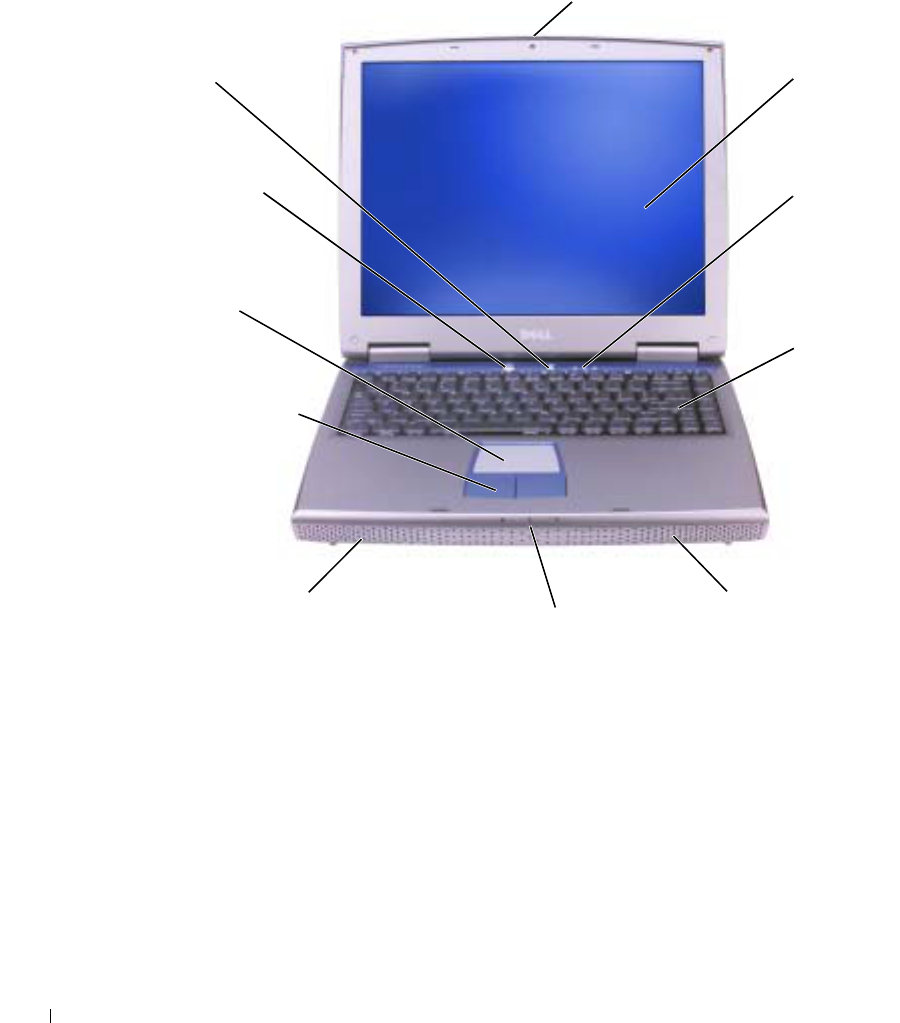
20 A Tour of Your Computer
www.dell.com | support.dell.com
Front View
DISPLAY LATCH —Keeps the display closed.
DISPLAY —For more information about your display, see "Using the Display" in
the Tell Me How help file. To access the help file, see page 74.
display latch
display
speaker
keyboard
status lights
keyboard
device status lights
touch pad
speaker
touch pad buttons
power button
Dell™ AccessDirect™
button
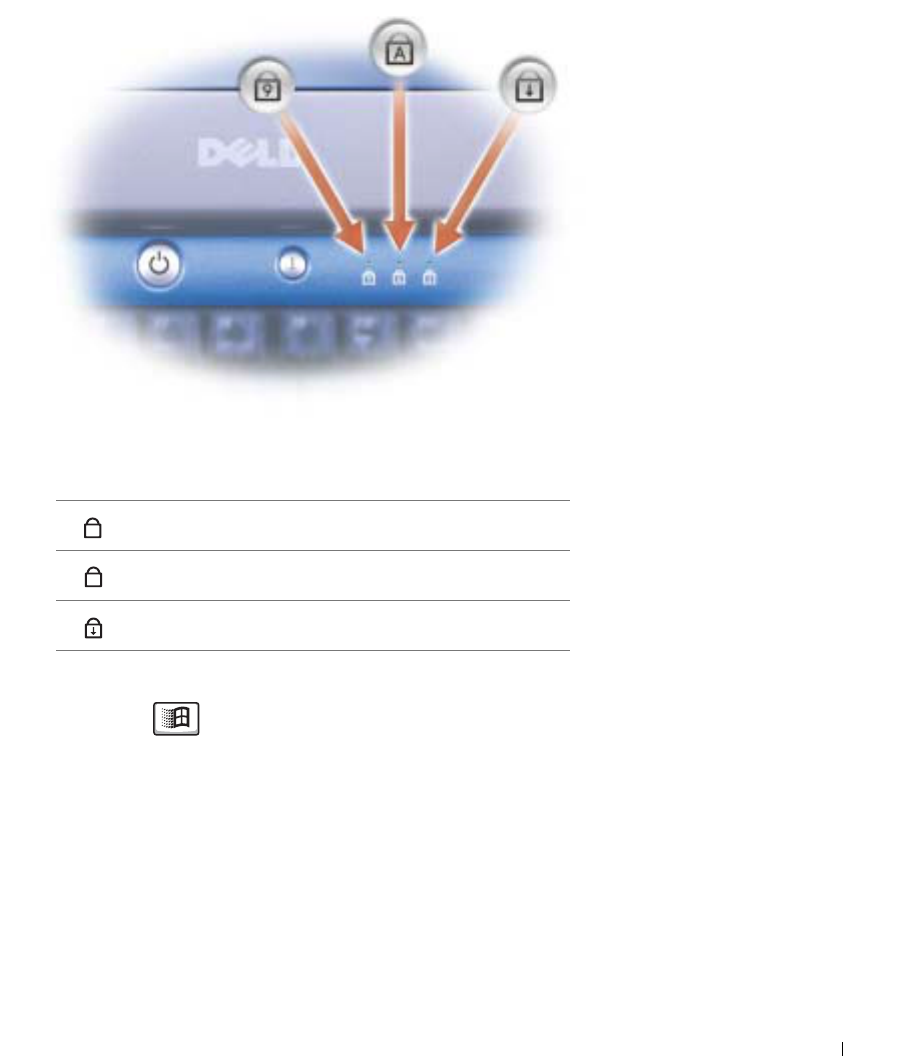
A Tour of Your Computer 21
KEYBOARD STATUS LIGHTS
The green lights located above the keyboard indicate the following:
KEYBOARD —The keyboard includes a numeric keypad as well as the Microsoft®
Windows® logo key . For information on supported keyboard shortcuts, see
page 49.
SPEAKERS —To adjust the volume of the integrated speakers, press the volume
control keyboard shortcuts. For more information, see page 50.
Turns on when the numeric keypad is enabled.
Turns on when Caps Lock is enabled.
Turns on when the scroll lock function is enabled.
9
A
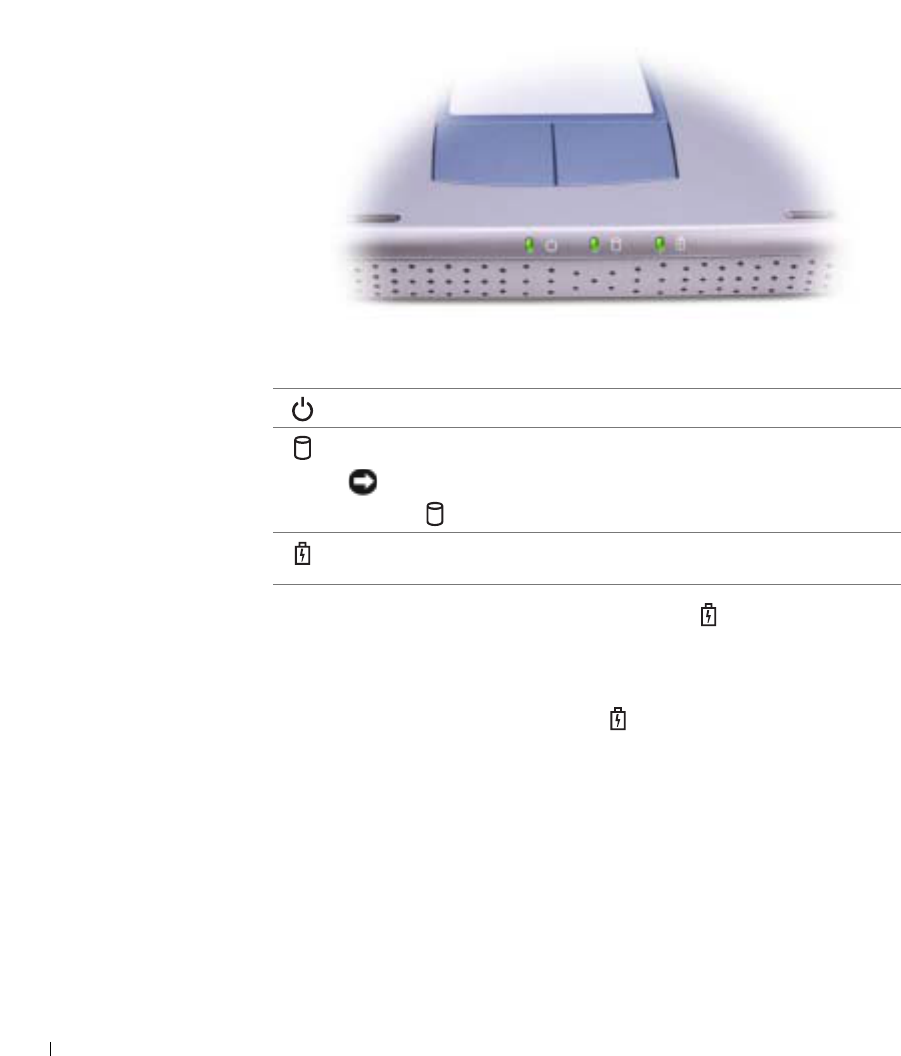
22 A Tour of Your Computer
www.dell.com | support.dell.com
DEVICE STATUS LIGHTS
If the computer is connected to an electrical outlet, the light operates as
follows:
– Solid green: The battery is fully charged.
– Flashing green: The battery is charging.
If the computer is running on a battery, the light operates as follows:
– Off: The battery is adequately charged (or the computer is turned off).
– Flashing orange: The battery charge is low.
– Solid orange: The battery charge is critically low.
TOUCH PAD BUTTONS —Touch pad buttons provide the functionality of a
mouse. See page 50 for more information.
TOUCH PAD —The touch pad and touch pad buttons provide the functionality of
a mouse. See page 50 for more information.
Turns on when you turn on the computer.
Turns on when the computer reads or writes data.
NOTICE: To avoid loss of data, never turn off the computer while
the light is flashing.
Turns on steadily or blinks when the computer is in a power management
mode. It also blinks to indicate battery charge status.
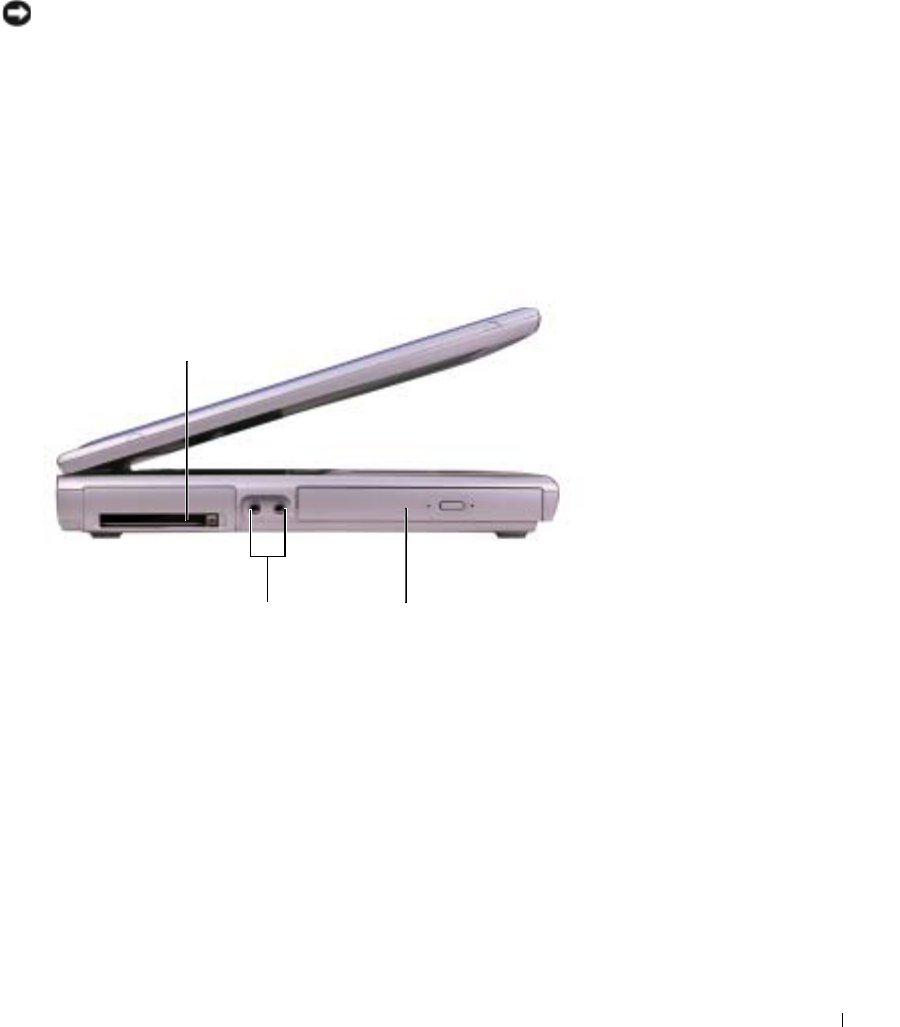
A Tour of Your Computer 23
POWER BUTTON —Press the power button to turn on the computer or to enter
or exit a power management mode. For more information, see "Power Management"
in the Tell Me How help file. To access the help file, see page 74.
NOTICE: To avoid losing data, turn off your computer by performing a
Windows shutdown rather than by pressing the power button (see page 39).
If the computer stops responding, press and hold the power button until the
computer turns off completely (which may take several seconds).
DELL™ ACCESSDIRECT™ BUTTON —Press this button to launch a frequently
used program, such as support and educational tools. You can reprogram the button
to launch a program of your choice. For more information, see page 48.
Left Side View
PC CARD SLOT —Supports one PC Card, such as a modem or network adapter.
The computer ships with a plastic blank installed in the slot. For more information,
see "Using PC Cards" in the Tell Me How help file. To access the help file, see
page 74.
PC Card slot
audio connectors (2) CD or DVD drive
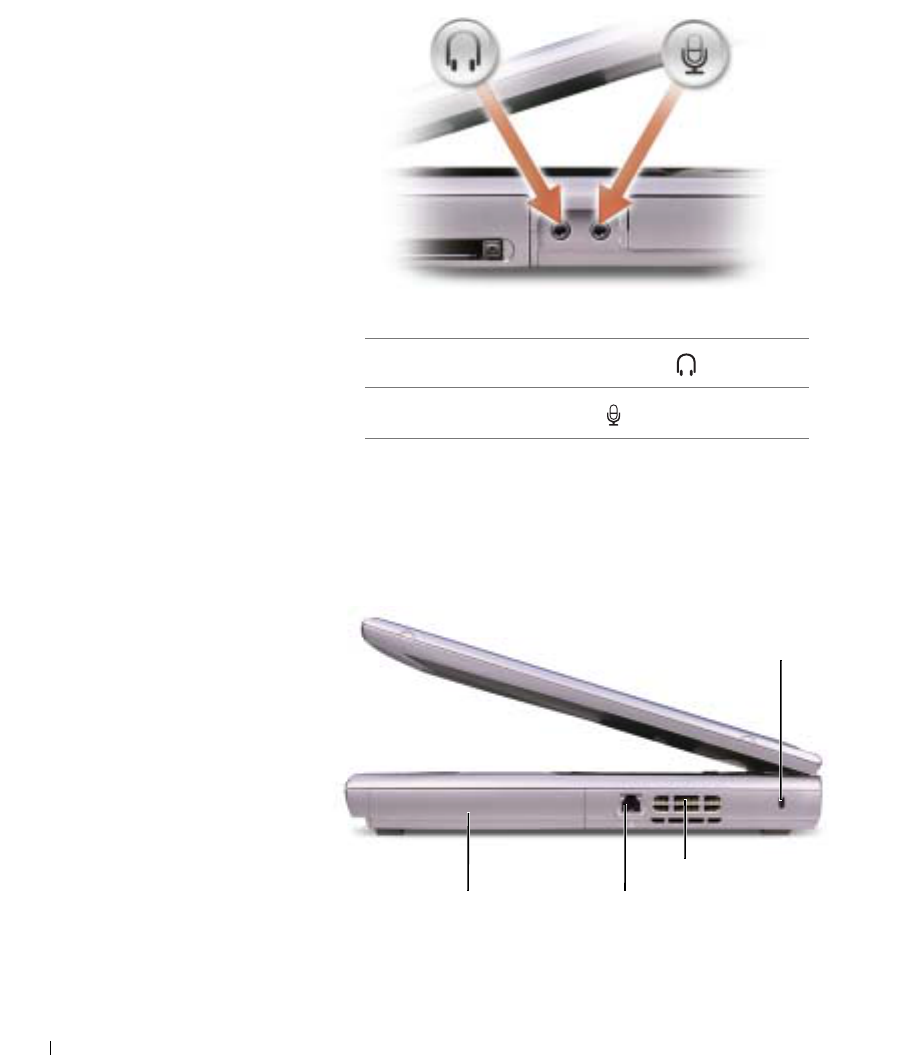
24 A Tour of Your Computer
www.dell.com | support.dell.com
AUDIO CONNECTORS
CD OR DVD DRIVE —Accommodates a CD drive, DVD drive, CD-RW drive,
or CD-RW/DVD combo drive.
Right Side View
Attach headphones or speakers to the connector.
Attach a microphone to the connector.
battery/battery bay modem connector
air vents
security cable slot
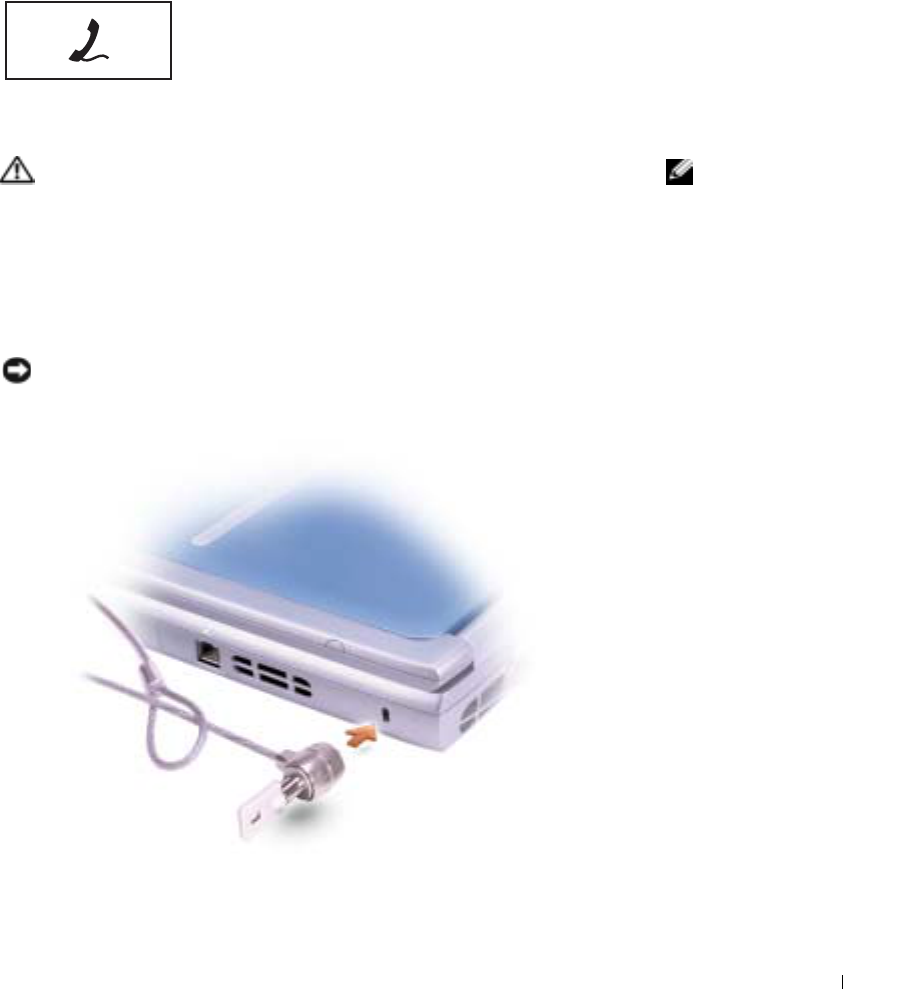
A Tour of Your Computer 25
BATTERY/BATTERY BAY —When a battery is installed, you can use the
computer without connecting the computer to an electrical outlet. See page 41.
MODEM CONNECTOR
AIR VENTS —The computer uses an internal fan to create airflow through the
vents, which prevents the computer from overheating.
NOTE: The fan runs
constantly, and fan speed
may vary depending on
usage. Fan noise is
normal and does not
indicate a problem with
the fan or the computer.
CAUTION: Do not block, push objects into, or allow dust to
accumulate in the air vents. Do not store your computer in a low-
airflow environment, such as a closed briefcase, while it is
running. Restricting the airflow can damage the computer or
cause a fire.
SECURITY CABLE SLOT —Lets you attach a commercially available antitheft
device to the computer. For more information, see the instructions included with
the device.
NOTICE: Before you buy an antitheft device, ensure that it will work with the
security cable slot.
Connect the telephone line to the modem connector.
For information on using the modem, see the online modem
documentation supplied with your computer.
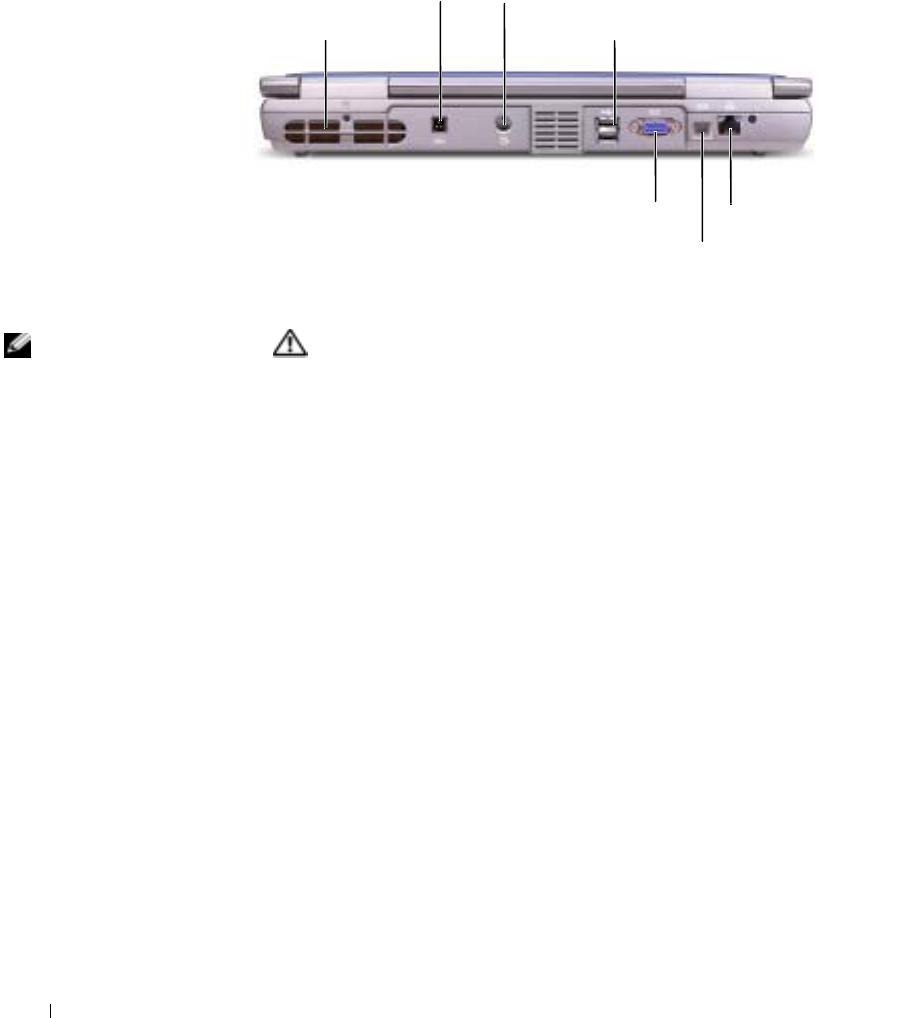
26 A Tour of Your Computer
www.dell.com | support.dell.com
Back View
AIR VENTS —The computer uses an internal fan to create airflow through the
vents, which prevents the computer from overheating.
NOTE: The fan runs
constantly, and fan speed
may vary depending on
usage. Fan noise is
normal and does not
indicate a problem with
the fan or the computer.
CAUTION: Do not block, push objects into, or allow dust to
accumulate in the air vents. Do not store your computer in a low-
airflow environment, such as a closed briefcase, while it is
running. Restricting the airflow can damage the computer or
cause a fire.
USB connectors (2)
S-video TV-out connector
network connector
video connector
AC adapter connector
air vents
IEEE 1394 connector
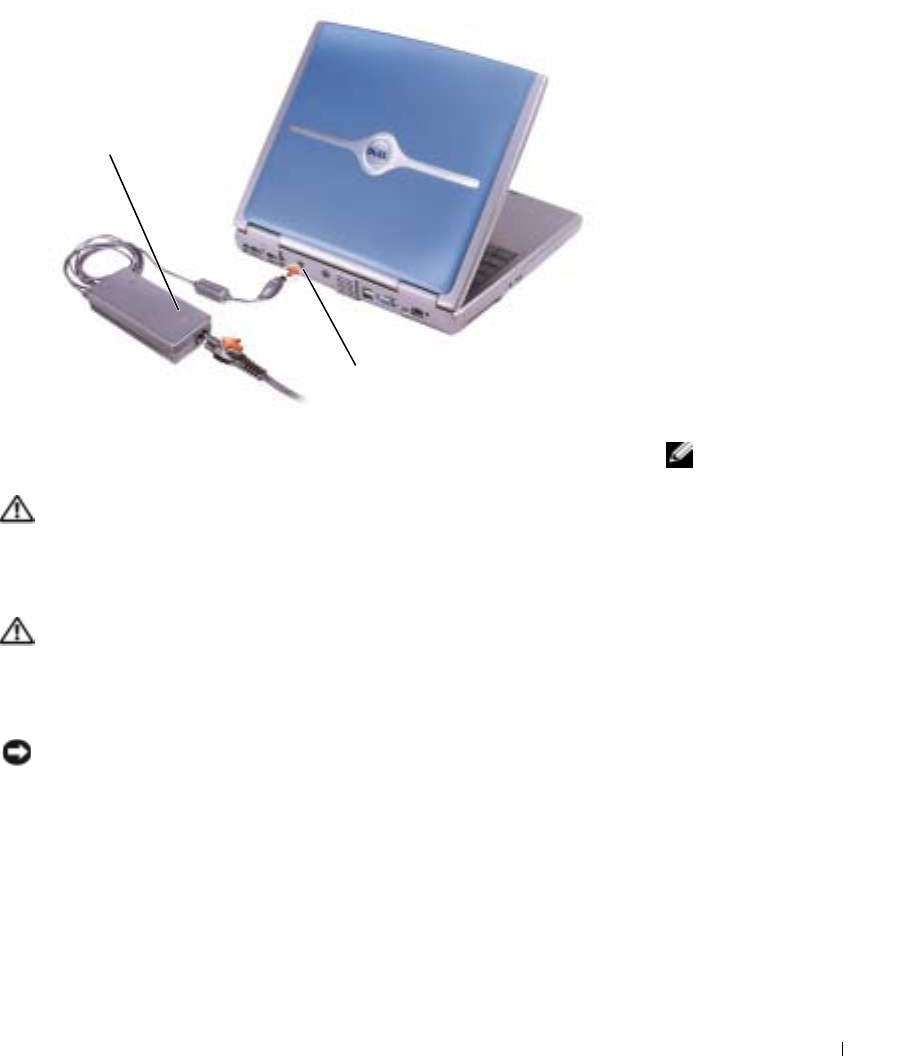
A Tour of Your Computer 27
AC ADAPTER CONNECTOR —Attach an AC adapter to the computer.
NOTE: Use only the
90-watt AC adapter that
came with your computer.
The AC adapter converts AC power to the DC power required by the computer. You
can connect the AC adapter with your computer turned either on or off.
CAUTION: The AC adapter works with electrical outlets
worldwide. However, power connectors and power strips vary
among countries. Using an incompatible cable or improperly
connecting the cable to the power strip or electrical outlet may
cause fire or equipment damage.
CAUTION: Place the AC adapter in a ventilated area, such as a
desk top or on the floor, when you use it to run the computer or to
charge the battery. Do not cover the AC adapter with papers or
other items that will reduce cooling; also, do not use the AC
adapter inside a carrying case.
NOTICE: When you disconnect the AC adapter cable from the computer,
grasp the connector, not the cable itself, and pull firmly but gently to avoid
damaging the cable.
AC adapter connector
AC adapter
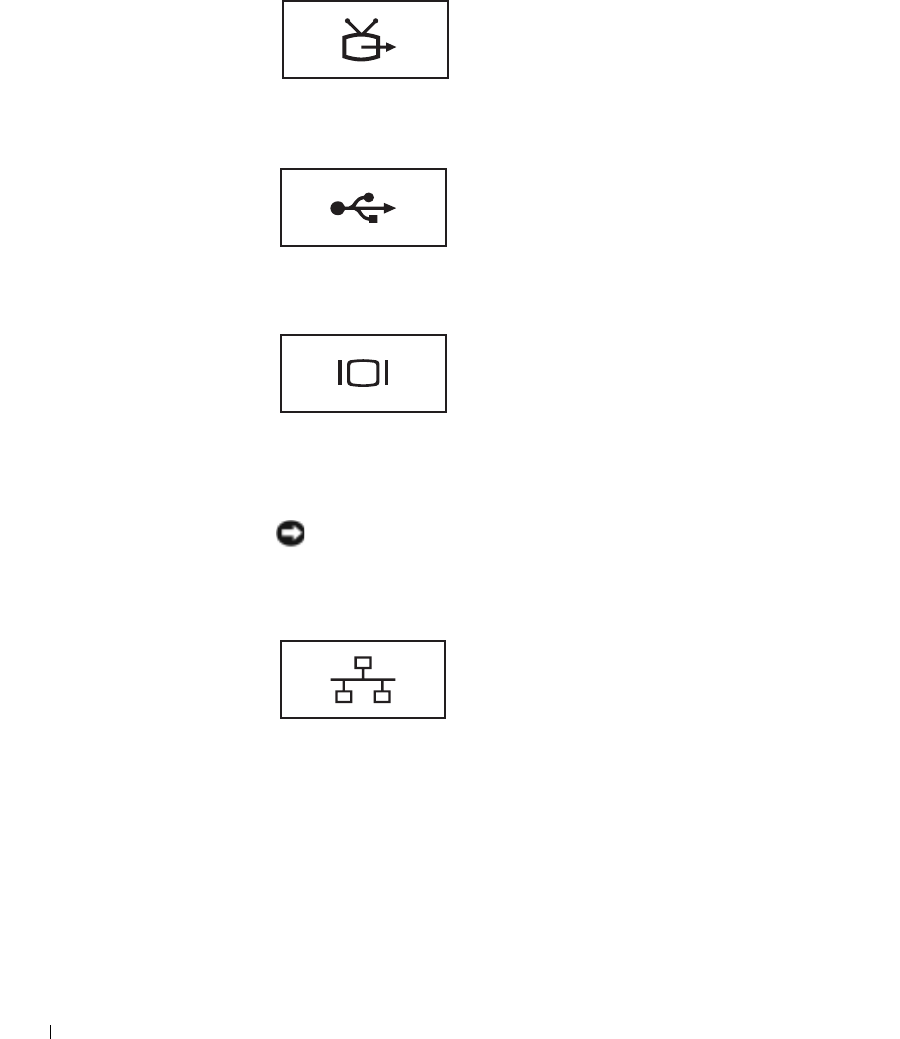
28 A Tour of Your Computer
www.dell.com | support.dell.com
S-VIDEO TV-OUT CONNECTOR
USB CONNECTORS
VIDEO CONNECTOR
IEEE 1394 CONNECTOR —Use to attach devices supporting IEEE 1394 high-
speed transfer rates, such as some digital video cameras.
NETWORK CONNECTOR
NOTICE: The network connector is slightly larger than the modem connector.
To avoid damaging the computer, do not plug a telephone line into the network
connector.
Connects your computer to a TV. For more information, see
page 61.
Connects USB devices, such as a mouse, keyboard, or printer.
Connects an external monitor. For more information, see
"Using the Display" in the Tell Me How help file. To access the
help file, see page 74.
Connects the computer to a network. The lights next to the
connector indicate activity for both wired and wireless
network communications.
For information on using the network adapter, see the online
network adapter documentation supplied with your
computer.
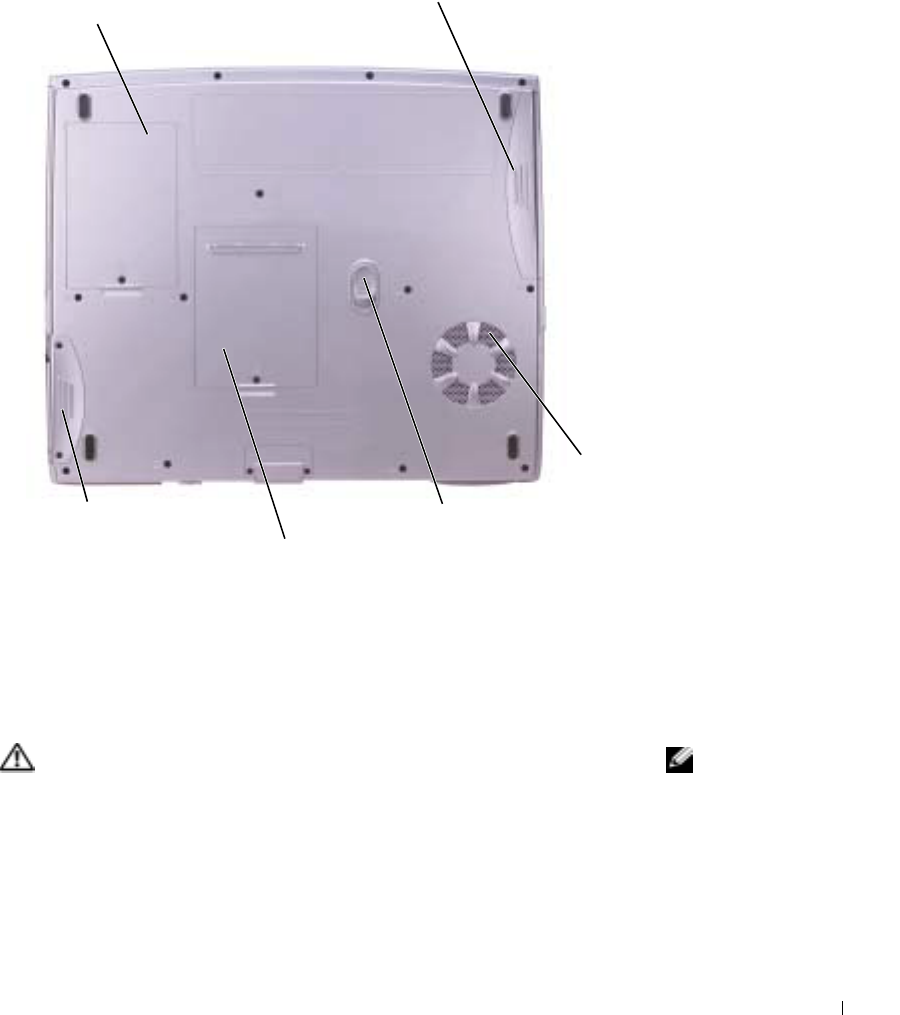
A Tour of Your Computer 29
Bottom View
MODEM/MINI PCI CARD COVER —Covers the compartment that contains
the modem and Mini PCI card. See page 96.
BATTERY/BATTERY BAY —When a battery is installed, you can use the
computer without connecting the computer to an electrical outlet. See page 41.
AIR VENTS —The computer uses an internal fan to create airflow through the
vents, which prevents the computer from overheating.
NOTE: The fan runs
constantly, and fan speed
may vary depending on
usage. Fan noise is
normal and does not
indicate a problem with
the fan or the computer.
CAUTION: Do not block, push objects into, or allow dust to
accumulate in the air vents. Do not store your computer in a low-
airflow environment, such as a closed briefcase, while it is
running. Restricting the airflow can damage the computer or
cause a fire.
memory module cover
battery latch release
modem/Mini PCI
card cover battery/battery bay
hard drive
air vent

32 Setting Up Your Computer
www.dell.com | support.dell.com
Connecting to the Internet
NOTE: ISPs and ISP
offerings vary by country. To connect to the Internet, you need a modem or network connection and
an Internet service provider (ISP), such as AOL or MSN. Your ISP will offer
one or more of the following Internet connection options:
• Dial-up connections that provide Internet access through a phone line.
Dial-up connections are considerably slower than DSL and cable
modem connections.
• DSL connections that provide high-speed Internet access through
your existing phone line. With a DSL connection, you can access the
Internet and use your phone on the same line simultaneously.
• Cable modem connections that provide high-speed Internet access
through your local cable TV line.
If you are using a dial-up connection, connect a telephone line to the
modem connector on your computer and to the telephone wall jack before
you set up your Internet connection. If you are using a DSL or cable modem
connection, contact your ISP for setup instructions.
Setting Up Your Internet Connection
To set up an AOL or MSN connection:
1Save and close any open files, and exit any open programs.
2Double-click the MSN Explorer or AOL icon on the Windows®
desktop.
3Follow the instructions on the screen to complete the setup.
If you do not have an MSN Explorer or AOL icon on your desktop or if you
want to set up an Internet connection with a different ISP:
1Save and close any open files, and exit any open programs.
2Click the Start button and click Internet Explorer.
The New Connection Wizard appears.
3Click Connect to the Internet.
4In the next window, click the appropriate option:
• If you do not have an ISP and want to select one, click Choose
from a list of Internet service providers (ISPs).

Setting Up Your Computer 33
• If you have already obtained setup information from your ISP but
you did not receive a setup CD, click Set up my connection
manually.
• If you have a CD, click Use the CD I got from an ISP.
5Click Next.
If you selected Set up my connection manually, continue to step 6.
Otherwise, follow the instructions on the screen to complete the
setup.
NOTE: If you do not
know which type of
connection to select,
contact your ISP.
6Click the appropriate option under How do you want to connect to
the Internet?, and then click Next.
7Use the setup information provided by your ISP to complete the setup.
If you are having problems connecting to the Internet, see "Modem and
Internet Connection Problems." If you cannot connect to the Internet but
have successfully connected in the past, the ISP might have a service
outage. Contact your ISP to check the service status, or try connecting again
later.
Modem and Internet Connection
Problems
NOTICE: Connect the modem to an analog telephone wall jack only.
Connecting the modem to a digital telephone network damages the modem.
NOTICE: Modem and network connectors look similar. Do not plug a
telephone line into the network connector.
NOTE: If you can
connect to your Internet
service provider (ISP),
your modem is
functioning properly. If
you are sure that your
modem is working
properly and you still
experience problems,
contact your ISP.
CHECK THE TELEPHONE WALL JACK —Disconnect the telephone line from
the modem and connect it to a telephone. Listen for a dial tone. Ensure that you
have touchtone telephone service. Try connecting the modem to a different
telephone wall jack.
Slow connection speeds can be caused by telephone noise as well as by telephone
line or network conditions. Contact your telephone company or network
administrator for more information.
CONNECT THE MODEM DIRECTLY TO THE TELEPHONE WALL JACK —If
you have other telephone devices sharing the line, such as an answering machine, fax
machine, surge protector, or line splitter, then bypass them and use the telephone
line to connect the modem directly to the telephone wall jack.
CHECK THE CONNECTION —Verify that the telephone line is connected to the
modem.

34 Setting Up Your Computer
www.dell.com | support.dell.com
CHECK THE TELEPHONE LINE —Try using a different telephone line. If you
are using a line that is 3 m (10 ft) or more in length, try a shorter one.
IRREGULAR DIAL TONE —If you have voice mail service, you might hear an
irregular dial tone when you have messages. Contact your telephone company for
instructions on restoring a dial tone.
TURN OFF CALL WAITING (CATCH-PHONE)—See your telephone directory
for instructions on deactivating this feature. Then adjust the dial-up networking
connection properties.
1Click the Start button and click Control Panel.
2Click Printers and Other Hardware, click Phone and Modem Options, click the
Dialing Rules tab, and then click Edit....
3In the Edit Location window, ensure that To disable call waiting, dial: is
checked, and then select the proper code as listed in your telephone directory.
4Click Apply and click OK.
5Close the Phone and Modems Options window.
6Close the Control Panel window.
VERIFY THAT THE MODEM IS COMMUNICATING WITH WINDOWS —
1Click the Start button and click Control Panel.
2Click Printers and Other Hardware and click Phone and Modem Options.
3Click the Modems tab.
4Click the COM port for your modem.
5Click Properties, click the Diagnostics tab, and then click Query Modem to
verify that the modem is communicating with Windows.
If all commands receive responses, the modem is operating properly.
E-Mail Problems
ENSURE THAT YOU ARE CONNECTED TO THE INTERNET —With the
Outlook Express e-mail program open, click File. If Work Offline has a check mark
next to it, click the check mark to remove it and connect to the Internet.

Setting Up Your Computer 35
Transferring Information to a New
Computer
The Microsoft® Windows® XP operating system provides a Files and
Settings Transfer wizard to move data from the source computer to the new
computer. You can move data such as:
•E-mails
• Toolbar settings
• Window sizes
• Internet bookmarks
You can transfer the data to the new computer over a network connection,
or you can store it on a removable medium, such as a writable CD or floppy
disk.
To prepare the new computer for the file transfer:
1Click the Start button, point to All Programs→ Accessories→ System
Tools, and then click Files and Settings Transfer Wizard.
2When the Files and Settings Transfer Wizard welcome screen
appears, click Next.
3On the Which computer is this? screen, click New Computer and
click Next.
4On the Do you have a Windows XP CD? screen, click I will use the
wizard from the Windows XP CD and click Next.
5When the Now go to your old computer screen appears, go to your old
or source computer. Do not click Next at this time.
To copy data from the old computer:
1On the old computer, insert the Windows XP Operating System CD.
2On the Welcome to Microsoft Windows XP screen, click Perform
additional tasks.
3Under What do you want to do?, click Transfer files and settings.
4On the Files and Settings Transfer Wizard welcome screen, click Next.

36 Setting Up Your Computer
www.dell.com | support.dell.com
5On the Which computer is this? screen, click Old Computer and click
Next.
6On the Select a transfer method screen, click the transfer method you
prefer.
7On the What do you want to transfer? screen, select the items you
want to transfer and click Next.
After the information has been copied, the Completing the
Collection Phase screen appears.
8Click Finish.
To transfer data to the new computer:
1On the Now go to your old computer screen on the new computer,
click Next.
2On the Where are the files and settings? screen, select the method you
chose for transferring your settings and files and click Next.
The wizard reads the collected files and settings and applies them to
your new computer.
When all of the settings and files have been applied, the Finished
screen appears.
3Click Finished and restart the new computer.
Setting Up a Printer
NOTICE: Complete the operating system setup before you connect a printer to
the computer.
See the documentation that came with the printer for setup information,
including how to:
• Obtain and install updated drivers.
• Connect the printer to the computer.
• Load paper and install the toner or ink cartridge.
• Contact the printer manufacturer for technical assistance.
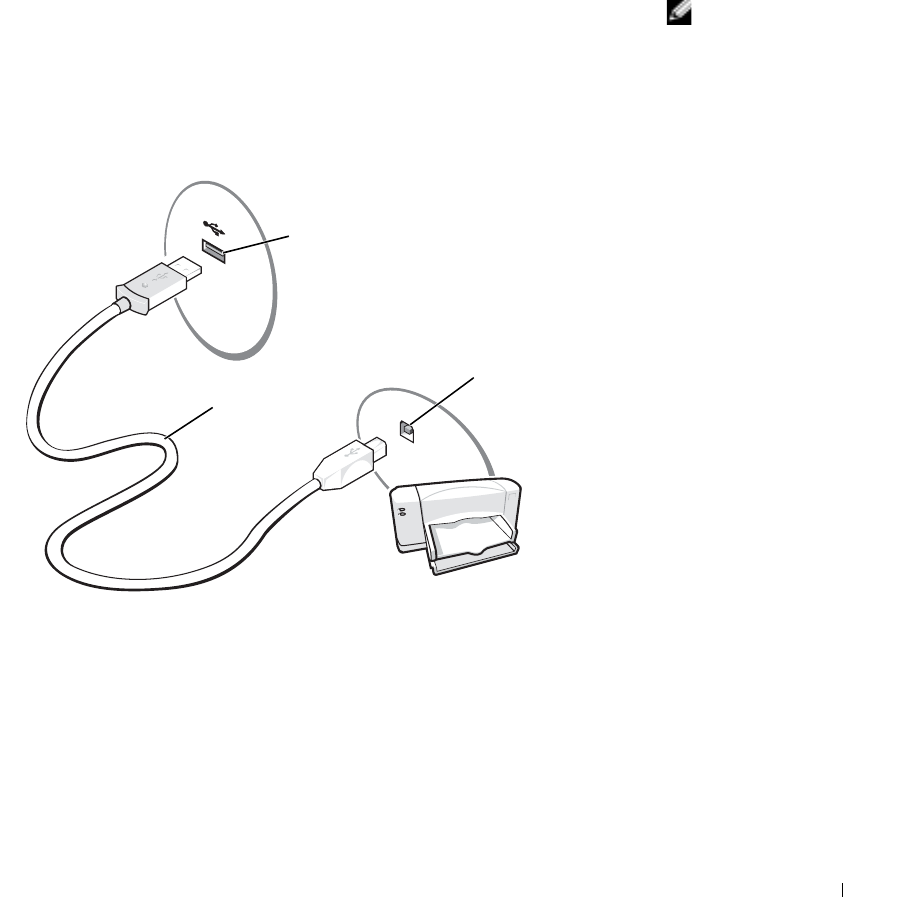
Setting Up Your Computer 37
Printer Cable
Your printer may not come with a printer cable, so if you purchase a cable
separately, ensure that it is compatible with your printer. If you purchased a
printer cable at the same time you purchased your computer, the cable may
arrive in the computer box.
Connecting a USB Printer
NOTE: You can connect
USB devices while the
computer is turned on.
1Complete the operating system setup if you have not already done so.
2Install the printer driver if necessary. See the documentation that
came with your printer.
3Attach the USB printer cable to the USB connectors on the computer
and the printer. The USB connectors fit only one way.
Printer Problems
CHECK THE PRINTER CABLE CONNECTIONS —Ensure that the printer cable
is properly connected to the computer (see page 37).
TEST THE ELECTRICAL OUTLET —Ensure that the electrical outlet is working
by testing it with another device, such as a lamp.
USB printer
cable
USB connector on
computer
USB connector
on printer

38 Setting Up Your Computer
www.dell.com | support.dell.com
ENSURE THAT THE PRINTER IS TURNED ON —See the documentation
supplied with the printer.
VERIFY THAT WINDOWS® RECOGNIZES THE PRINTER —
1Click the Start button.
2Click Control Panel.
3Click Printers and Other Hardware.
4Click View installed printers or fax printers. If the printer model is listed, right-
click the printer icon.
5Click Properties and click the Ports tab. Ensure that the Print to the following
port(s): setting is LPT1 (Printer Port).
REINSTALL THE PRINTER DRIVER —See page 83.
Power Protection Devices
Several devices are available to protect against power fluctuations and
failures:
• Surge protectors
• Line conditioners
• Uninterruptible power supplies (UPS)
Surge Protectors
Surge protectors and power strips equipped with surge protection help to
prevent damage to your computer from voltage spikes that can occur during
electrical storms or following power interruptions. The level of protection is
usually commensurate with the cost of the surge protector. Some surge
protector manufacturers include warranty coverage for certain types of
damage. Carefully read the device warranty when choosing a surge
protector. A device with a higher joule rating offers more protection.
Compare joule ratings to determine the relative effectiveness of different
devices.
NOTICE: Most surge protectors do not protect against power fluctuations or
power interruptions caused by nearby lightning strikes. When lightning occurs
in your area, disconnect the telephone line from the telephone wall jack and
disconnect your computer from the electrical outlet.
Many surge protectors have a telephone jack for modem protection. See the
surge protector documentation for modem connection instructions.

Setting Up Your Computer 39
NOTICE: Not all surge protectors offer network adapter protection.
Disconnect the network cable from the network wall jack during electrical
storms.
Line Conditioners
NOTICE: Line conditioners do not protect against power interruptions.
Line conditioners are designed to maintain AC voltage at a fairly constant
level.
Uninterruptible Power Supplies
NOTICE: Loss of power while data is being saved to the hard drive may result
in data loss or file damage.
NOTE: To ensure
maximum battery
operating time, connect
only your computer to a
UPS. Connect other
devices, such as a printer,
to a separate power strip
that provides surge
protection.
A UPS protects against power fluctuations and interruptions. UPS devices
contain a battery that provides temporary power to connected devices when
AC power is interrupted. The battery charges while AC power is available.
See the UPS manufacturer documentation for information on battery
operating time and to ensure that the device is approved by Underwriters
Laboratories (UL).
Turning Off Your Computer
NOTICE: To avoid losing data, turn off your computer by performing a
Microsoft® Windows® operating system shutdown, as described next, rather
than by pressing the power button.
NOTE: As an alternative
to turning off your
computer, you can set
your computer to enter
standby or hibernate
mode. For more
information, see the
Tell
Me How
help file. To
access the help file, see
page 74.
1Save and close any open files, exit any open programs, click the Start
button, and then click Turn Off Computer.
2In the Turn off computer window, click Turn off.
The computer turns off after the shutdown process finishes.

40 Setting Up Your Computer
www.dell.com | support.dell.com
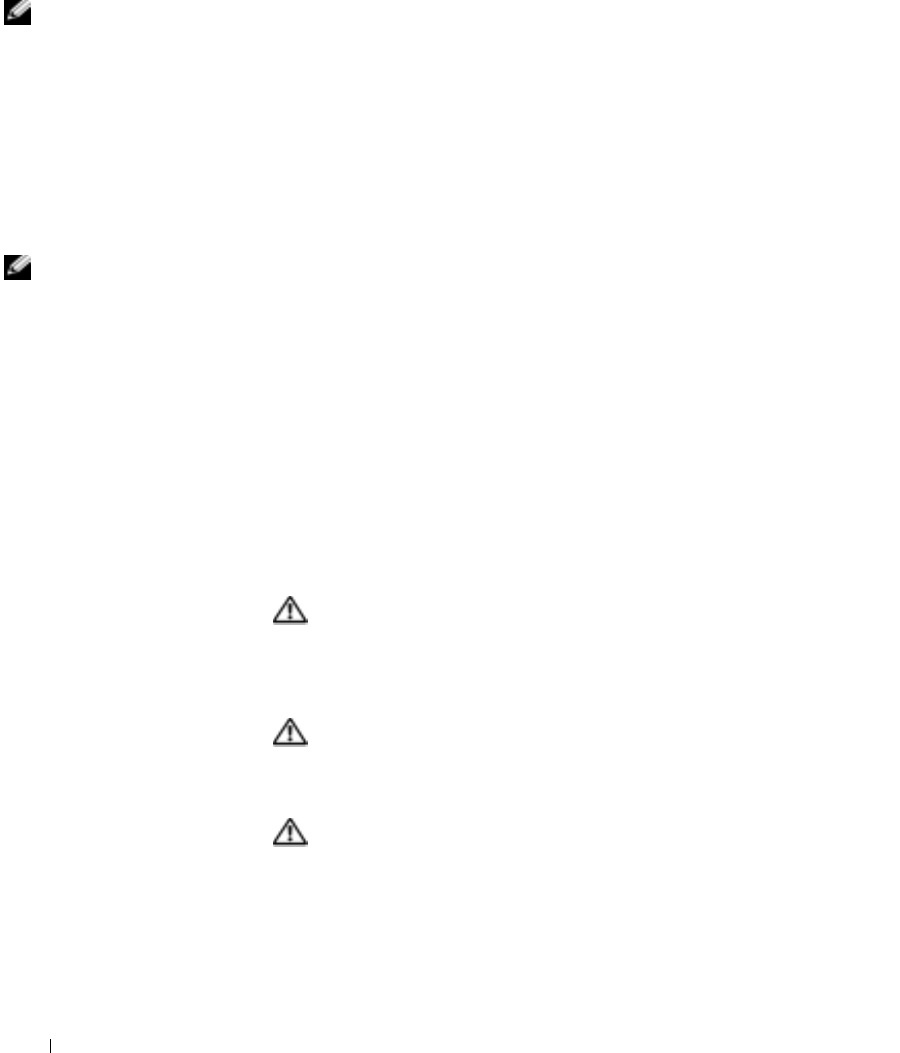
42 Using a Battery
www.dell.com | support.dell.com
Battery Performance
NOTE: Batteries for
portable computers are
covered only during the
initial one-year period of
the limited warranty for
your computer. For more
information about the
Dell warranty for your
computer, see page 143.
Use a battery to power the computer when it is not connected to an
electrical outlet. One battery is supplied as standard equipment in the
battery bay.
Battery operating time varies depending on operating conditions. With
average usage, you may expect from 1.5 to 3 hours from a single, fully
charged battery.
Operating time may be significantly reduced when you perform operations
including, but not limited to, the following:
NOTE: It is
recommended that you
connect your computer to
an electrical outlet when
writing to a CD.
• Using optical drives, especially DVD and CD-RW drives.
• Using wireless communications devices, PC Cards, or USB devices.
• Using high-brightness display settings.
• Using 3D screen savers or other power-intensive programs such as 3D
games and engineering programs.
• Running the computer in maximum performance mode. See "Power
Management" in the Tell Me How help file for more information. To
access the help file, see page 74.
You can set power management options to alert you when the battery charge
is low. You can also set power modes to optimize power consumption and
battery charge time. See page 120 for additional information.
CAUTION: Using an incompatible battery may increase the risk of
fire or explosion. Replace the battery only with a compatible
battery purchased from Dell. The lithium-ion battery is designed
to work with your Dell™ computer. Do not use a battery from
other computers with your computer.
CAUTION: Do not dispose of batteries with household waste.
When your battery no longer holds a charge, call your local waste
disposal or environmental agency for advice on disposing of a
lithium-ion battery. See "Battery Disposal" on page 17.
CAUTION: Misuse of the battery may increase the risk of fire or
chemical burn. Do not puncture, incinerate, disassemble, or
expose the battery to temperatures above 65°C (149°F). Keep the
battery away from children. Handle damaged or leaking batteries
with extreme care. Damaged batteries may leak and cause
personal injury or equipment damage.

Using a Battery 43
Checking the Battery Charge
The Microsoft® Windows® power meter window and icon, the battery
charge gauge, and the low-battery warning provide information on the
battery charge.
Power Meter
The Windows power meter indicates the remaining battery charge. To
check the power meter, double-click the icon on the taskbar. For more
information on the Power Meter tab, see "Power Management" in the Te l l
Me How help file. To access the help file, see page 74.
If the computer is connected to an electrical outlet, a icon appears.
Low-Battery Warning
NOTICE: To avoid losing or corrupting data, save your work immediately
after a low-battery warning. Then connect the computer to an electrical outlet.
If the battery runs completely out of power, hibernate mode begins
automatically.
A pop-up window warns you when the battery charge is approximately
90 percent depleted. For more information on low-battery alarms, see
"Power Management" in the Tell Me How help file. To access the help file,
see page 74.

44 Using a Battery
www.dell.com | support.dell.com
Charging the Battery
NOTE: The AC adapter
charges a completely
discharged battery in
approximately 3 hours
with the computer turned
off. Charge time is
significantly longer if the
computer is on and
running at high processor
speeds and system activity
levels. Running the
computer at high system
activity levels for
extended periods of time
may prevent the battery
from charging.
When you connect the computer to an electrical outlet or install a battery
while the computer is connected to an electrical outlet, the computer
checks the battery charge and temperature. If necessary, the AC adapter
then charges the battery and maintains the battery charge.
If the battery is hot from being used in your computer or being in a hot
environment, the battery may not charge when you connect the computer
to an electrical outlet.
The battery is too hot to start charging if the light flashes alternately
green and orange. Disconnect the computer from the electrical outlet and
allow the computer and the battery to cool to room temperature. Then
connect the computer to an electrical outlet to continue charging the
battery.
NOTE: You can leave the
battery in the computer as
long as you like. The
battery internal circuitry
prevents the battery from
overcharging.
For more information on resolving problems with a battery, see "Power
Management" in the Tell Me How help file. To access the help file, see
page 74.
Removing a Battery
CAUTION: Before performing these procedures, disconnect the
modem from the telephone wall jack.
1Ensure that the computer is turned off or connected to an electrical
outlet.
2Slide and hold the battery latch.
3Remove the battery.
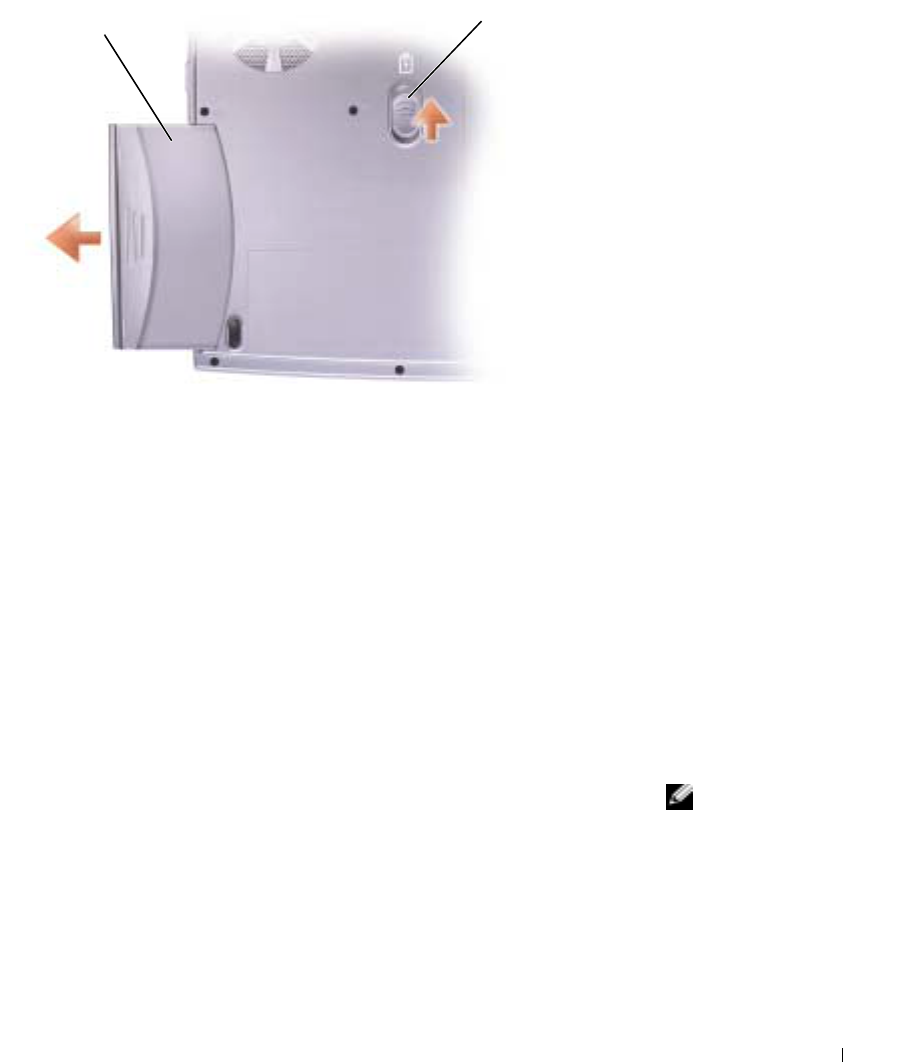
Using a Battery 45
Installing a Battery
Slide the battery into the battery bay until the latch clicks.
Storing a Battery
Remove the battery when you store your computer for an extended period
of time. A battery discharges during prolonged storage. After a long storage
period, recharge the battery fully before you use it.
Battery and Power Problems
NOTE: See the
Tell Me
How
help file for
information on standby
mode. To access the help
file, see page 74.
CHECK THE POWER LIGHT —When the power light is lit or blinking, the
computer has power. If the power light is blinking, the computer is in standby
mode—press the power button to exit standby mode. If the light is off, press the
power button to turn on the computer. If the computer does not turn on, press and
hold the power button for several seconds.
battery latch
battery

46 Using a Battery
www.dell.com | support.dell.com
CHARGE THE BATTERY —The battery charge may be depleted.
1Reinstall the battery.
2Use the AC adapter to connect the computer to an electrical outlet.
3Turn on the computer.
CHECK THE BATTERY STATUS LIGHT —If the battery status light flashes
orange or is a steady orange, the battery charge is low or depleted. Connect the
computer to an electrical outlet.
If the battery status light flashes green and orange, the battery is too hot to charge.
Turn off the computer (see page 39), disconnect the computer from the electrical
outlet, and then let the battery and computer cool to room temperature.
If the battery status light rapidly flashes orange, the battery may be defective.
Contact Dell (see page 122).
TEST THE ELECTRICAL OUTLET —Ensure that the electrical outlet is working
by testing it with another device, such as a lamp.
CHECK THE AC ADAPTER —Check the AC adapter cable connections. If the
AC adapter has a light, ensure that the light is on.
CONNECT THE COMPUTER DIRECTLY TO AN ELECTRICAL OUTLET —
Bypass power protection devices, power strips, and the extension cable to verify that
the computer turns on.
ELIMINATE POSSIBLE INTERFERENCE —Turn off nearby fans, fluorescent
lights, halogen lamps, or other appliances.
ADJUST THE POWER PROPERTIES —See the Tell Me How help file or search
for the keyword standby in the Help and Support Center. To access help, see page 74.
RESEAT THE MEMORY MODULES —If the computer power light turns on but
the display remains blank, reseat the memory modules (see page 94).
If the battery is not charging
SHUT DOWN THE COMPUTER —Charge time is significantly longer if the
computer is on and running at high processor speeds and system activity levels.
Running the computer at high system activity levels for extended periods of time
may prevent the battery from charging.
If battery life is short
SEE "BATTERY PERFORMANCE" ON PAGE 42 — Operating time may be
significantly reduced under certain conditions.
OPTIMIZE PROCESSOR PERFORMANCE AND POWER CONSUMPTION —
See page 120.
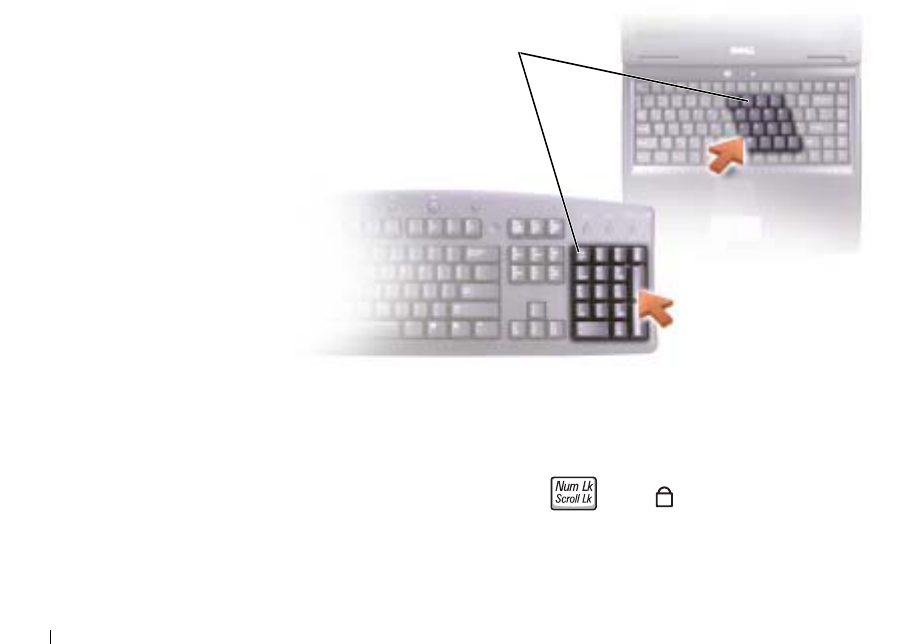
48 Using the Keyboard and Touch Pad
www.dell.com | support.dell.com
Dell™ AccessDirect™ Button
Press this button to launch a frequently used program, such as support and
educational tools or your default Internet browser.
Reprogramming the Button
To change the reprogrammable button settings or to find information on
using the button:
1Click the Start button→ Control Panel→ Printers and Other
Hardware→ Keyboard icon.
2Click the AccessDirect tab.
3Click the Help button and follow the instructions on the screen.
Numeric Keypad
The numeric keypad functions like the numeric keypad on an external
keyboard. Each key on the keypad has multiple functions. The keypad
numbers and symbols are marked in blue on the right of the keypad keys.
• To enable the keypad, press . The light indicates that the
keypad is active.
numeric keypad
9
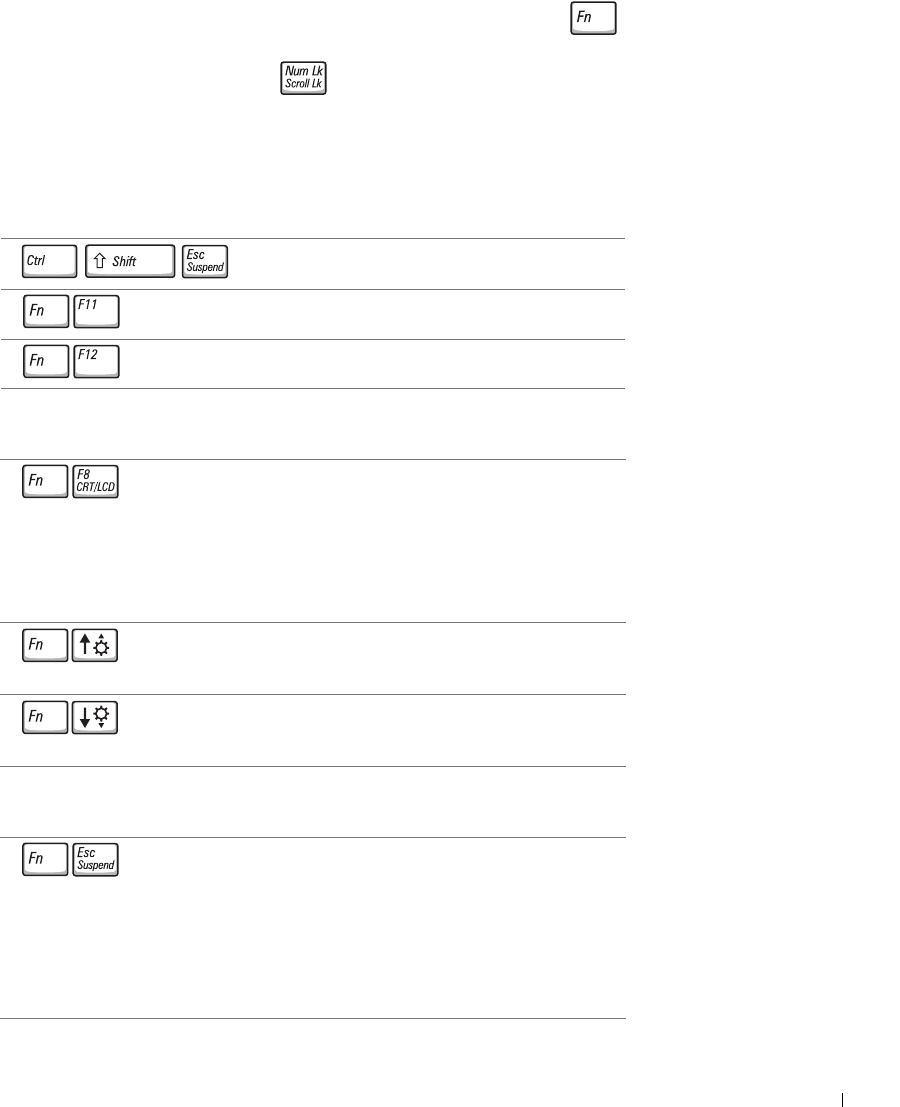
Using the Keyboard and Touch Pad 49
• To use the numeric function when the keypad is enabled, press
and the desired key.
• To disable the keypad, press again.
Keyboard Shortcuts
System Functions
Display Functions
Power Management
Opens the Task Manager window
Enables and disables the numeric keypad
Enables and disables the scroll lock
Switches the video image to the next display option.
The options include the integrated display, an external
monitor, and both displays simultaneously.
NOTE: If the computer is connected to a television,
you must enable the television through the Windows
display settings (see page 61).
Increases brightness on the integrated display only
(not on an external monitor).
Decreases brightness on the integrated display only
(not on an external monitor).
Activates a power management mode. You can
reprogram this keyboard shortcut to activate a
different power management mode using the
Advanced tab in the Power Options Properties
window. See "Power Management" in the Tell Me How
help file for more information. To access the help file,
see page 74.
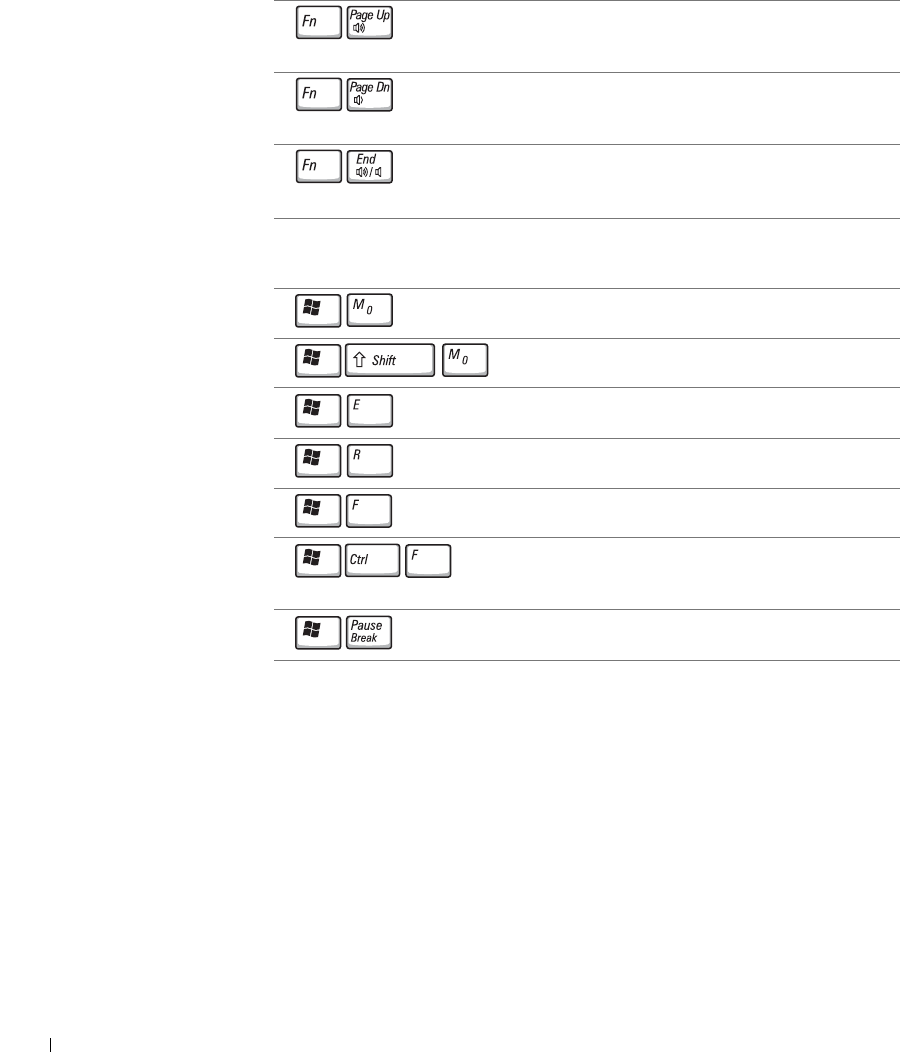
50 Using the Keyboard and Touch Pad
www.dell.com | support.dell.com
Speaker Functions
Microsoft® Windows® Logo Key Functions
To adjust keyboard operation, such as the character repeat rate, click the
Start button→ Control Panel→ Printers and Other Hardware→ Keyboard.
Follow the instructions on the screen.
Touch Pad
The touch pad detects the pressure and movement of your finger to allow
you to move the cursor on the display. Use the touch pad and touch pad
buttons as you would use a mouse.
Increases the volume of the integrated speakers and
external speakers, if attached
Decreases the volume of the integrated speakers and
external speakers, if attached
Enables and disables the integrated speakers and
external speakers, if attached
Minimizes all open windows
Maximizes all windows
Runs Windows Explorer
Opens the Run dialog box
Opens the Search Results dialog box
Opens the Search Results-Computer dialog box (if
the computer is connected to a network)
Opens the System Properties dialog box
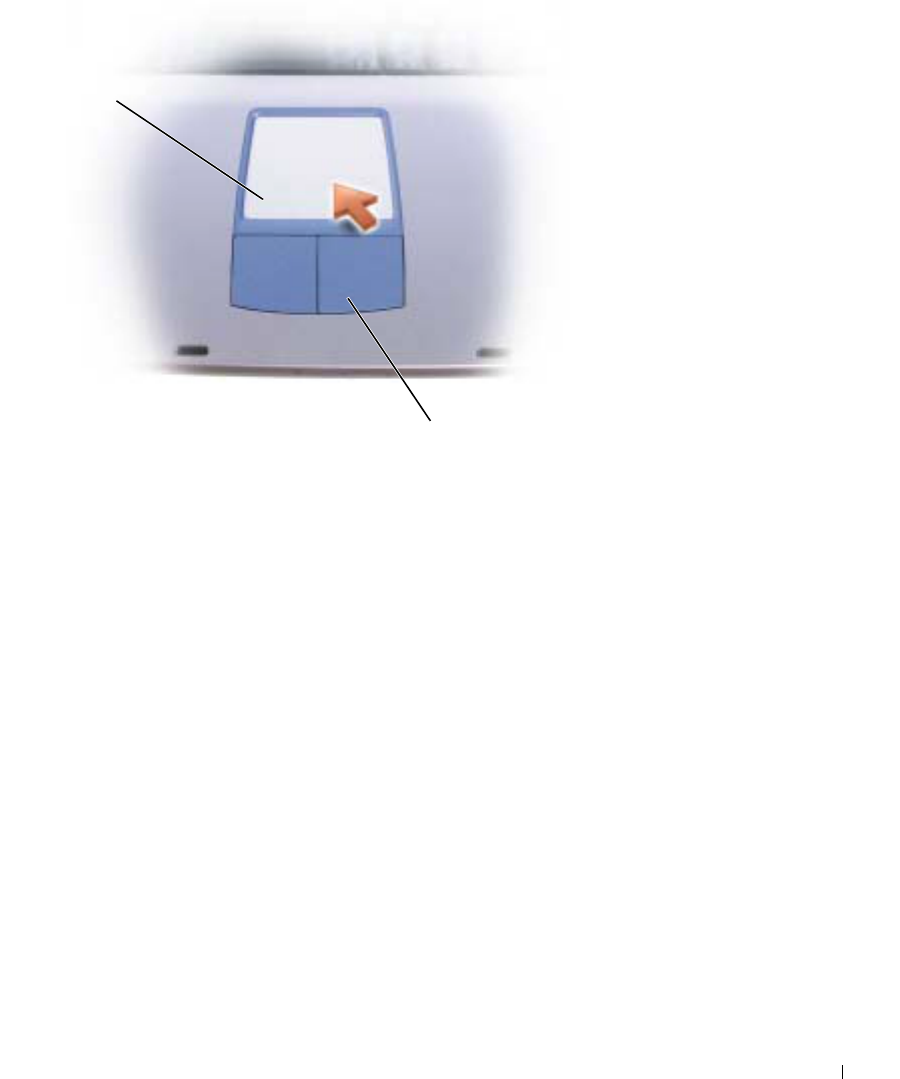
Using the Keyboard and Touch Pad 51
• To move the cursor, lightly slide your finger over the touch pad.
• To select an object, lightly tap once on the surface of the touch pad or
use your thumb to press the left touch-pad button.
• To select and move (or drag) an object, position the cursor on the
object and tap down-up-down on the touch pad. On the second down
motion, leave your finger on the touch pad and move the selected
object by sliding your finger over the surface.
• To double-click an object, position the cursor on the object and tap
twice on the touch pad or use your thumb to press the left touch-pad
button twice.
Customizing the Touch Pad
You can use the Mouse Properties window to disable the touch pad or
adjust its settings.
1Click the Start button, click Control Panel, and then click Printers
and Other Hardware.
2Click Mouse.
touch pad
touch pad buttons

52 Using the Keyboard and Touch Pad
www.dell.com | support.dell.com
3In the Mouse Properties window, click the Device Settings tab.
To disable the touch pad or mouse, highlight the device and click
Disable.
To change the touch pad or mouse settings, highlight the device, click
Settings, select the desired setting(s), and then click Apply.
4Click OK to save the settings and close the window, and then click OK
again to exit the Mouse Properties window.
Touch Pad or Mouse Problems
CHECK THE TOUCH PAD SETTINGS —
1Click the Start button, click Control Panel, and then click Printers and Other
Hardware.
2Click Mouse.
3Try adjusting the settings.
CHECK THE MOUSE CABLE —Shut down the computer (see page 39).
Disconnect the mouse cable and check it for damage. Firmly reconnect the cable.
If you are using a mouse extension cable, disconnect it and connect the mouse
directly to the computer.
TO VERIFY THAT THE PROBLEM IS WITH THE MOUSE, CHECK THE TOUCH
PAD —
1Shut down the computer (see page 39).
2Disconnect the mouse.
3Turn on the computer.
4At the Windows desktop, use the touch pad to move the cursor around, select an
icon, and open it.
If the touch pad operates correctly, the mouse may be defective.
REINSTALL THE TOUCH PAD DRIVER —See page 83.
External Keyboard Problems
NOTE: When you attach
an external keyboard, the
integrated keyboard
remains fully functional.
CHECK THE KEYBOARD CABLE —Shut down the computer (see page 39).
Disconnect the keyboard cable and check it for damage. Firmly reconnect the cable.
If you are using a keyboard extension cable, disconnect it and connect the keyboard
directly to the computer.

Using the Keyboard and Touch Pad 53
CHECK THE EXTERNAL KEYBOARD —
1Shut down the computer (see page 39), wait 1 minute, and turn it on again.
2Verify that the numbers, capitals, and scroll lock lights on the keyboard blink
during the boot routine.
3From the Windows® desktop, click the Start button, point to All Programs, point
to Accessories, and click Notepad.
4Type some characters on the external keyboard and verify that they appear on the
display.
If you cannot verify these steps, you may have a defective external keyboard.
TO VERIFY THAT THE PROBLEM IS WITH THE EXTERNAL KEYBOARD,
CHECK THE INTEGRATED KEYBOARD —
1Shut down the computer (see page 39).
2Disconnect the external keyboard.
3Turn on the computer.
4From the Windows desktop, click the Start button, point to Programs, point to
Accessories, and click Notepad.
5Type some characters on the external keyboard and verify that they appear on the
display.
If the characters appear now but did not with the external keyboard, you may have a
defective external keyboard. Contact Dell (see page 122).
Unexpected Characters
DISABLE THE NUMERIC KEYPAD —Press to disable the numeric
keypad if numbers are displayed instead of letters. Verify that the numbers lock light
is not lit.

54 Using the Keyboard and Touch Pad
www.dell.com | support.dell.com

56 Using CDs, DVDs, and Other Multimedia
www.dell.com | support.dell.com
Using CDs and DVDs
For information about using CDs and DVDs in your computer, see the Te l l
Me How help file. To access the help file, see page 74.
CD or DVD Problems
If you cannot play a CD, CD-RW, or DVD
NOTE: Because of
different worldwide file
types, not all DVD titles
work in all DVD drives.
High-speed CD drive vibration is normal and may cause noise. This noise
does not indicate a defect with the drive or the CD.
ENSURE THAT WINDOWS® RECOGNIZES THE DRIVE —Click the Start
button and click My Computer. If the drive is not listed, perform a full scan with
your antivirus software to check for and remove viruses. Viruses can sometimes
prevent Windows from recognizing the drive. Insert a bootable disk and restart the
computer. Verify that the light is blinking, indicating normal operation.
TRY ANOTHER DISC —Insert another disc to eliminate the possibility that the
original disc is defective.
ADJUST THE WINDOWS VOLUME CONTROL —Double-click the speaker icon
in the lower-right corner of your screen. Ensure that the volume is turned up and
that the sound is not muted.
CLEAN THE DRIVE OR DISC — See "Cleaning Your Computer" in the Tell Me
How help file for instructions. To access the help file, see page 74.
If you cannot eject the CD, CD-RW, or DVD drive tray
1Ensure that the computer is shut down and turned off (see page 39).
2Straighten a paper clip and insert one end into the eject hole at the front of the
drive; push firmly until the tray is partially ejected.
3Gently pull out the tray until it stops.
If you hear an unfamiliar scraping or grinding sound
• Ensure that the sound is not caused by the program that is running.
• Ensure that the disk or disc is inserted properly.
If the CD-RW drive stops writing
DISABLE STANDBY MODE IN WINDOWS BEFORE WRITING TO A
CD-RW — Search for the keyword standby in the Help and Support Center. To
access help, see page 74.

Using CDs, DVDs, and Other Multimedia 57
CHANGE THE WRITE SPEED TO A SLOWER RATE —See the help files for
your CD creation software.
EXIT ALL OTHER OPEN PROGRAMS —Exiting all other open programs before
writing to the CD-RW may alleviate the problem.
Sound and Speaker Problems
If you have a problem with integrated speakers
ADJUST THE WINDOWS® VOLUME CONTROL —Double-click the speaker
icon in the lower-right corner of your screen. Ensure that the volume is turned up
and that the sound is not muted. Adjust the volume, bass, or treble controls to
eliminate distortion.
ADJUST THE VOLUME USING KEYBOARD SHORTCUTS —Press
to disable (mute) or reenable the integrated speakers.
REINSTALL THE SOUND (AUDIO) DRIVER —See page 83.
If you have a problem with external speakers
NOTE: The volume
control in some MP3
players overrides the
Windows volume setting.
If you have been listening
to MP3 songs, make sure
that you did not turn the
player volume down
or off.
CHECK THE SPEAKER CABLE CONNECTIONS —See the setup diagram
supplied with the speakers.
TEST THE ELECTRICAL OUTLET —Ensure that the electrical outlet is working
by testing it with another device, such as a lamp.
ENSURE THAT THE SPEAKERS ARE TURNED ON —See the setup diagram
supplied with the speakers.
ADJUST THE WINDOWS VOLUME CONTROL —Double-click the speaker icon
in the lower-right corner of your screen. Ensure that the volume is turned up and
that the sound is not muted. Adjust the volume, bass, or treble controls to eliminate
distortion.
TEST THE SPEAKERS —Plug the speaker audio cable into the line-out
connector on the computer. Ensure that the headphone volume control is turned
up. Play a music CD.
RUN THE SPEAKER SELF-TEST —Some speaker systems have a self-test
button on the subwoofer. See the speaker documentation for self-test instructions.
ELIMINATE POSSIBLE INTERFERENCE —Turn off nearby fans, fluorescent
lights, or halogen lamps to check for interference.
REINSTALL THE SOUND (AUDIO) DRIVER —See page 83.

58 Using CDs, DVDs, and Other Multimedia
www.dell.com | support.dell.com
Copying CDs
NOTE: To "burn" a CD
means to copy or create
your own custom CD.
Ensure that you follow all
copyright laws when you
create CDs.
This section applies only to computers that have a CD- or DVD-recording
device.
The information in this section is based on the Roxio Easy CD Creator
Basic documentation that came with your computer. See "Using Easy CD
Creator Basic" on page 59 for instructions on how to locate that
documentation.
NOTE: It is
recommended that you
connect your computer to
an electrical outlet when
writing to a CD.
To burn CDs, you need to use CD-burner software. Roxio Easy CD Creator
Basic is your computer's CD-burner software. The software includes the
following project programs that enable you to record specialty CDs for
different types of uses:
NOTE: The information
in this section also applies
to using Easy CD Creator
Basic with a DVD+RW
or a DVD+R drive.
• DirectCD allows you to format a blank CD-R or CD-RW disc so that
you can use Microsoft® Windows® Explorer to drag and drop data
files to the CD-RW drive. You can use a DirectCD-formatted CD-RW
disc like another hard drive on your computer because CD-RW discs
are fully rewritable (CD-R discs can be used with DirectCD, but that
media type has overwriting limitations—see "Using Blank CD-R Discs
or Blank CD-RW Discs" on page 59 for recording media differences).
• MusicCD allows you to burn custom music CDs.
• DataCD allows you to copy a variety of your documents, such as
spreadsheet or accounting files, to a CD for permanent storage.
NOTE: Some music and
game CDs are copy-
protected. If you have a
CD that cannot be copied,
you must use the original
CD for everyday use.
• Disc Copier allows you to make a backup copy of almost any type of
CD. This program allows you to make a copy of a CD for everyday use
so that you can archive and save the original copy. (Disc Copier is
titled "CD Copier" in some versions of Roxio CD Creator Basic.)
All four project programs are available on the Easy CD Creator Basic Select
a Project menu screen. To view the Select a Project menu screen, click the
Start button, point to All Programs→ Roxio Easy CD Creator, and then
click Project Selector.

Using CDs, DVDs, and Other Multimedia 59
Using Easy CD Creator Basic
See the Easy CD Creator Basic documentation for instructions on how to
use the program, information about different recording techniques, and CD
media limitations. The Easy CD Creator Basic documentation is located in
the Windows Help and Support Center (see page 74). The documentation
is also provided on the Roxio reinstallation CD, which is included with your
computer. Each Easy CD Creator Basic project program also has thorough
online help files.
Using Blank CD-R Discs or Blank CD-RW Discs
Your CD-RW drive writes to two different types of recording media—CD-R
and CD-RW discs. Use blank CD-R (CD-Recordable) disks to record music
or permanently store data files. After creating a CD-R disc, you cannot write
to that disc again without changing your method of recording (see the
Roxio documentation for more information). Use blank CD-RW
(CD-ReWritable) discs when you want to write, erase, rewrite, and update
your files onto CDs.
Helpful Tips
• You must use the Easy CD Creator Basic project programs to copy and
record all music and data CDs. You can use Windows Explorer to drag
and drop files to a CD-R or CD-RW disc only after you first use
DirectCD to format the disc.
• You must use CD-R discs to burn music CDs that you want to play in
regular stereos. CD-RW discs do not play in most home or car stereos.
• If you want to copy files from the Internet or files from a floppy or Zip
drive, copy those files to your hard drive first, and then burn your CD.
Your CD-RW drive requires a steady stream of data to properly record.
Direct Internet downloads, floppy drives, and Zip drives may not be
able to provide a steady data stream to your CD-RW drive.
• Music MP3 files can be played only on MP3 players or on computers
that have MP3 software installed.
• Ensure that you set the sampling rate to at least 128 Kbps when you
burn MP3 files to a CD. Otherwise, recording errors may occur.

60 Using CDs, DVDs, and Other Multimedia
www.dell.com | support.dell.com
• Do not burn a blank CD-R or CD-RW disc to its maximum capacity;
for example, do not copy a 650-MB file to a 650-MB blank CD. The
CD-RW drive needs 1 or 2 MB of the blank CD to finalize the
recording.
• Use a blank CD-RW disc to practice CD recording until you are
familiar with CD recording techniques. If you make a mistake, you can
erase the CD-RW disc and try again. You can also use blank CD-RW
discs to test music file projects before you record the project
permanently to a blank CD-R disc.
• See the Roxio support website at support.roxio.com for additional
helpful tips.
How to Copy a CD
NOTE: If you have a
DVD/CD-RW combo drive
and you experience
recording problems, first
check for available
software patches on the
Dell Support website at
support.dell.com and if
necessary, the Roxio
support website at
support.roxio.com.
The procedure assumes that your computer is equipped with a single
CD-RW drive (without an additional CD drive). If your computer is
equipped with both types of drives, see the Roxio documentation for
instructions on how to copy CDs from a CD drive to a CD-RW drive.
1Click the Start button, point to All Programs→ Roxio Easy CD
Creator, and then click Project Selector.
The Select a Project window appears.
2Click Disc Copier. (Disc Copier is titled "CD Copier" in some versions
of Easy CD Creator Basic.)
The Disc Copier window appears and displays your CD-RW drive in
the Copy from and the Record to lists.
3Insert the source CD that you want to copy into the CD-RW drive.
The Disc Copier project program briefly checks the source CD in the
CD-RW drive to ensure that it is a readable CD.
4Click Copy.
Depending on the size of the files that are being copied, the copy
process may take a few minutes.
5After the source CD is copied, remove the source CD from the
CD-RW drive tray.
The CD-RW drive tray opens automatically after the source CD is
copied.

Using CDs, DVDs, and Other Multimedia 61
6Insert a blank CD into the CD-RW drive and close the tray.
The recording starts automatically.
7After the recording completes, click OK.
Connecting a Television to the
Computer
Your computer has an S-video TV-out connector that enables you to
connect the computer to a television. Using a commercially available
S-video cable or composite video cable, you can connect the computer to a
television in one of two ways:
NOTE: Video and audio
cables for connecting your
computer to a television
are not included with your
computer. Cables may be
purchased at most
consumer electronics
stores.
• S-video (for a television with S-video input)
• Composite video (for a television with only a composite video input;
also uses the Dell-supplied composite TV-out adapter cable)
The audio connector on the side of the computer enables you to connect
the computer to your television or audio device, using a commercially
available audio cable.
NOTE: Diagrams for
each connection
combination appear at the
beginning of each
subsection to help you
determine which method
you should use.
When you complete the cable connection, see "Enabling the Display
Settings for a Television" on page 66 to ensure that the computer recognizes
and works properly with the television.
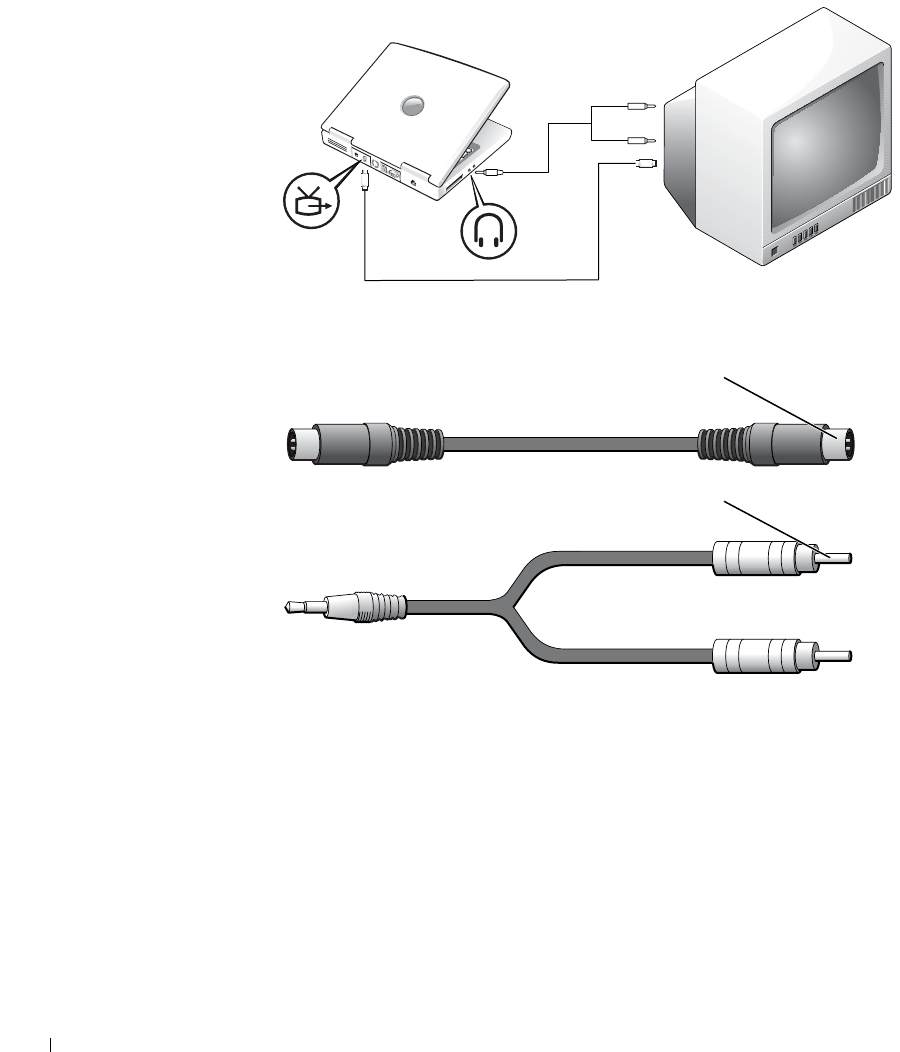
62 Using CDs, DVDs, and Other Multimedia
www.dell.com | support.dell.com
S-Video Connection
Before you begin, ensure that you have the following cables:
1Turn off the computer and the television and/or audio device you want
to connect.
2Plug one end of the S-video cable into the S-video connector on the
computer.
S
-v
id
eo
ca
bl
e
audio cable
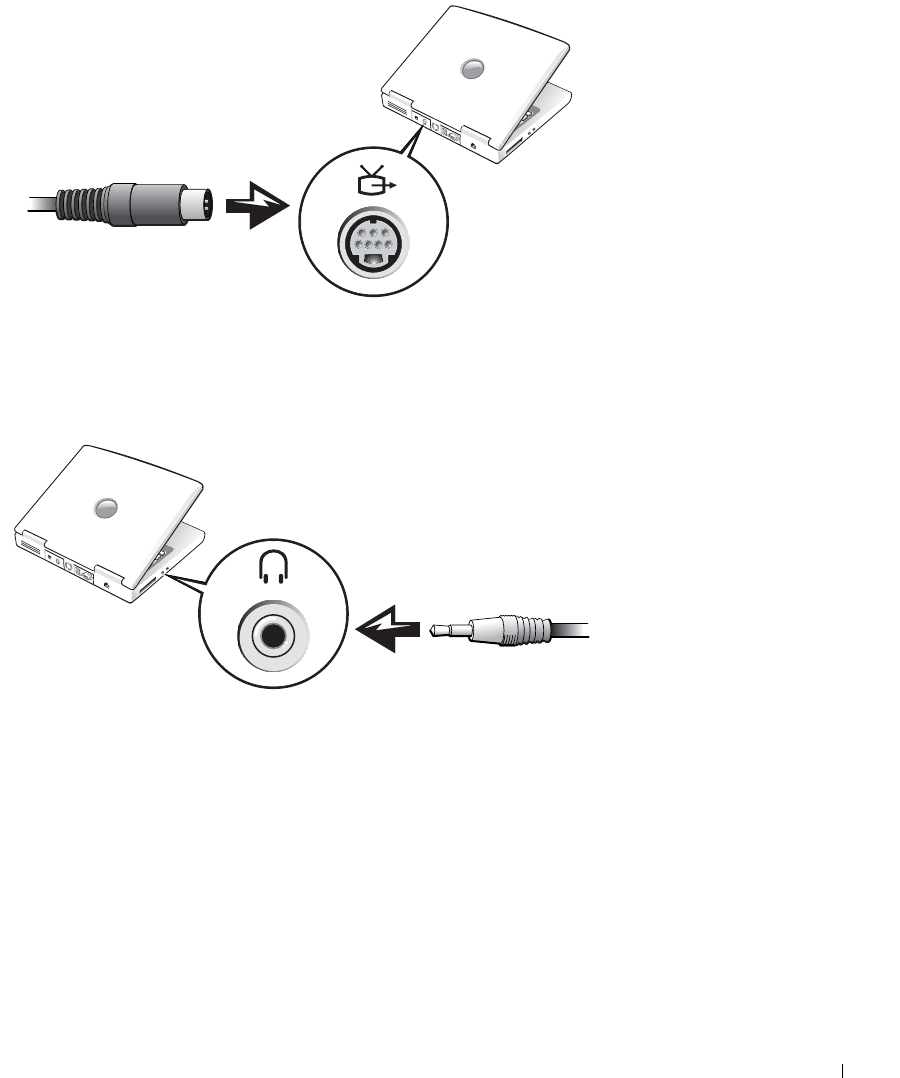
Using CDs, DVDs, and Other Multimedia 63
3Plug the other end of the S-video cable into your television.
4Plug the single-connector end of the audio cable into the headphone
connector on your computer.
5Plug the two RCA connectors on the other end of the audio cable into
the audio input connectors on your television or other audio device.
6Turn on the television, turn on any audio device you connected, and
then turn on the computer.
7See "Enabling the Display Settings for a Television" on page 66 to
ensure that the computer recognizes and works properly with the
television.
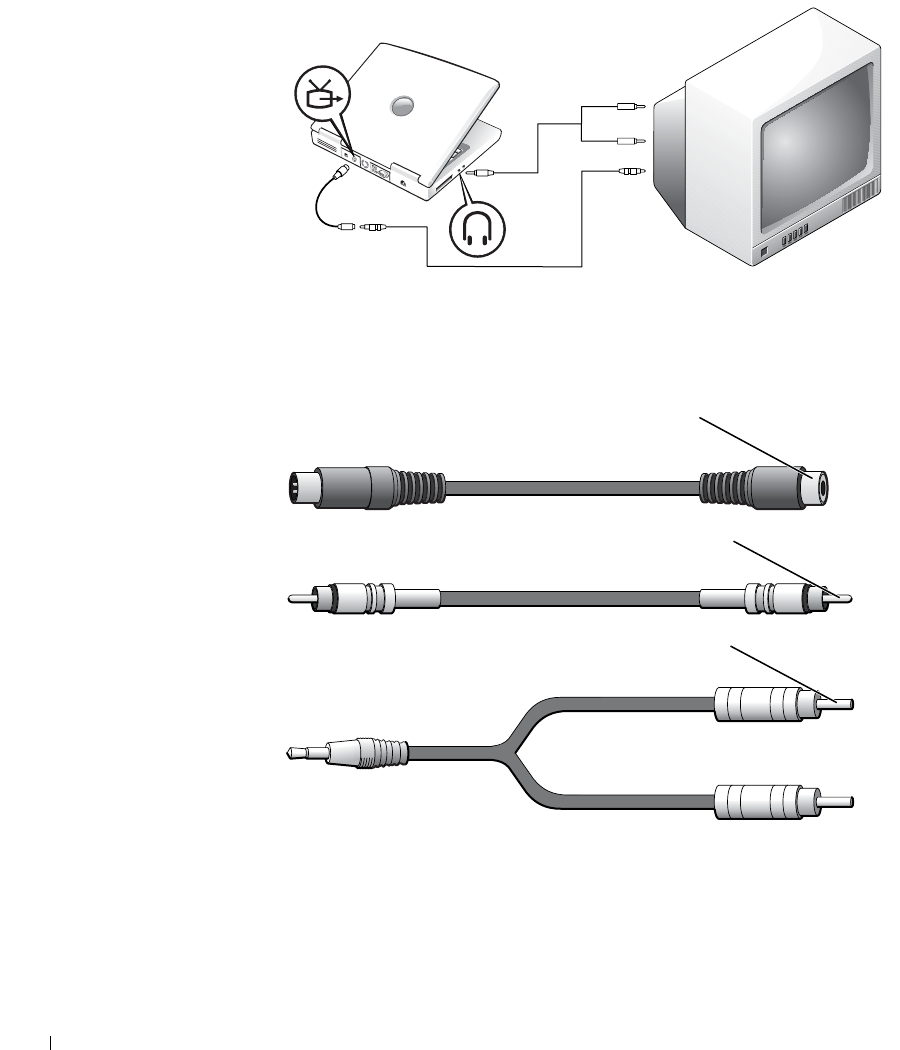
64 Using CDs, DVDs, and Other Multimedia
www.dell.com | support.dell.com
Composite Video Connection
To connect the computer to a television that has a composite video input
only, Dell provides a composite TV-out adapter cable. Before you begin,
ensure that you have the following cables:
1Turn off the computer and the television and/or audio device you want
to connect.
compos
it
e
TV
-ou
t
a
d
ap
t
er
ca
bl
e
composite video cable
audio cable
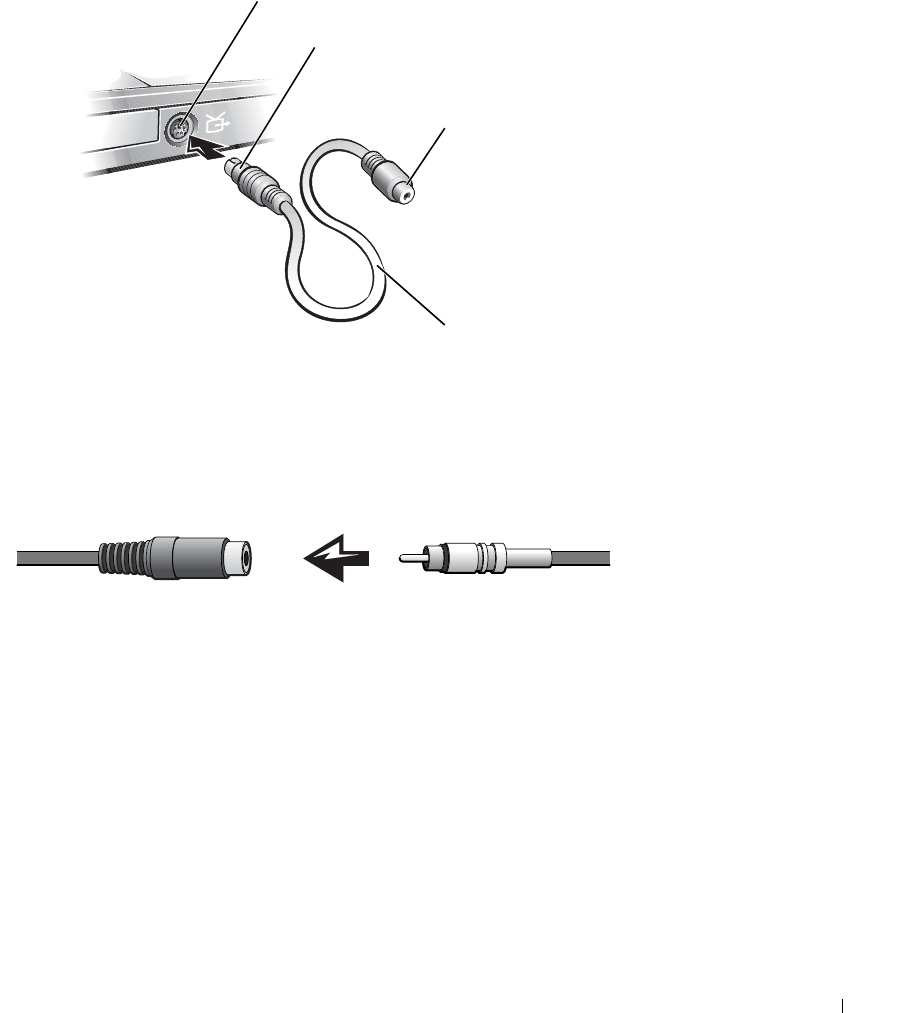
Using CDs, DVDs, and Other Multimedia 65
2Connect the composite TV-out adapter cable to the S-video TV-out
connector on the computer.
3Plug one end of the composite video cable into the composite video
connector on the composite TV-out adapter cable.
4Plug the other end of the composite video cable into the composite
video connector on the television.
5Plug the single-connector end of the audio cable into the headphone
connector on the computer.
S
-v
id
eo
TV
-ou
t
connec
t
or
composite video
connector
composite TV-out
adapter cable
S-video connector
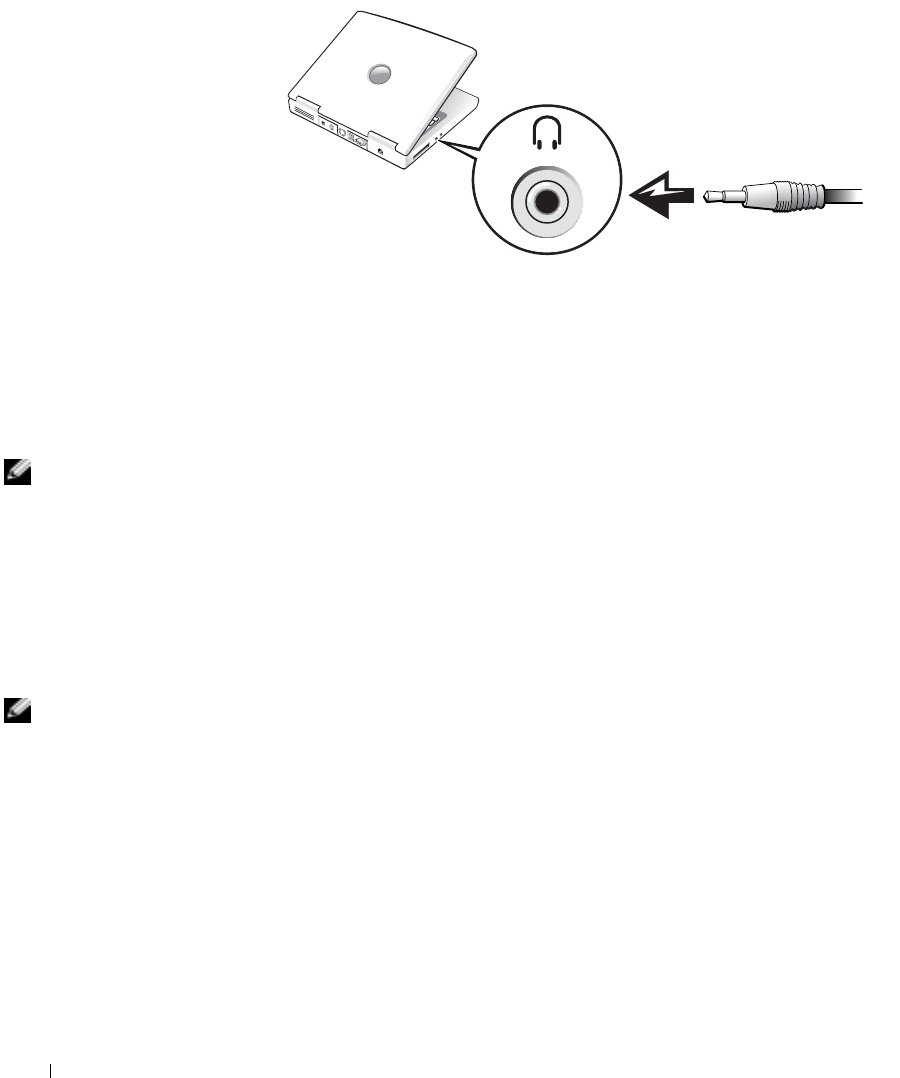
66 Using CDs, DVDs, and Other Multimedia
www.dell.com | support.dell.com
6Plug the two RCA connectors on the other end of the audio cable into
the audio input connectors on your television or other audio device.
Enabling the Display Settings for a Television
ATI Video Controller
NOTE: Ensure that you
properly connect the
television before you
enable the display
settings.
1Click the Start button and click the Control Panel icon.
2Click Appearance and Themes and click Display.
3Click the Settings tab and click Advanced.
4Click the Display tab.
5Click the upper-left corner of the TV button to enable the television.
6To play a DVD on the television, click the small "primary" button
(resembles a bulls-eye) under the TV picture.
NOTE: Various programs
access the hardware in
different ways. You may
or may not need to click
the primary button for
operations other than
playing DVDs.
7Click Apply.
8Click Yes to keep the new settings.
9Click OK.
DVD video is visible only on the display that is set to primary. While the
DVD is playing, the DVD player window on your computer display is blank
or (if the DVD player window is set to full-screen mode) the entire
computer display screen is blank.
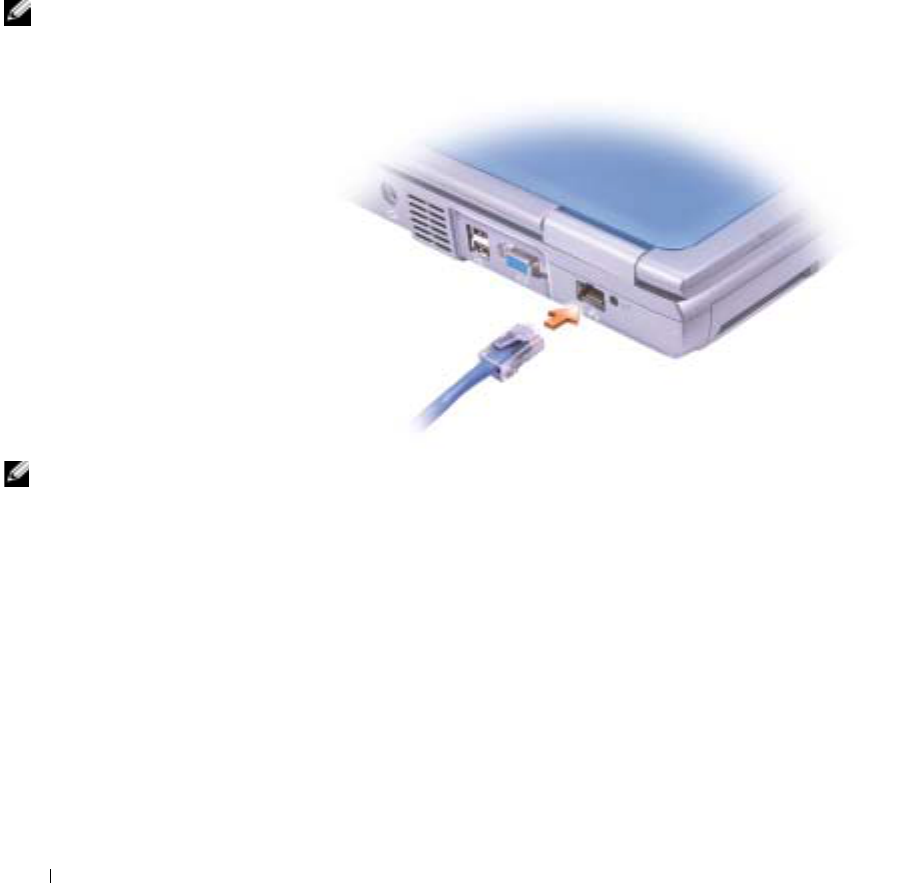
68 Setting Up a Home and Office Network
www.dell.com | support.dell.com
Connecting to a Network Adapter
Before you connect your computer to a network, the computer must have a
network adapter installed and a network cable connected to it.
To connect a network cable:
1Connect the network cable to the network adapter connector on your
computer.
NOTE: Insert the cable
until it clicks into place,
and then gently pull it to
ensure that it is secure.
2Connect the other end of the network cable to a network connection
device, such as a network wall jack.
NOTE: Do not use a
network cable with a
telephone wall jack.
Network Setup Wizard
The Microsoft® Windows® XP operating system provides a Network Setup
Wizard to guide you through the process of sharing files, printers, or an
Internet connection between computers in a home or small office.
1Click the Start button, point to All Programs→ Accessories→
Communications, and then click Network Setup Wizard.
2On the welcome screen, click Next.
3Click Checklist for creating a network.

Setting Up a Home and Office Network 69
NOTE: Selecting the
connection method This
computer connects
directly to the Internet
enables the integrated
firewall provided with
Windows XP.
4Complete the checklist and required preparations, and return to the
Network Setup Wizard.
5Follow the instructions on the screen.
Network Problems
CHECK THE NETWORK CABLE CONNECTOR —Ensure that the network cable
connector is firmly connected to the connector on the computer and the network
wall jack.
CHECK THE NETWORK LIGHTS ON THE NETWORK CONNECTOR —Green
indicates that the network connection is active. If the status light is not green, try
replacing the network cable. Amber indicates that the network adapter driver is
loaded and the adapter is detecting activity.
RESTART THE COMPUTER —Try to log on to the network again.
CONTACT YOUR NETWORK ADMINISTRATOR —Verify that your network
settings are correct and that the network is functioning.

70 Setting Up a Home and Office Network
www.dell.com | support.dell.com

7
SECTION 7
Solving Problems
Finding Solutions
Accessing Help
Error Messages
Video and Display Problems
Scanner Problems
Drive Problems
PC Card Problems
General Program Problems
Resolving Other Technical Problems
If Your Computer Gets Wet
If You Drop or Damage Your Computer
Drivers
Resolving Software and Hardware Incompatibilities
Using System Restore
Reinstalling Microsoft® Windows® XP
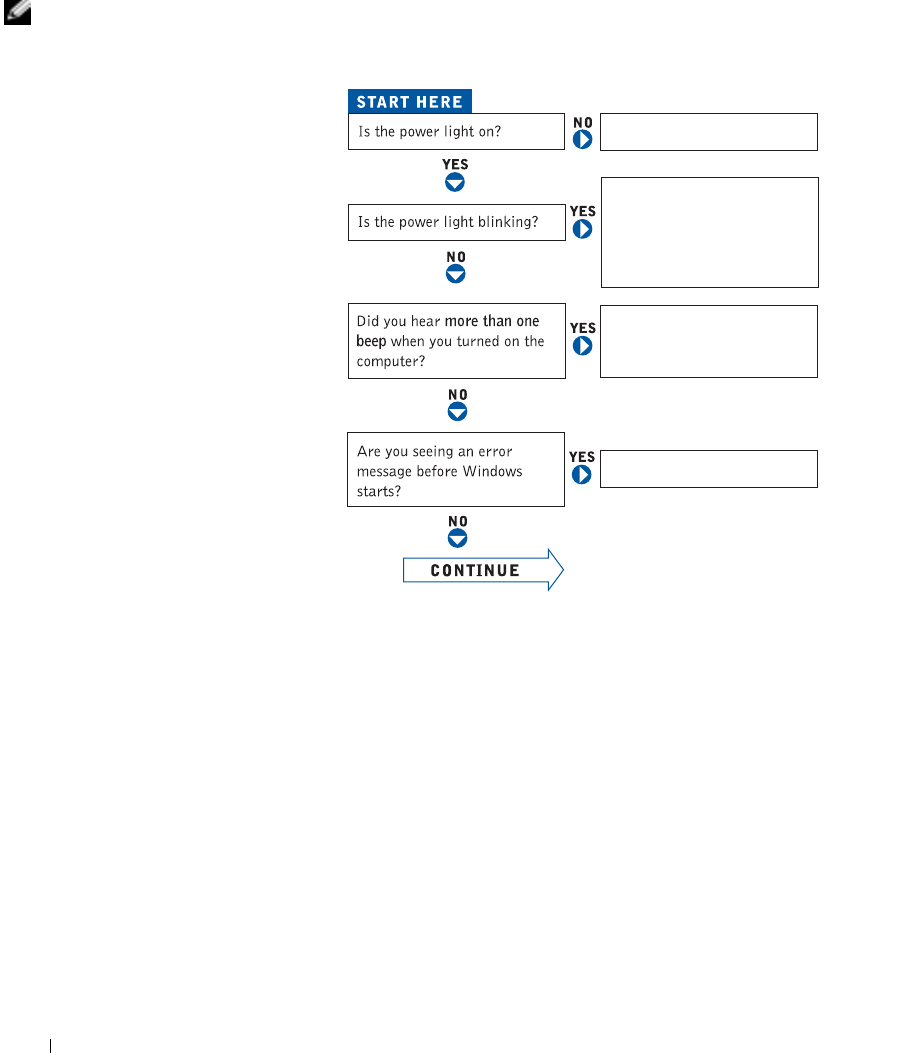
72 Solving Problems
www.dell.com | support.dell.com
Finding Solutions
NOTE: If you have a
problem with an external
device, see the device
documentation or contact
the manufacturer.
Sometimes it’s difficult to figure out where to go for answers. Use this chart
to quickly find the answers to your questions.
®
See page 45.
See page 74.
Get technical assistance from
Dell. See page 122.
Press the power button to
exit standby mode. See the
Tell Me How
help file for
more information on
standby mode.

74 Solving Problems
www.dell.com | support.dell.com
Accessing Help
Error Messages
If the message is not listed, see the documentation for the operating system
or the program that was running at the time the message appeared.
TO ACCESS THE
T
ELL
M
E
H
OW
HELP FILE —
1Click the Start button and click Help and Support.
2Click User and system guides and click User’s guides.
3Click Tell Me How.
TO ACCESS HELP IN WINDOWS XP
—
1Click the Start button and click Help and Support.
2Type a word or phrase that describes your problem and then click the arrow
icon.
3Click the topic that describes your problem.
4Follow the instructions shown on the screen.
THE FILE BEING COPIED IS TOO LARGE FOR THE DESTINATION
DRIVE —The file that you are trying to copy is too large to fit on the disk, or
the disk is too full. Try copying the file to a different disk or use a larger capacity
disk.
A FILENAME CANNOT CONTAIN ANY OF THE FOLLOWING
CHARACTERS: \ / : * ? “ < > | — Do not use these characters in
filenames.
INSERT BOOTABLE MEDIA —The operating system is trying to boot to a
nonbootable floppy disk or CD. Insert a bootable floppy disk or CD.
NON-SYSTEM DISK OR DISK ERROR —A floppy disk is in the floppy drive.
Remove the floppy disk and restart the computer.
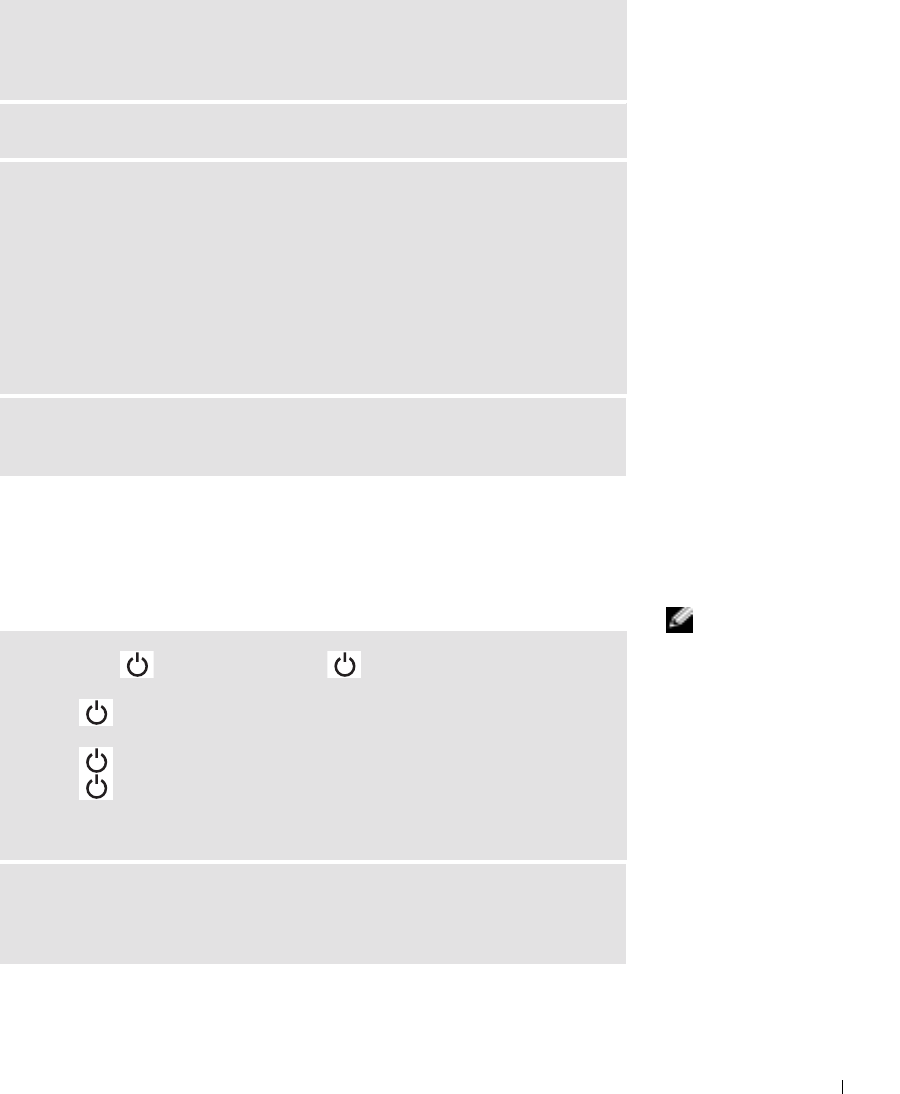
Solving Problems 75
Video and Display Problems
If the display is blank
NOTE: If you are using a
program that requires a
higher resolution than
your computer supports,
it is recommended that
you attach an external
monitor to your computer.
NOT ENOUGH MEMORY OR RESOURCES. EXIT SOME PROGRAMS AND
TRY AGAIN —You have too many programs open. Close all windows and open
the program that you want to use.
OPERATING SYSTEM NOT FOUND —Contact Dell (see page 122).
A REQUIRED .DLL FILE WAS NOT FOUND —The program that you are
trying to open is missing an essential file. Remove and then reinstall the program.
1Click the Start button.
2Click Control Panel.
3Click Add or Remove Programs.
4Select the program you want to remove.
5Click Remove or Change/Remove and follow the prompts on the screen.
6See the program documentation for installation instructions.
X:\ IS NOT ACCESSIBLE. THE DEVICE IS NOT READY —Insert a disk
into the drive and try again.
CHECK THE LIGHT —When the light is blinking, the computer
has power.
• If the light is blinking, the computer is in standby mode—press the
power button to exit standby mode.
• If the light is off, press the power button.
• If the light is on, your power management settings may have caused the
display to turn off. Try pressing any key or move the cursor to exit standby
mode.
CHECK THE BATTERY —If you are using a battery to power your computer,
the battery charge may be depleted. Connect the computer to an electrical outlet
using the AC adapter, and turn on the computer.
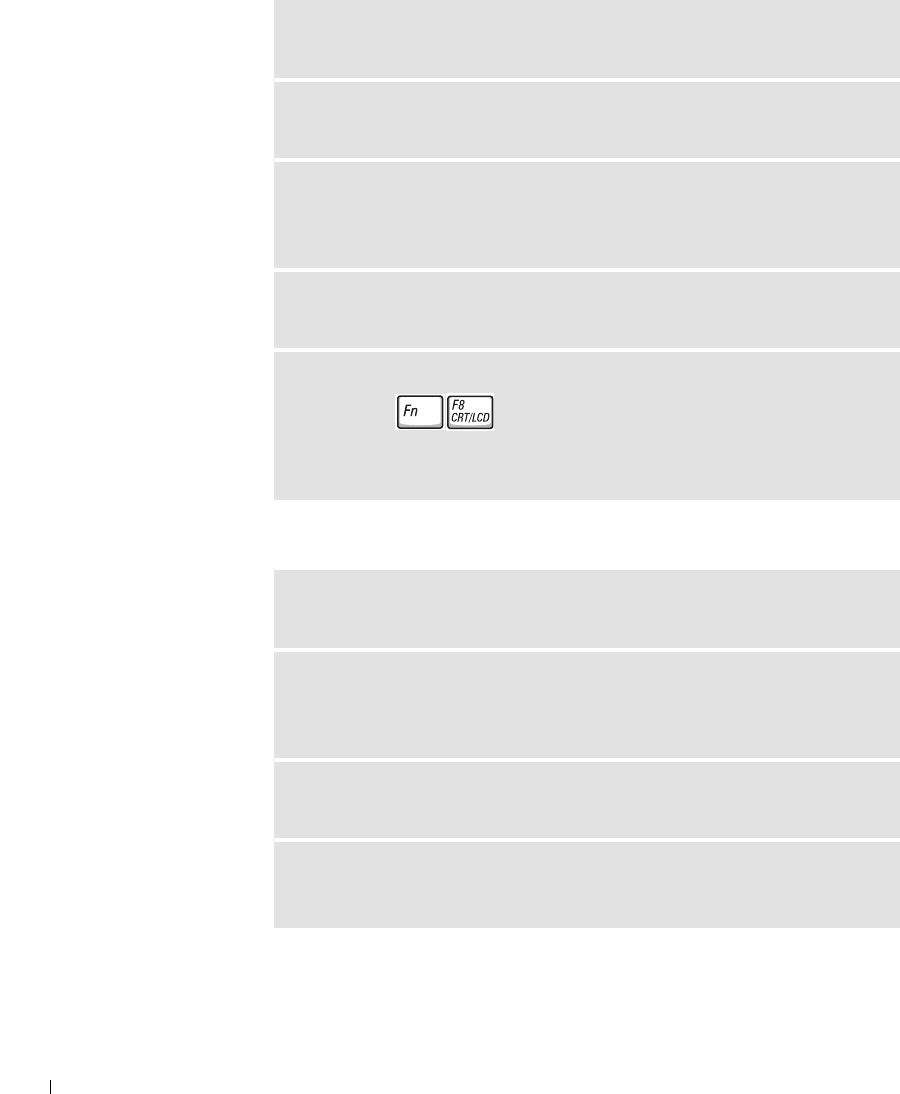
76 Solving Problems
www.dell.com | support.dell.com
If the display is difficult to read
TEST THE ELECTRICAL OUTLET —Ensure that the electrical outlet is
working by testing it with another device, such as a lamp.
CHECK THE AC ADAPTER —Check the AC adapter cable connections. If
the AC adapter has a light, ensure that it is on.
CONNECT THE COMPUTER DIRECTLY TO AN ELECTRICAL OUTLET —
Bypass power protection devices, power strips, and the extension cable to verify
that the computer turns on. To access the help file, see page 74.
ADJUST THE POWER PROPERTIES —Search for the keyword standby in
the Windows Help and Support Center. To access the help file, see page 74.
SWITCH THE VIDEO IMAGE —If your computer is attached to an external
monitor, press to switch the video image to the display.
NOTE: If the computer is connected to a television, you must enable the
television through the Windows display settings (see page 59).
ADJUST THE BRIGHTNESS —See the Tell Me How help file for instructions
on adjusting the brightness. To access the help file, see page 74.
MOVE THE SUBWOOFER AWAY FROM THE COMPUTER OR MONITOR —
If your external speaker system includes a subwoofer, ensure that the subwoofer is
at least 60 cm (2 ft) away from the computer or external monitor.
ELIMINATE POSSIBLE INTERFERENCE —Turn off nearby fans, fluorescent
lights, halogen lamps, or other appliances.
ROTATE THE COMPUTER TO FACE A DIFFERENT DIRECTION —
Eliminate sunlight glare, which can cause poor picture quality.

Solving Problems 77
If only part of the display is readable
Scanner Problems
ADJUST THE WINDOWS DISPLAY SETTINGS —
1Click the Start button and click Control Panel.
2Click Appearance and Themes.
3Click the area you want to change or click the Display icon.
4Try different settings for Color quality and Screen resolution.
SEE "ERROR MESSAGES"—If an error message appears, see page 74.
CONNECT AN EXTERNAL MONITOR —
1Turn off your computer and connect an external monitor to the computer.
2Turn on the computer and the monitor, and adjust the monitor brightness and
contrast controls.
If the external monitor works, the computer display or video controller may be
defective. Contact Dell (see page 122).
CHECK THE POWER CABLE CONNECTION —Ensure that the scanner
power cable is firmly connected to a working electrical power source and that the
scanner is turned on.
CHECK THE SCANNER CABLE CONNECTION —Ensure that the scanner
cable is firmly connected to the computer and to the scanner.
UNLOCK THE SCANNER —Ensure that your scanner is unlocked if it has a
locking tab or button.
REINSTALL THE SCANNER DRIVER —See the scanner documentation for
instructions.
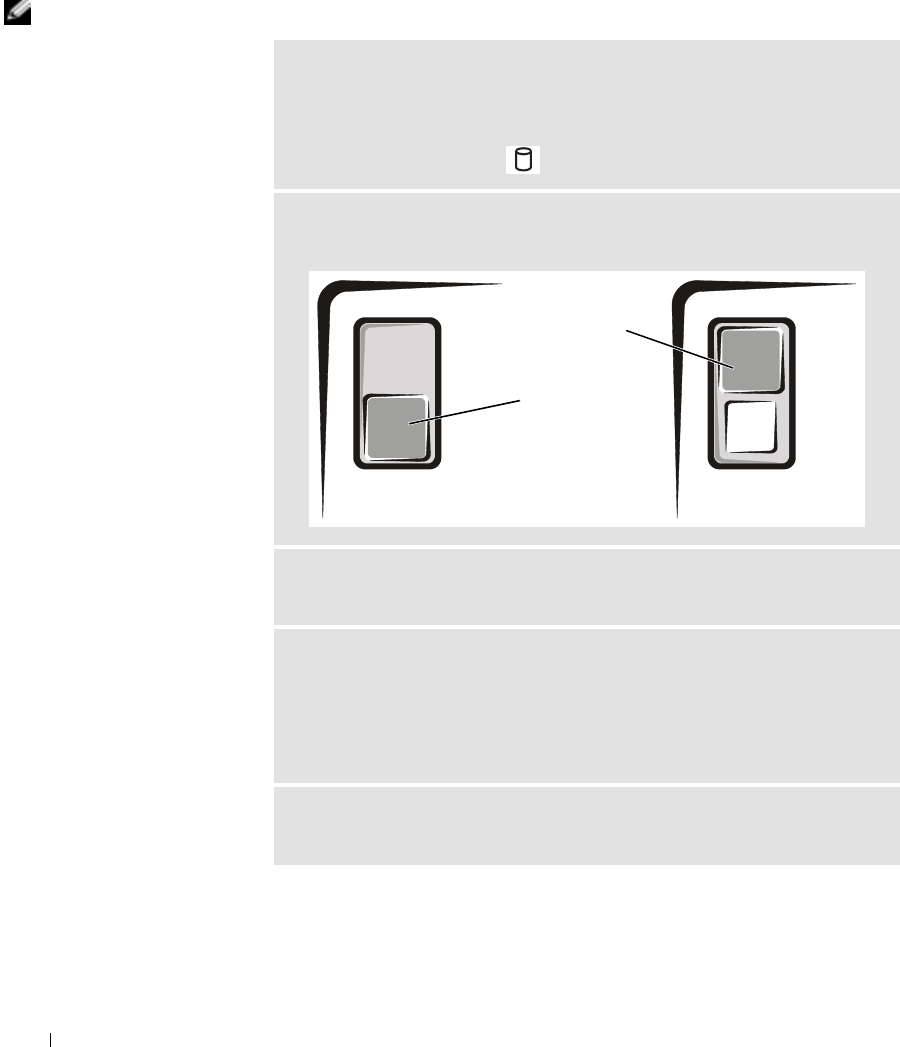
78 Solving Problems
www.dell.com | support.dell.com
Drive Problems
NOTE: For information
on saving files to a floppy
disk, see the
Tell Me How
help file. To access the
help file, see page 74.
If you cannot save a file to a floppy drive
ENSURE THAT WINDOWS® RECOGNIZES THE DRIVE —Click the Start
button and click My Computer. If the drive is not listed, perform a full scan with
your antivirus software to check for and remove viruses. Viruses can sometimes
prevent Windows from recognizing the drive. Insert a bootable disk and restart
the computer. Verify that the light is blinking, indicating normal operation.
ENSURE THAT THE DISK IS NOT WRITE-PROTECTED —You cannot save
data to a write-protected disk. See the following figure.
TRY ANOTHER FLOPPY DISK —Insert another disk to eliminate the
possibility that the original disk is defective.
RECONNECT THE DRIVE —
1Save and close any open files, exit any open programs, and shut down the
computer.
2Disconnect and reconnect the drive
3Turn on the computer.
CLEAN THE DRIVE — See "Cleaning Your Computer" in the Tell Me How
help file for instructions. To access the help file, see page 74.
write-protected
not write-
protected
back of floppy disk

Solving Problems 79
If you have problems with a hard drive
PC Card Problems
ALLOW THE COMPUTER TO COOL BEFORE TURNING IT ON —A hot
hard drive may prevent the operating system from starting. Try allowing the
computer to return to room temperature before turning it on.
CHECK THE DRIVE FOR ERRORS —
1Click the Start button and click My Computer.
2Right-click the drive letter (local disk) that you want to scan for errors, and
then click Properties.
3Click the Tools tab.
4Under Error-checking, click Check Now.
5Click Start.
CHECK THE PC CARD —Ensure that the PC Card is properly inserted into
the connector.
ENSURE THAT THE CARD IS RECOGNIZED BY WINDOWS®—Double-
click the Unplug or Eject Hardware icon in the Windows taskbar. Ensure that
the card is listed.
IF YOU HAVE PROBLEMS WITH A DELL-PROVIDED PC CARD —
Contact Dell (see page 122).
IF YOU HAVE PROBLEMS WITH A PC CARD NOT PROVIDED BY
DELL —Contact the PC Card manufacturer.
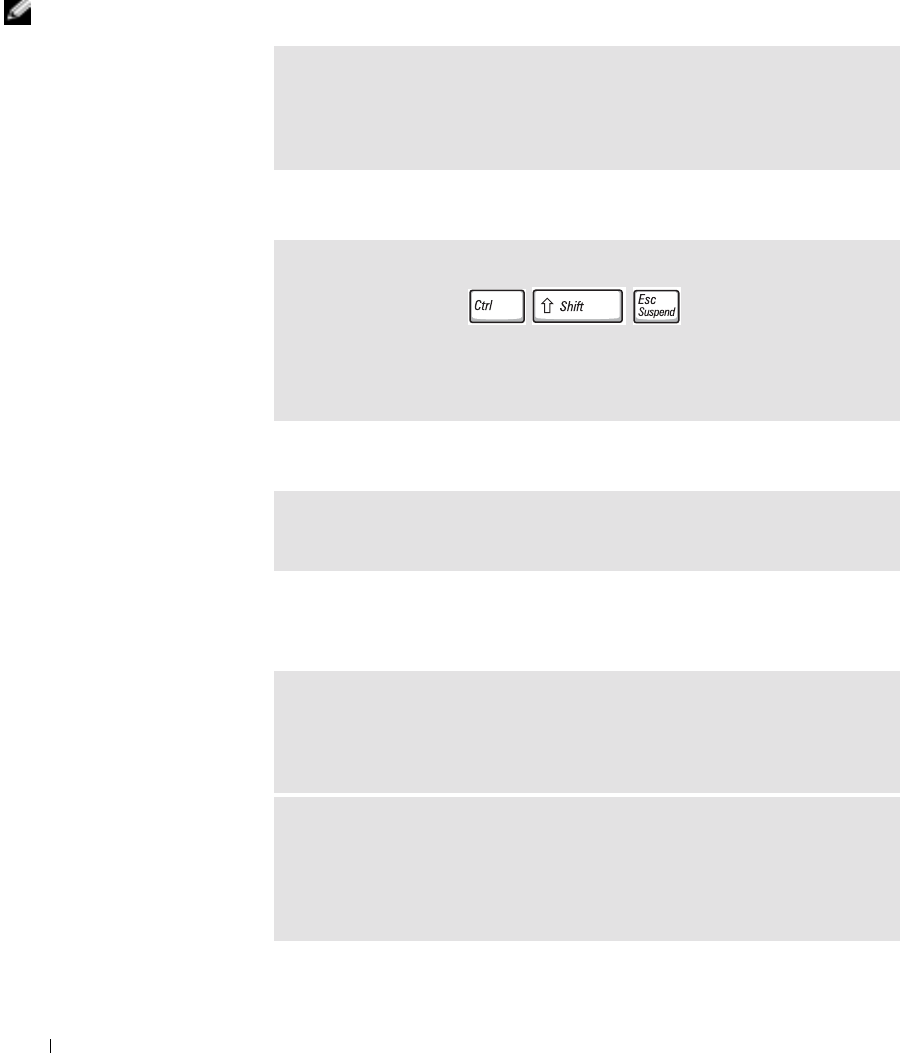
80 Solving Problems
www.dell.com | support.dell.com
General Program Problems
NOTE: Software usually
includes installation
instructions in its
documentation or on a
floppy disk or CD.
A program crashes
A program stops responding
Error messages appear
Resolving Other Technical Problems
SEE THE SOFTWARE DOCUMENTATION —Many software manufacturers
maintain websites with information that may help you solve the problem. Ensure
that you properly installed and configured the program. Reinstall the program if
necessary.
END THE PROGRAM —
1Simultaneously press .
2Click the Applications tab, and then select the program that is no longer
responding.
3 Click End Task.
REVIEW "ERROR MESSAGES" ON PAGE 74 — Look up the message and
take the appropriate action. See the software documentation.
GO TO THE DELL SUPPORT WEBSITE —Go to support.dell.com for help
with general usage, installation, and troubleshooting questions. See "Dell
Technical Support Policy (U.S. Only)" on page 121 for a description of the
hardware and software support provided by Dell.
E-MAIL DELL —Go to support.dell.com and then click E-Mail Dell in the
Communicate list. Send an e-mail message to Dell about your problem; you can
expect to receive an e-mail message from Dell within hours. See "Dell Technical
Support Policy (U.S. Only)" on page 121 for a description of the hardware and
software support provided by Dell.

Solving Problems 81
If Your Computer Gets Wet
CAUTION: Perform this procedure only after you are certain that
it is safe to do so. If the computer is connected to an electrical
outlet, it is recommended that you turn off AC power at the
circuit breaker before attempting to remove the power cables
from the electrical outlet. Use the utmost caution when removing
wet cables from a live power source.
1Shut down the computer (see page 39), disconnect the AC adapter
from the computer, and then disconnect the AC adapter from the
electrical outlet.
2Turn off any attached external devices, and disconnect them from
their power sources and then from the computer.
3Ground yourself by touching one of the metal connectors on the back
of the computer.
4Remove any installed PC Cards, and put them in a safe place to dry.
5Remove the battery.
6Wipe off the battery and put it in a safe place to dry.
7Wipe off the display.
8Remove the hard drive (see page 100).
9Remove the memory module(s) (see page 94).
10 Open the display and place the computer right-side up across two
books or similar props to let air circulate all around it. Let the
computer dry for at least 24 hours in a dry area at room temperature.
NOTICE: Do not use artificial means, such as a hair dryer or a fan, to speed
the drying process.
CAUTION: To help prevent electrical shock, verify that the
computer is thoroughly dry before continuing with the rest of this
procedure.
CONTACT DELL —If you cannot solve your problem using the Dell™ Support
website or e-mail service, call Dell for technical assistance (see page 122). See
"Dell Technical Support Policy (U.S. Only)" on page 121 for a description of the
hardware and software support provided by Dell.

82 Solving Problems
www.dell.com | support.dell.com
11 Ground yourself by touching one of the metal connectors on the back
of the computer.
12 Replace the memory module(s), the memory module cover, and the
screw(s).
13 Replace the hard drive.
14 Replace any PC Cards you removed.
15 Replace the battery.
16 Turn on the computer and verify that it is working properly.
NOTE: See "Limited
Warranties and Return
Policy" on page 143 for
information on your
warranty coverage.
If the computer does not start, or if you cannot identify the damaged
components, contact Dell (see page 122).
If You Drop or Damage Your Computer
1Save and close any open files, exit any open programs, and shut down
the computer (see page 39).
2Disconnect the AC adapter from the computer and from the electrical
outlet.
3Turn off any attached external devices, and disconnect them from
their power sources and then from the computer.
4Remove and reinstall the battery.
5Turn on the computer.
NOTE: See "Limited
Warranties and Return
Policy" on page 143 for
information on your
warranty coverage.
If the computer does not start, or if you cannot identify the damaged
components, contact Dell (see page 122).
Drivers
What Is a Driver?
A driver is a program that controls a device such as a printer, mouse, or
keyboard. All devices require a driver program.
A driver acts like a translator between the device and the programs that use
the device. Each device has its own set of specialized commands that only
its driver recognizes.

Solving Problems 83
Many drivers such as the keyboard driver come with your Microsoft®
Windows® operating system. You may need to install drivers if:
• You upgrade your operating system.
• You reinstall your operating system.
• You connect or install a new device.
If you experience a problem with any device, perform the steps in the
following sections to identify whether the driver is the source of your
problem and to update the driver, if necessary.
Identifying Drivers
1Click the Start button and click Control Panel.
2In the Control Panel window, under Pick a Category, click
Performance and Maintenance.
3In the Performance and Maintenance window, click System.
4In the System Properties screen, click the Hardware tab.
5Click Device Manager.
6In the Device Manager window, scroll down the list to see if any device
has an exclamation point (a yellow circle with a [!]) on the device icon.
If an exclamation point is next to the device name, you may need to
reinstall the driver or install a new driver.
Reinstalling Drivers
NOTICE: The Dell Support website and your
Drivers and Utilities
CD provide
approved drivers for Dell™ computers. If you install drivers obtained from
other sources, your computer might not work correctly.
Using Windows XP Device Driver Rollback
If a problem occurs on your computer after you install or update a driver,
use Windows XP Device Driver Rollback to replace the driver with the
previously installed version.

84 Solving Problems
www.dell.com | support.dell.com
To use Device Driver Rollback:
1Click the Start button and click Control Panel.
2In the Control Panel window, under Pick a Category, click
Performance and Maintenance.
3In the Performance and Maintenance window, click System.
4In the System Properties screen, click the Hardware tab.
5Click Device Manager.
6In the Device Manager window, right-click the device for which the
new driver was installed, and then click Properties.
7Click the Drivers tab.
8Click Roll Back Driver.
If Device Driver Rollback does not resolve the problem, then use System
Restore (see page 87) to return your operating system to the operating state
it was in before you installed the new driver.
Using the Drivers and Utilities CD
If using Device Driver Rollback or System Restore (see page 87) does not
resolve the problem, then reinstall the driver from the Drivers and
Utilities CD.
1Save and close any open files, and exit any open programs.
2Insert the Drivers and Utilities CD.
In most cases, the CD starts running automatically. If it does not, start
Windows Explorer, click your CD drive directory to display the CD
contents, and then double-click the autocd.exe file. The first time that
you run the CD, it might prompt you to install setup files. Click OK,
and follow the instructions on the screen to continue.
3From the Language drop-down menu in the toolbar, select your
preferred language for the driver or utility (if available).
A welcome screen appears.

Solving Problems 85
4Click Next. The CD automatically scans your hardware to detect
drivers and utilities used by your computer.
After the CD completes the hardware scan, you can also detect other
drivers and utilities. Under Search Criteria, select the appropriate
categories from the System Model, Operating System, and Topic
drop-down menus.
A link or links appear(s) for the specific drivers and utilities used by
your computer.
5Click the link of a specific driver or utility to display information about
the driver or utility that you want to install.
6Click the Install button (if present) to begin installing the driver or
utility. At the welcome screen, follow the screen prompts to complete
the installation.
If no Install button is present, automatic installation is not an option.
For installation instructions, either see the appropriate instructions in
the following subsections, or click Extract, follow the extracting
instructions, and read the readme file.
If instructed to navigate to the driver files, click the CD directory on
the driver information window to display the files associated with that
driver.
Manually Reinstalling Drivers for Windows XP
1After extracting the driver files to your hard drive as described in the
previous section, click the Start button and right-click My Computer.
2Click Properties.
3Click the Hardware tab and click Device Manager.
4Double-click the type of device for which you are installing the driver
(for example, Modems or Infrared devices).
5Double-click the name of the device for which you are installing the
driver.
6Click the Driver tab and click Update Driver.
7Click Install from a list or specific location (Advanced) and click
Next.
8Click Browse, and browse to the location to which you previously
extracted the driver files.

86 Solving Problems
www.dell.com | support.dell.com
9When the name of the appropriate driver appears, click Next.
10 Click Finish and restart your computer.
Resolving Software and Hardware
Incompatibilities
Windows XP IRQ conflicts occur if a device either is not detected during
the operating system setup or is detected but incorrectly configured.
To check for conflicts on a computer running Windows XP:
1Click the Start button and click Control Panel.
2Click Performance and Maintenance and click System.
3Click the Hardware tab and click Device Manager.
4In the Device Manager list, check for conflicts with the other devices.
Conflicts are indicated by a yellow exclamation point (!) beside the
conflicting device or a red X if the device has been disabled.
5Double-click any conflict to display the Properties window.
If an IRQ conflict exists, the Device status area in the Properties
window reports the cards or devices that share the device's IRQ.
6Resolve conflicts by reconfiguring the devices or removing the devices
from the Device Manager.
To use the Windows XP Hardware Troubleshooter:
1Click the Start button and click Help and Support.
2Ty p e hardware troubleshooter in the Search field and click the
arrow to start the search.
3Click Hardware Troubleshooter in the Search Results list.
4In the Hardware Troubleshooter list, click I need to resolve a hardware
conflict on my computer, and click Next.

Solving Problems 87
Using System Restore
The Microsoft® Windows® XP operating system provides System Restore
to allow you to return your computer to an earlier operating state (without
affecting data files) if changes to the hardware, software, or other system
settings have left the computer in an undesirable operating state. See the
Help and Support Center for information on using System Restore. To
access help, see page 74.
NOTICE: Make regular backups of your data files. System Restore does not
monitor your data files or recover them.
Creating a Restore Point
1Click the Start button and click Help and Support.
2Click System Restore.
3Follow the instructions on the screen.
Restoring the Computer to an Earlier Operating State
If problems occur after you install a device driver, use Device Driver
Rollback (see page 83) to resolve the problem. If that is unsuccessful, then
use System Restore.
NOTICE: Before you restore the computer to an earlier operating state, save
and close all open files and close all open programs. Do not alter, open, or
delete any files or programs until the system restoration is complete.
1Click the Start button, point to All Programs→ Accessories→ System
Tools, and then click System Restore.
2Ensure that Restore my computer to an earlier time is selected and
click Next.
3Click a calendar date to which you want to restore your computer.
The Select a Restore Point screen provides a calendar that allows you
to see and select restore points. All calendar dates with available
restore points appear in bold.
4Select a restore point and click Next.
If a calendar date has only one restore point, then that restore point is
automatically selected. If two or more restore points are available, click
the restore point that you prefer.

88 Solving Problems
www.dell.com | support.dell.com
5Click Next.
The Restoration Complete screen appears after System Restore
finishes collecting data and then the computer restarts.
6After the computer restarts, click OK.
To change the restore point, you can either repeat the steps using a
different restore point, or you can undo the restoration.
Undoing the Last System Restore
NOTICE: Before you undo the last system restore, save and close all open
files and close all open programs. Do not alter, open, or delete any files or
programs until the system restoration is complete.
1Click the Start button, point to All Programs→ Accessories→ System
Tools, and then click System Restore.
2Click Undo my last restoration and click Next.
3Click Next.
The System Restore screen appears and the computer restarts.
4After the computer restarts, click OK.
Enabling System Restore
If you reinstall Windows XP with less than 200 MB of free hard-disk space
available, System Restore is automatically disabled. To see if System Restore
is enabled:
1Click the Start button and click Control Panel.
2Click Performance and Maintenance.
3Click System.
4Click the System Restore tab.
5Ensure that Turn off System Restore is unchecked.
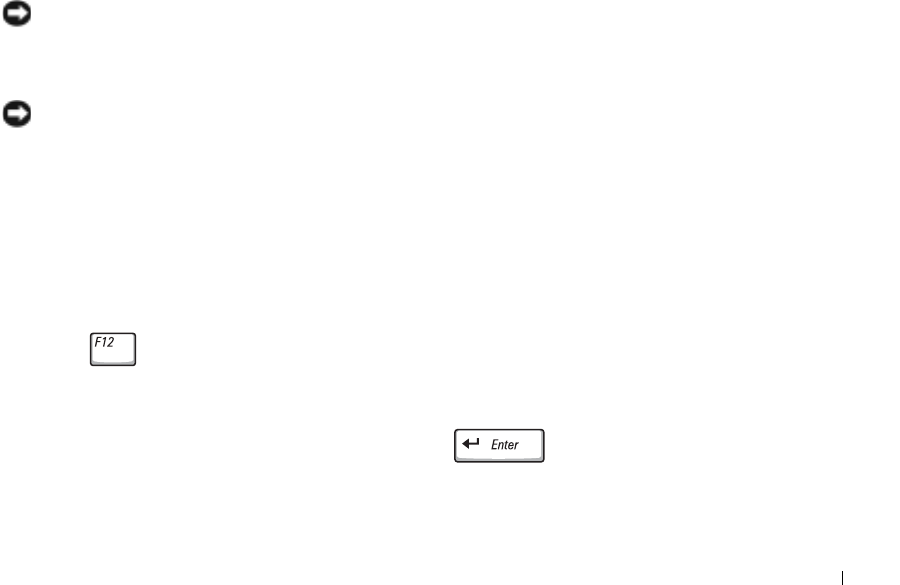
Solving Problems 89
Reinstalling Microsoft® Windows® XP
Before You Reinstall
If you are reinstalling the Windows XP operating system to correct a
problem with a newly installed driver, use Windows XP Device Driver
Rollback (see page 83) to replace the device driver with the previously
installed version.
If Device Driver Rollback does not resolve the problem, then use System
Restore (see page 87) to return your operating system to the operating state
it was in before you installed the new device driver.
Reinstalling Windows XP
To reinstall Windows XP, perform the steps in the following sections in the
order in which they are listed.
The reinstallation process can take 1 to 2 hours to complete. After the
reinstallation is complete, you need to reinstall the device drivers, virus
protection program, and other software.
NOTICE: The
Operating System
CD provides options for reinstalling Windows
XP. The options can overwrite files and possibly affect programs installed on
your hard drive. Therefore, do not reinstall Windows XP unless instructed to
do so by a Dell technical support representative.
NOTICE: To prevent conflicts with Windows XP, disable any virus protection
software installed on your computer before you reinstall Windows XP. See the
documentation that came with the software for instructions.
Preparing to Boot From the Operating System CD
1Insert the Operating System CD.
2Exit any program or utility that might run after you insert the CD.
3Shut down (see page 39) and restart the computer.
4Press immediately after the DELL™ logo appears.
If the operating system logo appears, wait until you see the Windows
desktop, and then shut down the computer and try again.
5Use the arrow keys to select CD-ROM and press .
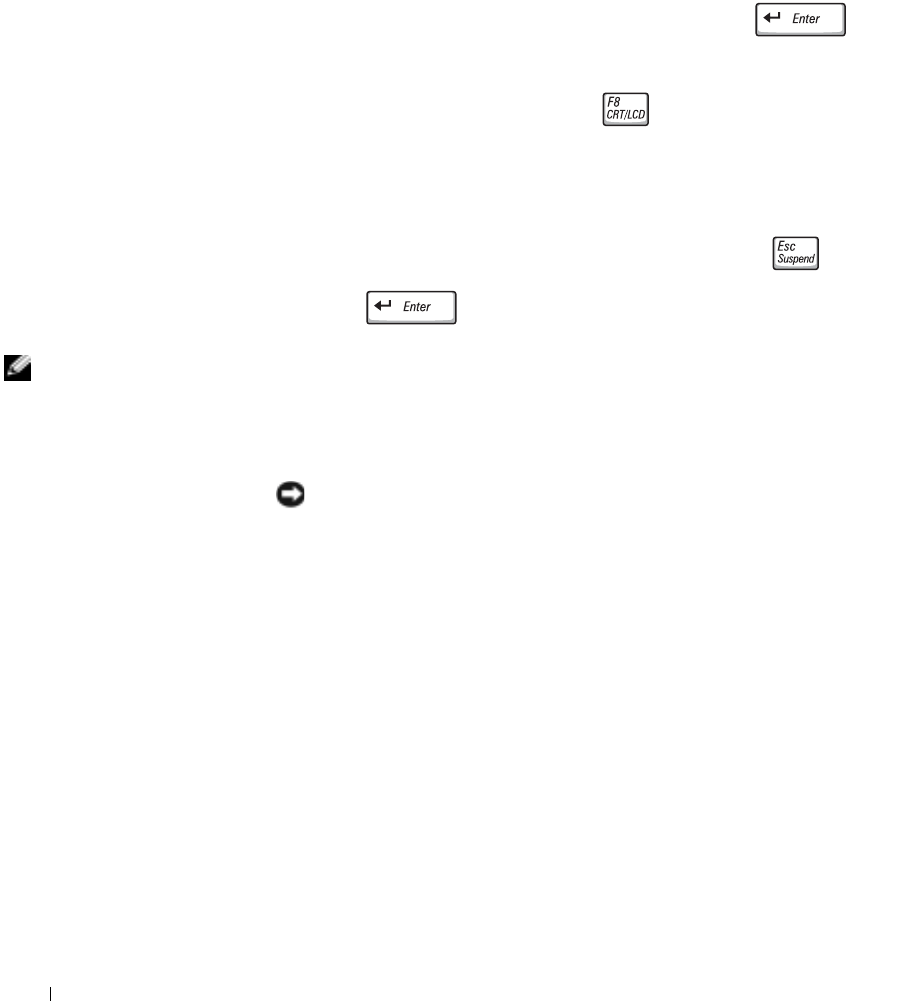
90 Solving Problems
www.dell.com | support.dell.com
6When the Press any key to boot from CD message appears on
the screen, press any key.
Starting Windows XP Setup
1When the Windows XP Setup screen appears, press to
select To set up Windows now.
2Read the information in the Microsoft Windows Licensing
Agreement screen, and then press to accept the license
agreement.
3If your computer already has Windows XP installed and you want to
recover your current Windows XP data, type r to select the repair
option, and then remove the CD from the drive.
4If you want to install a new copy of Windows XP, press to select
the fresh copy option.
5Press to select the highlighted partition (recommended),
and then follow the instructions on the screen.
NOTE: The time required
to complete the setup
depends on the size of the
hard drive and the speed
of your computer.
The Windows XP Setup screen appears, and the operating system
begins to copy files and install the devices. The computer restarts
multiple times.
Completing the GUI Setup
NOTICE: When the computer restarts, do not press a key when the following
message appears: Press any key to boot from the CD.
1When the Regional and Language Options screen appears, select the
settings for your location and click Next.
2Enter your name and organization (optional) in the Personalize Your
Software screen and click Next.
3If you are reinstalling Windows XP Home Edition, at the What's your
computer's name window, enter a name for your computer (or accept
the name provided) and click Next.
If you are reinstalling Windows XP Professional, at the Computer
Name and Administrator Password window, enter a name for your
computer (or accept the one provided) and a password, and then click
Next.
4If you have a modem installed, enter the requested information and
click Next when the Modem Dialing Information screen appears.

Solving Problems 91
5Enter the date, time, and time zone in the Date and Time Settings
window and click Next.
6If your computer has a network adapter, click Typical in the Networking
Settings screen and click Next.
If your computer does not have a network adapter, this option does not
appear.
7If you are reinstalling Windows XP Professional, you may be prompted
to provide further network information regarding your network
configuration, such as the domain name or workgroup name. If you are
unsure of your settings, accept the default selections.
Windows XP installs the operating system components, configures the
computer, and then restarts the computer.
Completing the Operating System Setup
NOTICE: When the computer restarts, do not press a key when the following
message appears: Press any key to boot from the CD.
1When the Welcome to Microsoft screen appears, click Next.
2When the How will this computer connect to the
Internet? message appears, click Skip.
3When the Ready to register with Microsoft? screen appears, click No,
not at this time and click Next.
When the Who will use this computer? screen appears, you can enter
up to five users.
4Click Next.
5Click Finish to complete the setup and remove the CD from the drive.
Reinstalling Drivers and Software
1Reinstall the appropriate drivers (see page 83).
2Reinstall your virus protection software. See the documentation that
came with the software for instructions.
3Reinstall your other software programs. See the documentation that
came with the software for instructions.

92 Solving Problems
www.dell.com | support.dell.com

94 Adding and Replacing Parts
www.dell.com | support.dell.com
Before You Add or Replace Parts
CAUTION: Before working inside your computer, read the safety
instructions at the front of this document (see page 11).
1Ensure that the work surface is flat and clean to prevent scratching the
computer cover.
2Save and close any open files, exit any open programs, and then shut
down the computer (see page 39).
3Disconnect the computer from the electrical outlet.
4Wait 10 to 20 seconds, and then disconnect any attached devices.
5Remove any installed PC Cards and the battery.
NOTICE: Handle components and cards by their edges, and avoid touching
pins and contacts. Ground yourself by touching a metal connector on the back
of the computer. Continue to ground yourself periodically during this
procedure.
Memory
You can increase your computer memory by installing memory modules on
the system board. See page 111 for information on the memory supported
by your computer. Install only memory modules that are intended for your
computer.
1Complete the instructions in the preceding section, "Before You Add
or Replace Parts."
2Turn the computer over, remove the screw from the memory module
cover, and lift the cover away from the computer.
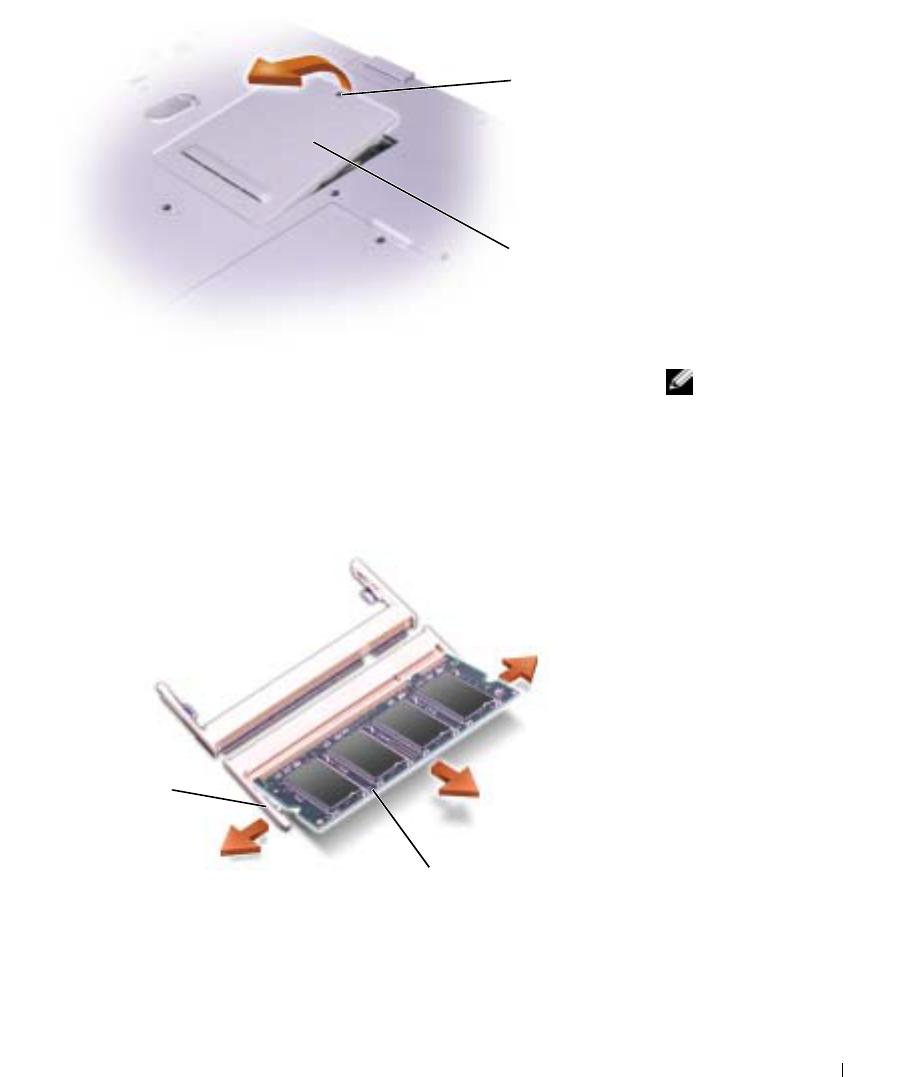
Adding and Replacing Parts 95
NOTE: Memory modules
purchased from Dell are
covered under your
computer warranty.
3If you are replacing a memory module, remove the existing module:
aUse your fingertips to carefully spread apart the securing clips on
each end of the memory module connector until the module
pops up.
bRemove the module from the connector.
screw
memory
module cover
securing clips
memory module
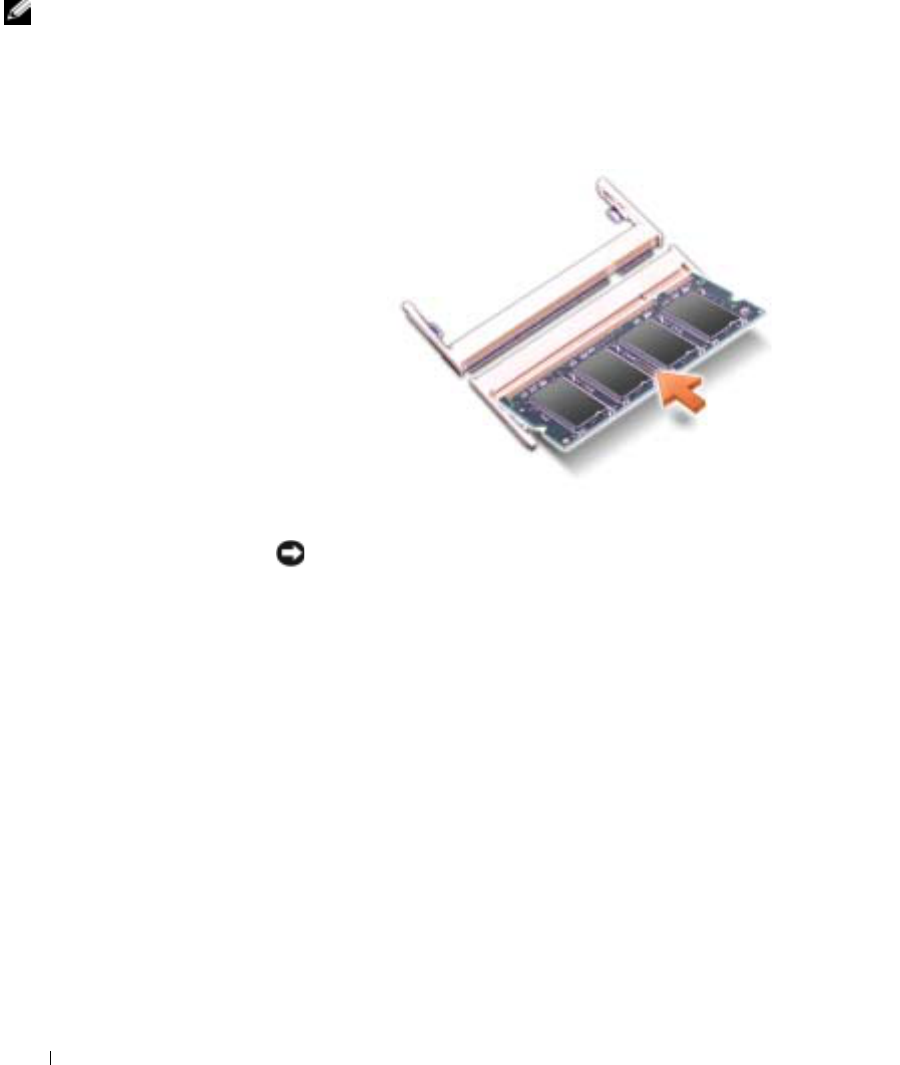
96 Adding and Replacing Parts
www.dell.com | support.dell.com
4Ground yourself and install the new memory module:
NOTE: If the memory
module is not installed
properly, the computer
may not boot properly. No
error message indicates
this failure.
aAlign the notch in the module edge connector with the tab in the
connector slot.
bSlide the module firmly into the slot at a 45-degree angle, and
rotate the module down until it clicks into place. If you do not feel
the click, remove the module and reinstall it.
5Replace the cover.
NOTICE: If the memory module cover is difficult to close, remove the module
and reinstall it. Forcing the cover to close may damage your computer.
6Insert the battery into the battery bay, or connect the AC adapter to
your computer and an electrical outlet.
7Turn on the computer.
As the computer boots, it detects the additional memory and automatically
updates the system configuration information.
To confirm the amount of memory installed in the computer, click the Start
button, click Help and Support, and then click Computer Information.
Modem and Mini PCI Card
1Complete the instructions in "Before You Add or Replace Parts" on
page 94.
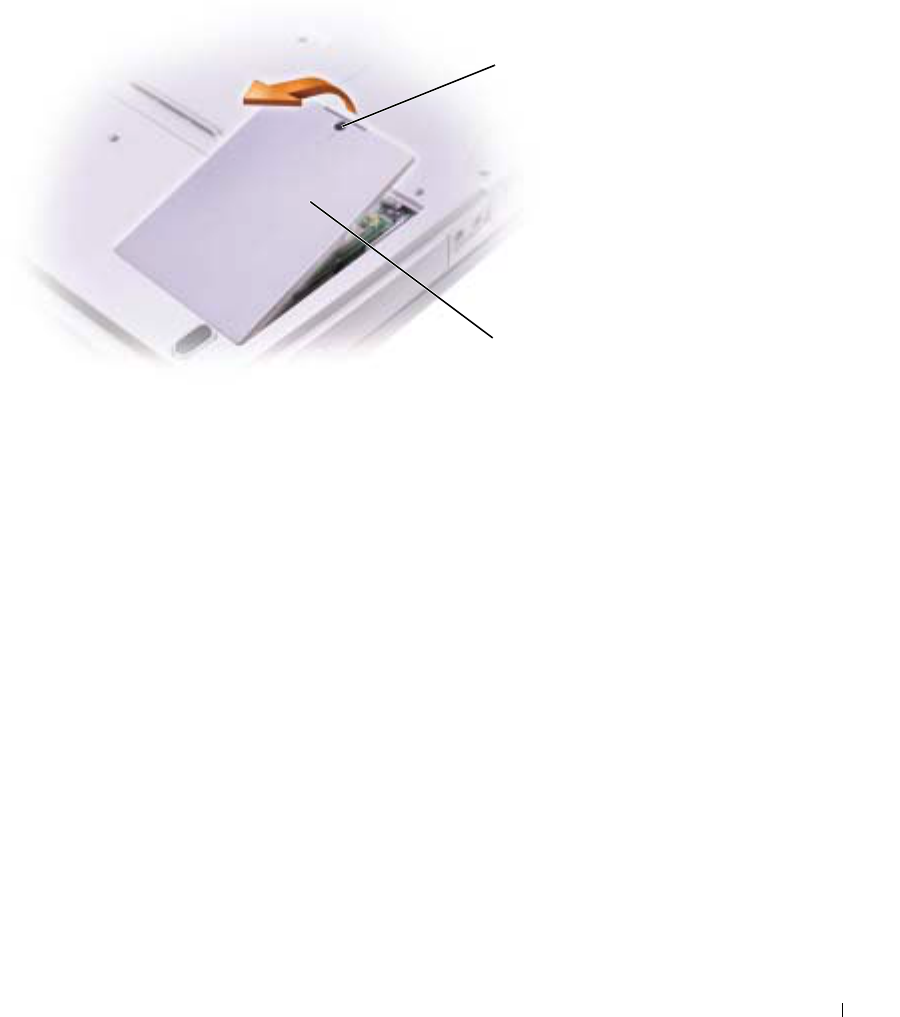
Adding and Replacing Parts 97
2Turn the computer over, remove the screw from the modem/Mini PCI
card cover, and lift the cover away from the computer.
3Continue to the appropriate section:
• To add a modem, see the following section, "Adding a Modem."
• To add a Mini PCI card, see page 98.
Adding a Modem
If you ordered the optional modem at the same time that you ordered your
computer, Dell installed the modem for you.
1When you replace the modem, remove the existing modem:
aRemove the screws securing the modem to the system board, and
set them aside.
bPull straight up on the attached pull-tab to lift the modem out of
its connector on the system board and disconnect the modem
cable.
screw
modem/Mini
PCI card cover
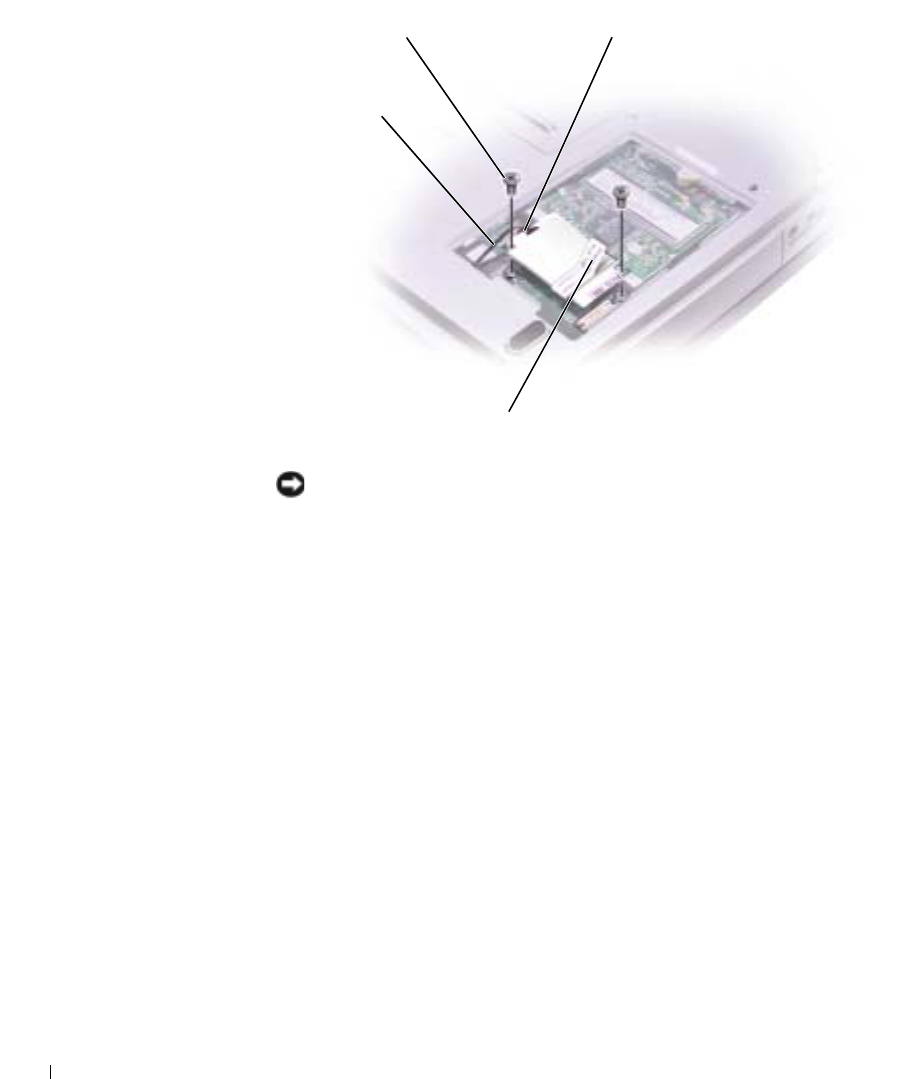
98 Adding and Replacing Parts
www.dell.com | support.dell.com
2Connect the modem cable to the modem.
NOTICE: The cable connectors are keyed for correct insertion; do not force
the connections.
3Align the modem with the screw holes, and press the modem into the
connector on the system board.
4Install the screws to secure the modem to the system board.
5Replace the cover.
Adding a Mini PCI Card
If you ordered a Mini PCI card with your computer, the card is already
installed.
1If a Mini PCI card is not already installed, go to step 2. If you are
replacing a Mini PCI card, remove the existing card:
aDisconnect the Mini PCI card from any attached cables.
modem cable connector
modem cable
pull-tab
screws (2)
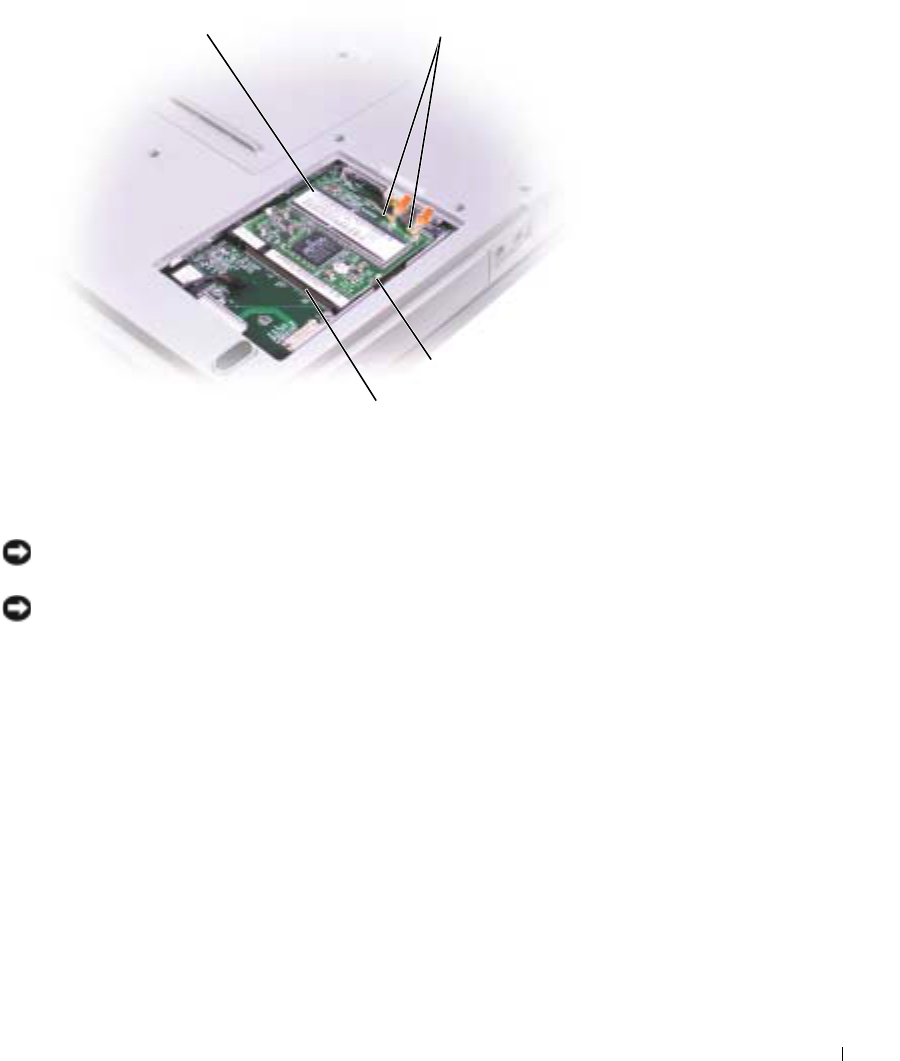
Adding and Replacing Parts 99
bRelease the Mini PCI card by spreading the metal securing tabs
until the card pops up slightly.
cLift the Mini PCI card out of its connector.
NOTICE: To avoid damaging the Mini PCI card, never place cables on top of
or under the card.
NOTICE: The connectors are keyed to ensure correct insertion. If you feel
resistance, check the connectors and realign the card.
2Align the Mini PCI card with the connector at a 45-degree angle, and
press the Mini PCI card into the connector until you hear a click.
Mini PCI card
Mini PCI card connector
antenna cables
metal securing tabs (2)
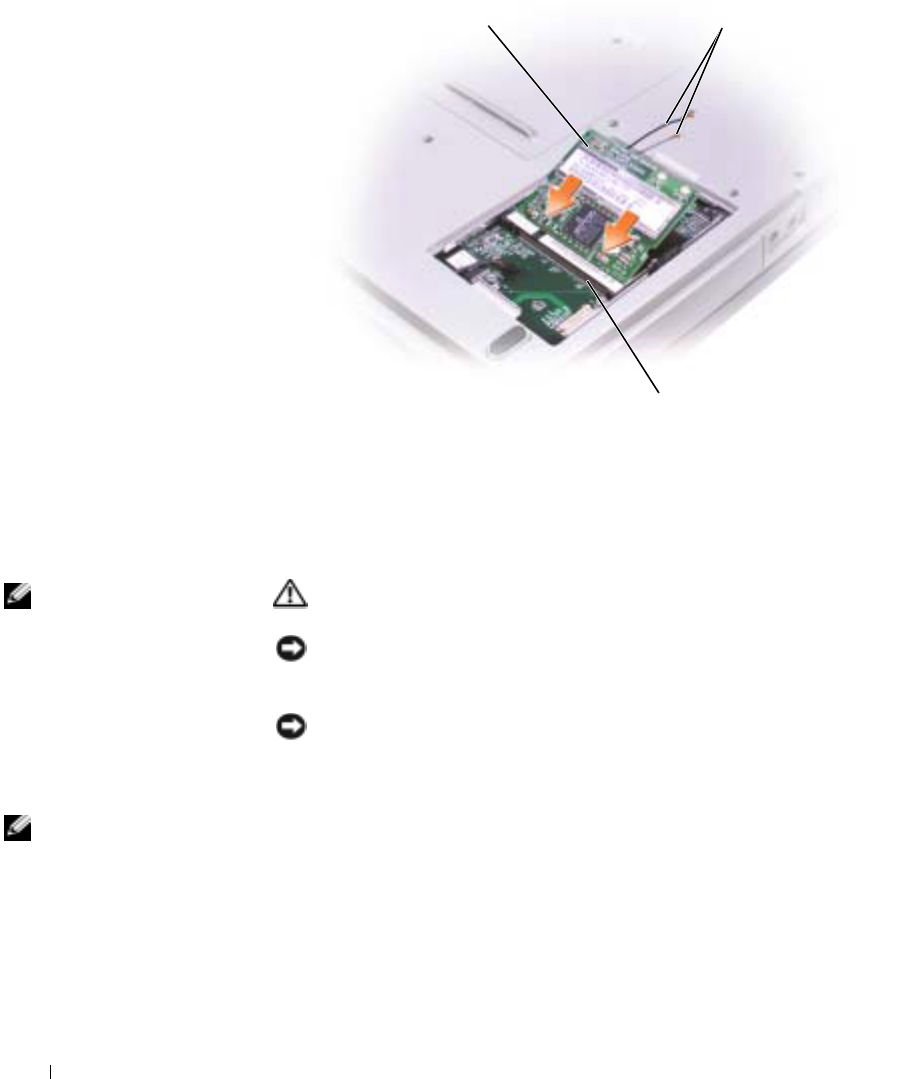
100 Adding and Replacing Parts
www.dell.com | support.dell.com
3Connect the antenna cables to the Mini PCI card.
4Replace the cover and screw.
Hard Drive
NOTE: You need the
Operating System
CD to
install the Microsoft®
Windows® operating
system. You also need the
Drivers and Utilities
CD
for your computer to
install the drivers and
utilities on the new hard
drive.
CAUTION: If you remove the hard drive from the computer when
the drive is hot,
do not touch
the metal housing of the hard drive.
NOTICE: To prevent data loss, shut down your computer (see page 39) before
removing the hard drive. Do not remove the hard drive while the computer is
on, in standby mode, or in hibernate mode.
NOTICE: Hard drives are extremely fragile; even a slight bump can damage
the drive.
NOTE: Dell does not
guarantee compatibility
or provide support for
hard drives from sources
other than Dell.
To replace the hard drive in the hard drive bay:
1Complete the instructions in "Before You Add or Replace Parts" on
page 94.
2Turn the computer over, and remove the hard drive screws.
Mini PCI card
Mini PCI card connector
antenna cables
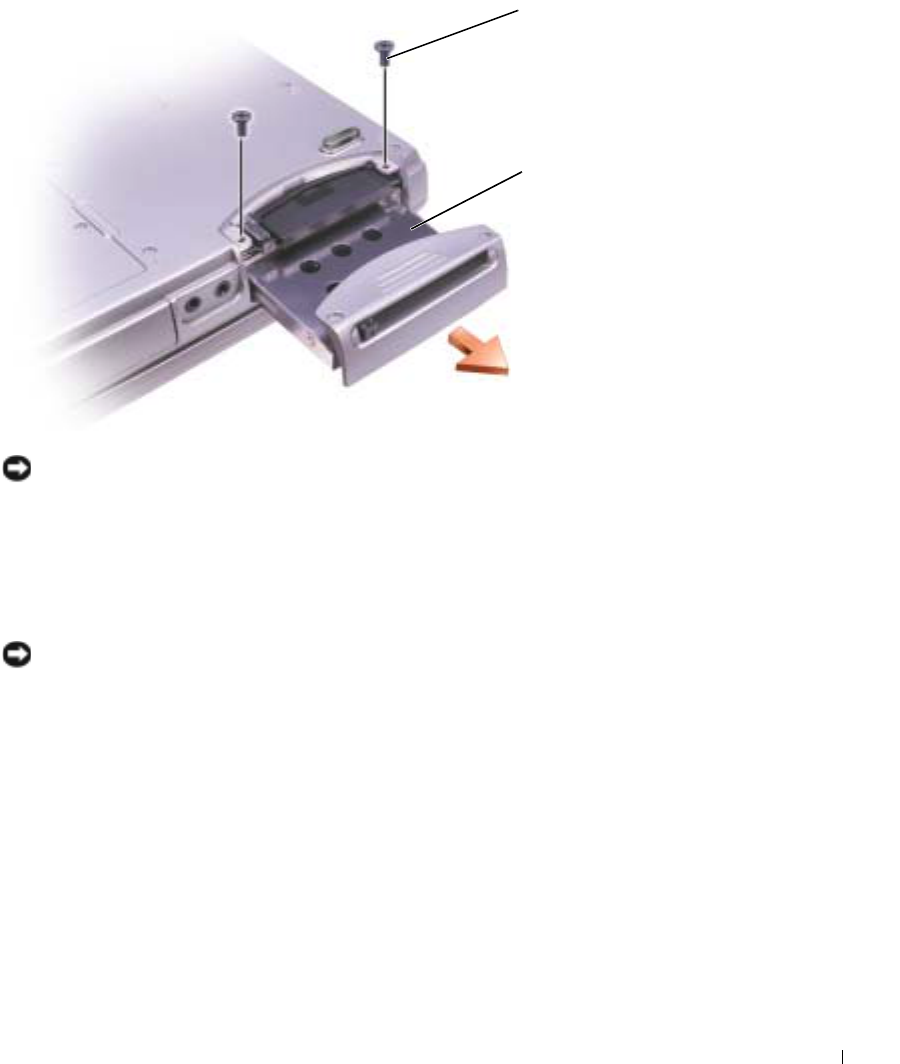
Adding and Replacing Parts 101
NOTICE: When the hard drive is not in the computer, store it in protective
antistatic packaging. See "Protecting Against Electrostatic Discharge" on
page 17.
3Slide the hard drive out of the computer.
4Remove the new drive from its packaging.
Save the original packaging for storing or shipping the hard drive.
NOTICE: Use firm and even pressure to slide the drive into place. If you use
excessive force, you may damage the connector.
5Insert the drive into the bay, and push the hard drive until it is fully
seated in the bay.
6Replace and tighten the screws.
7Use the Operating System CD to install the operating system for your
computer (see page 89).
8Use the Drivers and Utilities CD to install the drivers and utilities for
your computer (see page 83).
screws (2)
hard drive
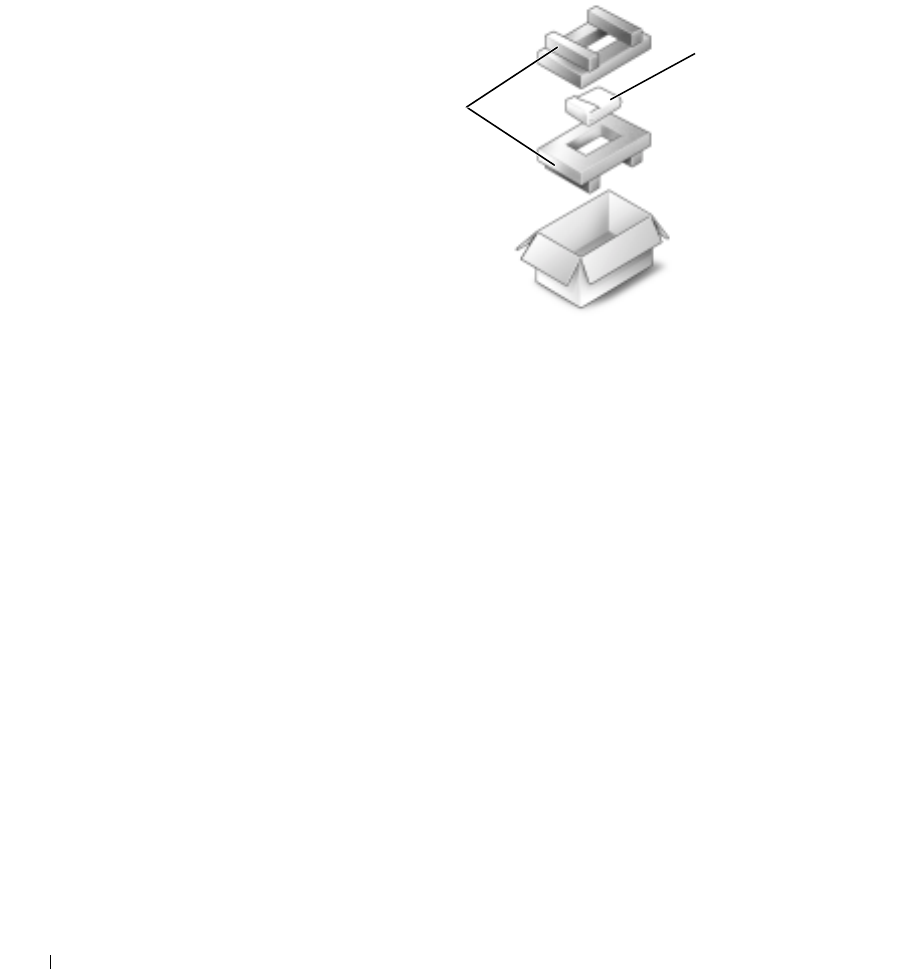
102 Adding and Replacing Parts
www.dell.com | support.dell.com
Returning a Hard Drive to Dell
Return your old hard drive to Dell in its original or comparable foam
packaging. Otherwise, the hard drive may be damaged in transit.
CD or DVD Drive
1Complete the instructions in "Before You Add or Replace Parts" on
page 94.
2Turn the computer over, remove the screw from the memory module
cover, and lift the cover away from the computer.
hard drive
foam
packaging
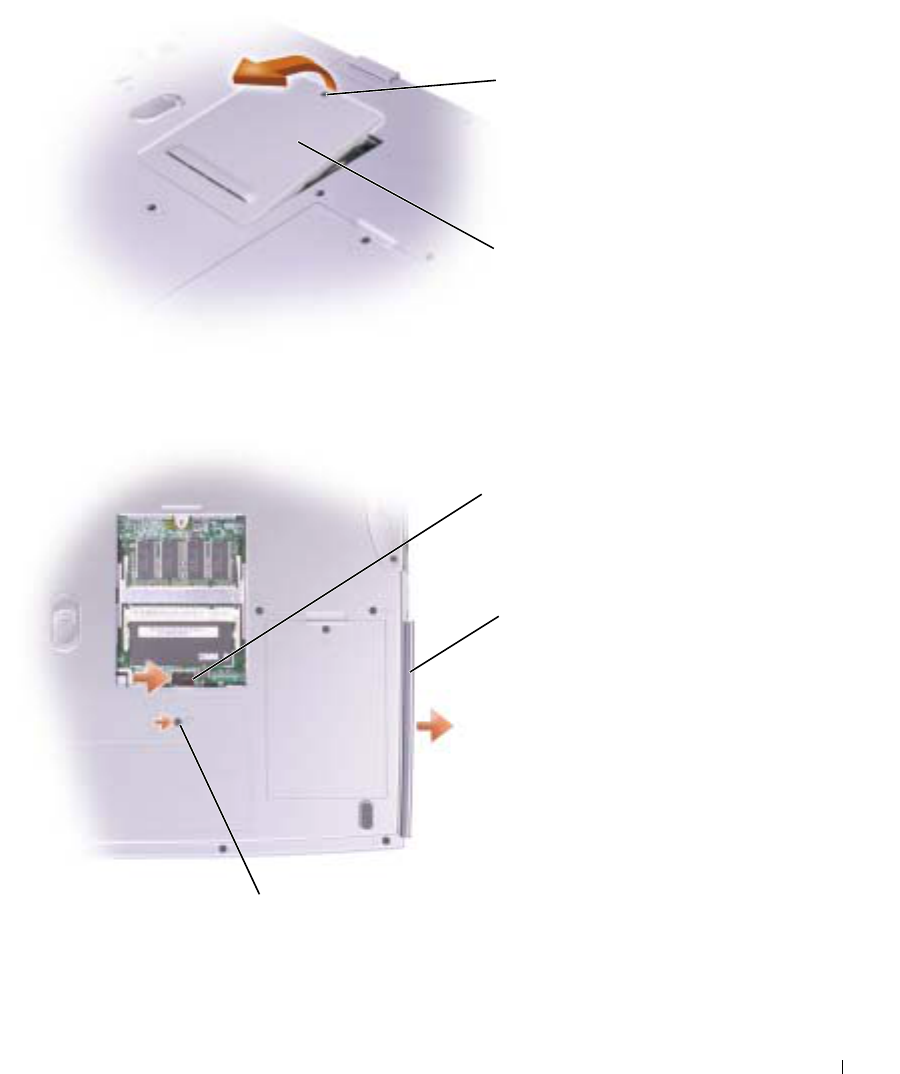
Adding and Replacing Parts 103
3Remove the screw labeled "O" next to the memory module cover.
4Press the lever next to the memory module connectors in the direction
of the arrow on the lever (towards the drive) to release the drive.
screw
memory
module cover
screw
lever
CD or DVD
drive
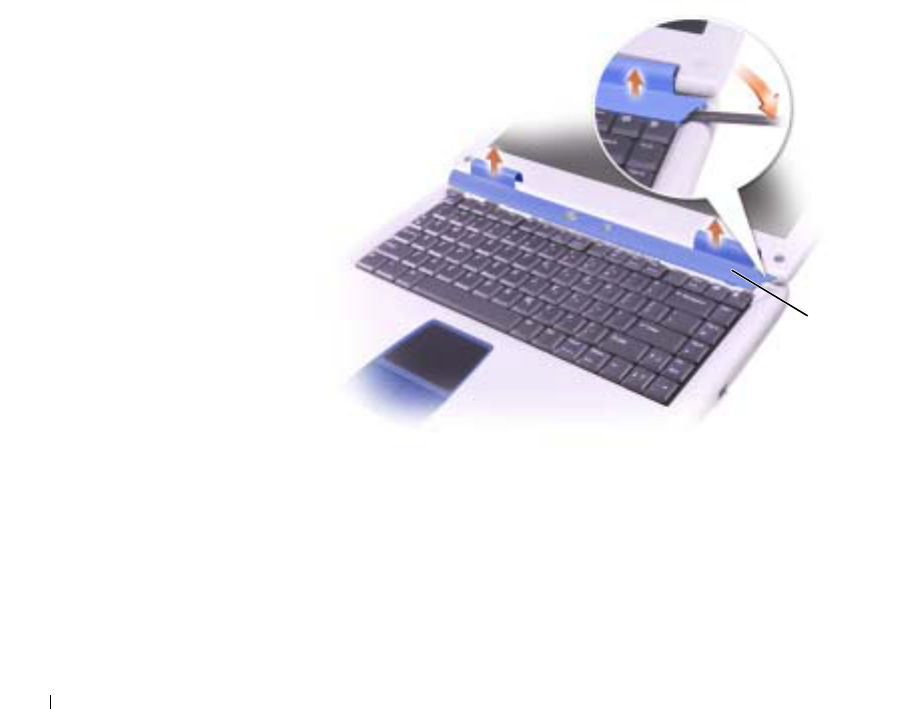
104 Adding and Replacing Parts
www.dell.com | support.dell.com
5Pull the drive out of the bay.
6Slide the new drive into the bay until the drive is fully seated.
7Replace the screw that you removed in step 3.
8Replace the memory module cover and screw.
Keyboard
1Complete the instructions in "Before You Add or Replace Parts" on
page 94.
2Use a small flat-blade screwdriver or plastic scribe to lift the notched
right edge of the hinge cover, and pry the cover loose from the hinges
and bottom case.
3Lift the hinge cover up and away from the hinges and bottom case.
4Remove the four keyboard screws.
hinge cover
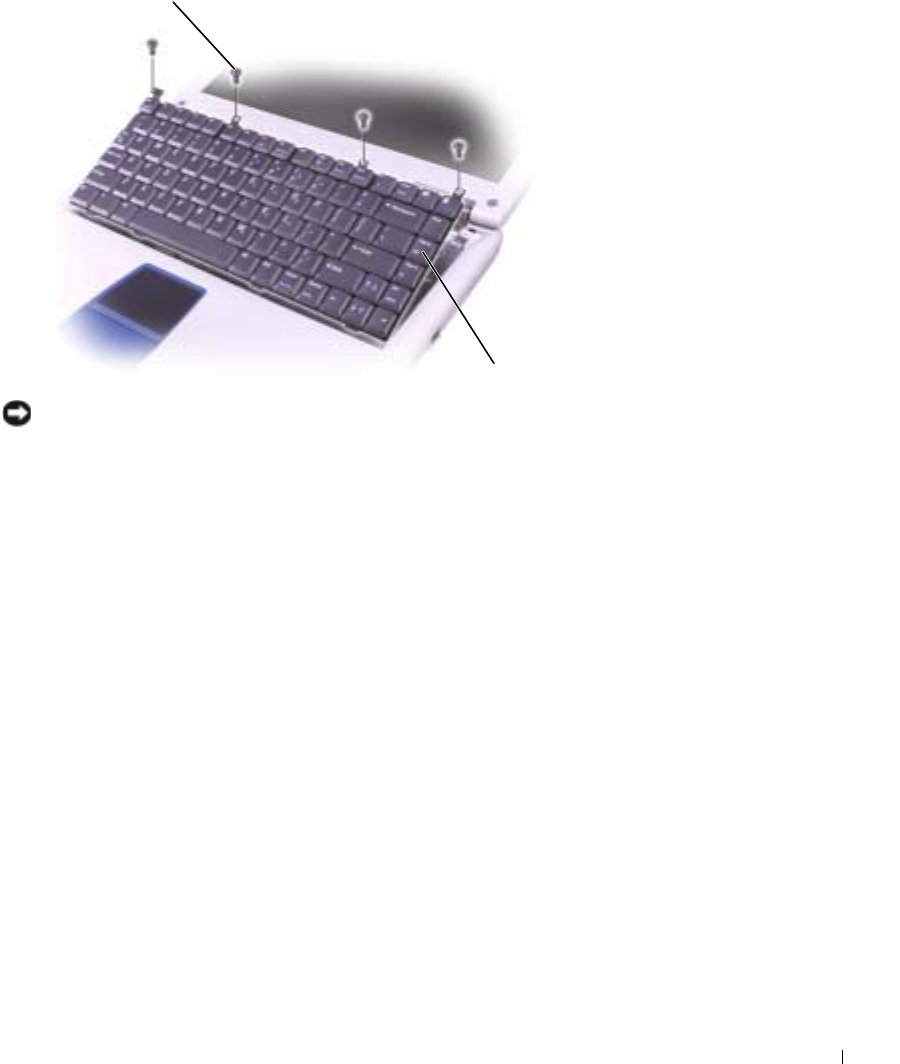
Adding and Replacing Parts 105
NOTICE: The keycaps on the keyboard are fragile, easily dislodged, and time-
consuming to replace. Be careful when removing and handling the keyboard.
5Lift the keyboard out of the bottom case, and rest it on the display
hinges so that the keyboard connector is exposed.
6Pull up on the keyboard connector to disconnect it from the interface
connector on the system board.
screws (4)
keyboard
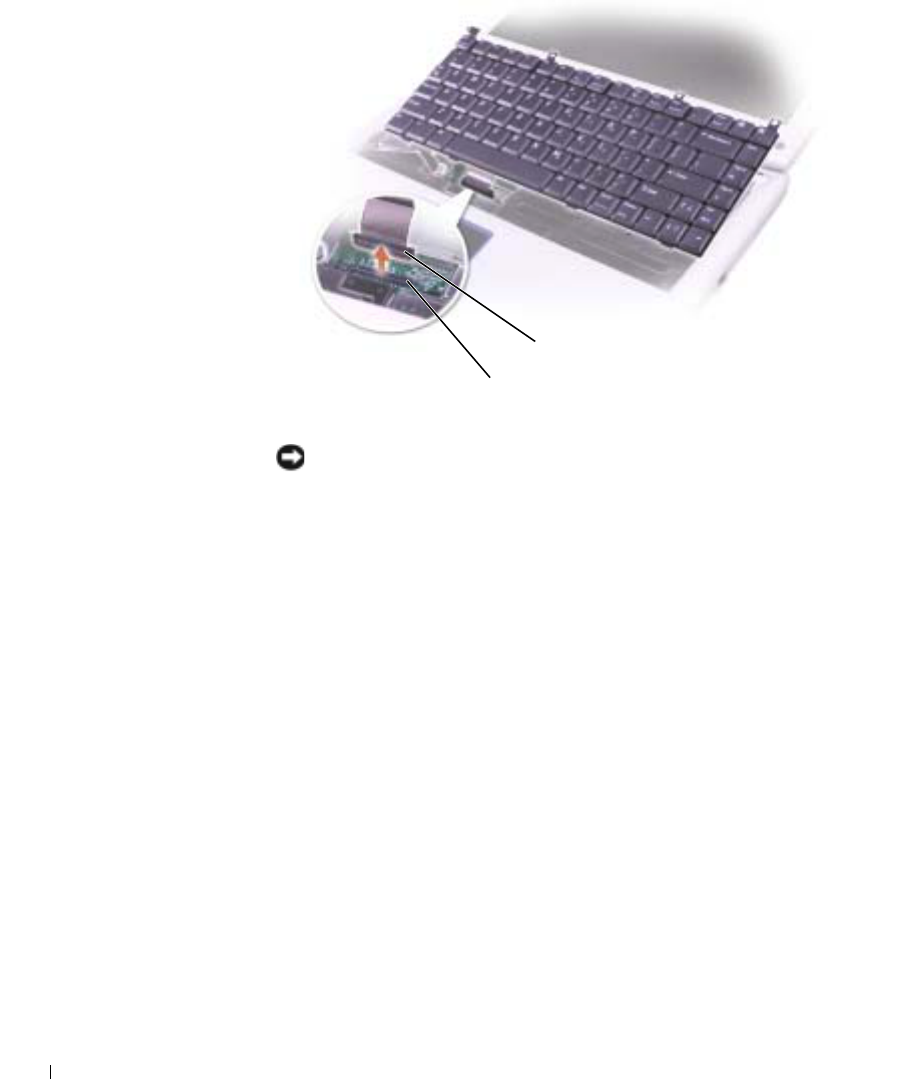
106 Adding and Replacing Parts
www.dell.com | support.dell.com
7Remove the keyboard from the bottom case.
NOTICE: To avoid damage to the connector pins, press the keyboard
connector evenly into the interface connector on the system board, and do not
reverse the keyboard connector.
8Connect the keyboard connector of the replacement keyboard to the
interface connector on the system board.
interface connector
keyboard connector
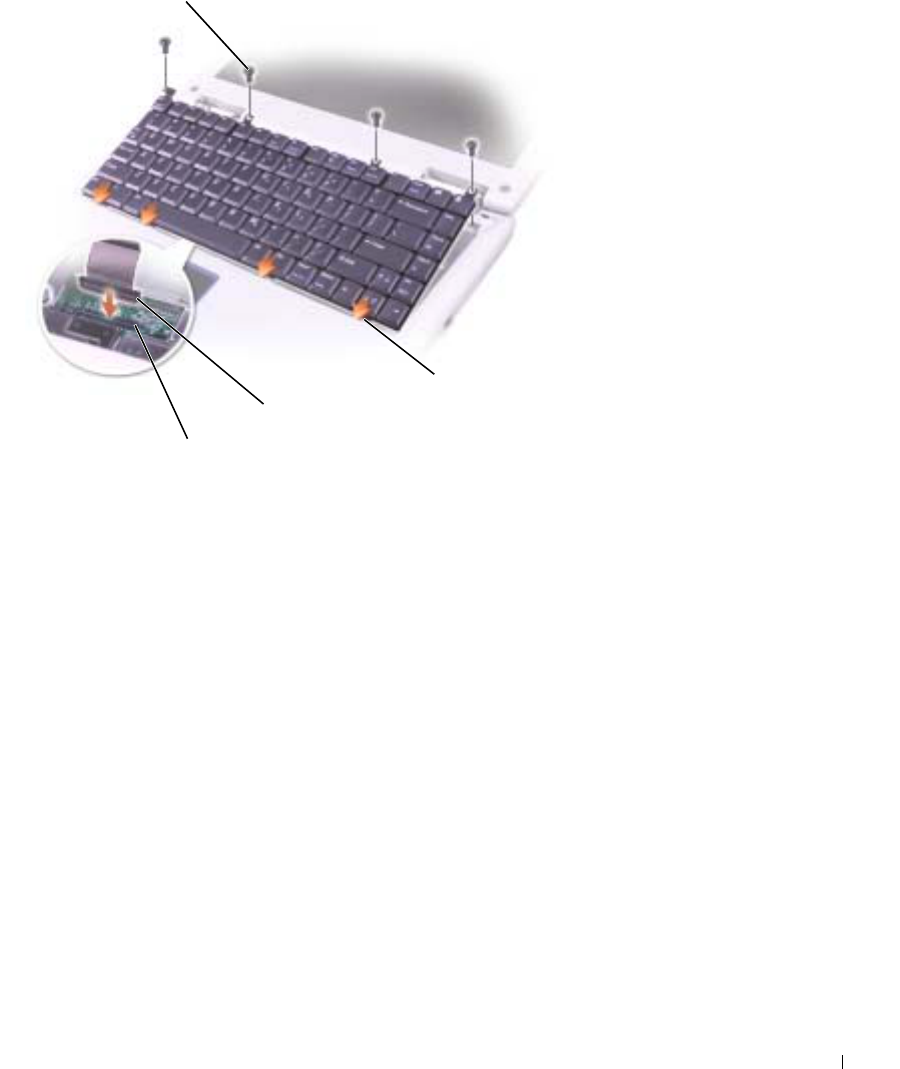
Adding and Replacing Parts 107
9Insert the four securing tabs on the keyboard into their respective slots
in the palm rest, and lower the keyboard into the bottom case.
Ensure that all four securing tabs are engaged before trying to
completely seat the keyboard.
10 Replace the four keyboard screws.
11 Replace the hinge cover.
interface connector
keyboard connector
screws
(4)
securing tabs (4)

108 Adding and Replacing Parts
www.dell.com | support.dell.com

110 Appendix
www.dell.com | support.dell.com
Specifications
NOTE: Power
management features
limit the processor speed
when the computer is
running on battery power,
to maintain system
cooling requirements,
and/or to maintain system
power requirements.
Microprocessor
Microprocessor Intel® Pentium® 4 processor
L1 cache 8 KB (internal)
L2 cache 512 KB (Intel Pentium 4)
External bus frequency 533 MHz
System Information
System chip set Intel 845PE
Data bus width 64 bits
DRAM bus width 64 bits
Microprocessor address bus width 32 bits
PC Card
CardBus controller TI PCI4510
PC Card connector supports one Type I or Type II card
Cards supported 3.3 V and 5 V
PC Card connector size 68 pins
Data width (maximum) PCMCIA 16 bits
CardBus 32 bits

Appendix 111
Memory
Memory module connector one user-accessible SODIMM socket
Memory module capacities 64, 128, 256, and 512 MB
Memory type 3.3-V SODIMM
Standard memory 128 MB
Maximum memory 1 GB
Memory access time: clock speed 266 MHz
Ports and Connectors
Video 15-hole connector
Audio microphone connector, stereo
headphone/speakers connector
USB (2) 4-pin USB 2.0-compliant connector
Modem RJ-11 connector
Ethernet LAN RJ-45 connector (optional in some
countries)
S-video TV-out 7-pin mini-DIN connector
IEEE 1394 4-pin serial connector
Communications
Modem:
Type v.92 56K MDC
Controller softmodem
Interface internal AC 97 bus
Network adapter 10/100 Ethernet LAN on system board

112 Appendix
www.dell.com | support.dell.com
Video
Video type external ATI discrete graphic solution
Host interface external 4x AGP
Video controller ATI Mobility Radeon 7500
Video memory 16 MB or 32 MB
LCD interface SPWG-A
Audio
Audio type AC97 (Soft Audio)
Audio controller Sigmatel 9750
Stereo conversion 18-bit (analog-to-digital and digital-to-
analog)
Interfaces:
Internal PCI bus /AC 97
External microphone-in connector, stereo
headphones/speakers connector
Speaker two 4-ohm speakers
Internal speaker amplifier 1.0-W channel into 4 ohms
Volume controls keyboard shortcuts, program menus

Appendix 113
Display
Type (active-matrix TFT) XGA or SXGA+
Dimensions: 14.1 inch or 15 inch
Height:
14.1 inch
15 inch 215.8 mm (8.5 inches)
229.7 mm (9 inches)
Width:
14.1 inch
15 inch 287.1 mm (11.3 inches)
305.7 mm (12 inches)
Diagonal:
14.1 inch
15 inch 359.16 mm (14.1 inches)
382.4 mm (15.1 inches)
Maximum resolutions 1024 x 768 at 16.8 million colors (XGA);
1400 x 1050 at 16.8 million colors (SXGA+)
Response time (typical) 20-ms rise (maximum),
30-ms fall (maximum)
Refresh rate 60 Hz
Operating angle 0° (closed) to 180°
Viewing angles:
Horizontal ±40°
Vertical +10°/–30°
Pixel pitch 0.28 x 0.28 mm (XGA)
0.20 x 0.20 mm (SXGA+)
Power consumption:
Panel with backlight (typical) 6.5 W (XGA)
7.0 W (SXGA+)
Controls brightness can be controlled through
keyboard shortcuts

114 Appendix
www.dell.com | support.dell.com
Keyboard
Number of keys 85 (U.S. and Canada); 86 (Europe);
90 (Japan)
Key travel 2.7 mm ± 0.3 (0.11 inch ± 0.016 inch)
Key spacing 19.05 mm ± 0.3 mm (0.75 inch ± 0.012 inch)
Layout QWERTY/AZERTY/Kanji
Touch Pad
X/Y position resolution
(graphics table mode) 240 cpi
Size:
Width 64.88 mm (2.55-inch) sensor-active area
Height 48.88-mm (1.92-inch) rectangle
Battery
Type 12 cell, "smart" lithium ion (94 WHr)
Dimensions:
Depth 122.5 mm (4.8 inches)
Height 19.2 mm (0.76 inch)
Width 147.5 mm (5.8 inches)
Weight 0.615 kg (1.35 lb) (12 cell)
Voltage 14.8 VDC
Operating life approximately 1.5 to 3 hours with 12-cell
battery; can be significantly reduced under
certain power-intensive conditions
See page 42 for more information on battery
life.
Life span (approximate) 500 discharge/charge cycles0

Appendix 115
Temperature range:
Operating 0°to 35°C(32°to 95°F)
Storage –40° to 65°C (–40° to 149°F)
AC Adapter
Input voltage 100 to 240 VAC
Input current (maximum) 1.5 A
Input frequency 50 to 60 Hz
Output current 4.5 A (maximum at 4-second pulse);
3.5 A (continuous)
Output power 90 W standard
Rated output voltage 20 VDC
Dimensions:
Height 29 mm (1.4 inches)
Width 51 mm (2.0 inches)
Depth 115 mm (4.52 inches)
Weight (with cables) 0.3 kg (0.66 lb)
Temperature range:
Operating 0° to 35°C (32° to 95°F)
Storage –40° to 65°C (–40° to 149°F)
Physical
Height
14.1-inch display 43.7 mm (1.72 inches)
15-inch display 46.5 mm (1.83 inches)
Width 274 mm (10.8 inches)
Depth 328 mm (12.9 inches)
Battery
(continued)

116 Appendix
www.dell.com | support.dell.com
Weight:
With CD drive, 12-cell battery,
and 14.1-inch display 3334 g (7.35 lb)
With CD drive, 12-cell battery,
and 15-inch display 3583 g (7.90 lb)
Environmental
Temperature range:
Operating 0° to 35°C (32° to 95°F)
Storage –40° to 65°C (–40° to 149°F)
Relative humidity (maximum):
Operating 10% to 90% (noncondensing)
Storage 5% to 95% (noncondensing)
Maximum vibration:
Operating 0.9 GRMS
Storage 1.3 GRMS
Maximum shock (measured with the
hard drive in head-parked position
and 2-ms half-sine pulse):
Operating 122 G
Storage 163 G
Altitude (maximum):
Operating –15.2 to 3048 m (–50 to 10,000 ft)
Storage –15.2 to 10,668 m (–50 to 35,000 ft)
Physical
(continued)

Appendix 117
Using the System Setup Program
Overview
NOTE: Your operating
system may automatically
configure most of the
options available in the
system setup program,
thus overriding options
that you set through the
system setup program.
(An exception is the
External Hot Key option,
which you can disable or
enable only through the
system setup program.)
For more information on
configuring features for
your operating system,
see the Help and Support
Center. To access help, see
page 74.
The system setup screens display the current setup information and settings
for your computer, such as:
• System configuration
•Boot order
• Boot (start-up) configuration and docking-device configuration
settings
• Basic device configuration settings
• System security and hard-drive password settings
NOTICE: Unless you are an expert computer user or are directed to do so by
Dell technical support, do not change the settings for the system setup
program. Certain changes might make your computer work incorrectly.
Viewing the System Setup Screens
1Turn on (or restart) your computer.
2When the DELL™ logo appears, press immediately. If you wait
too long and the Windows logo appears, continue to wait until you see
the Windows desktop. Then shut down your computer (see page 39)
and try again.
System Setup Screens
NOTE: For information
about a specific item on a
system setup screen,
highlight the item and see
the Help area on the
screen.
On each screen, the system setup options are listed at the left. To the right
of each option is the setting or value for that option. You can change
settings that appear as white type on the screen. Options or values that you
cannot change (because they are determined by the computer) appear less
bright.
The upper-right corner of the screen displays help information for the
currently highlighted option; the lower-right corner displays information
about the computer. System setup key functions are listed across the
bottom of the screen.
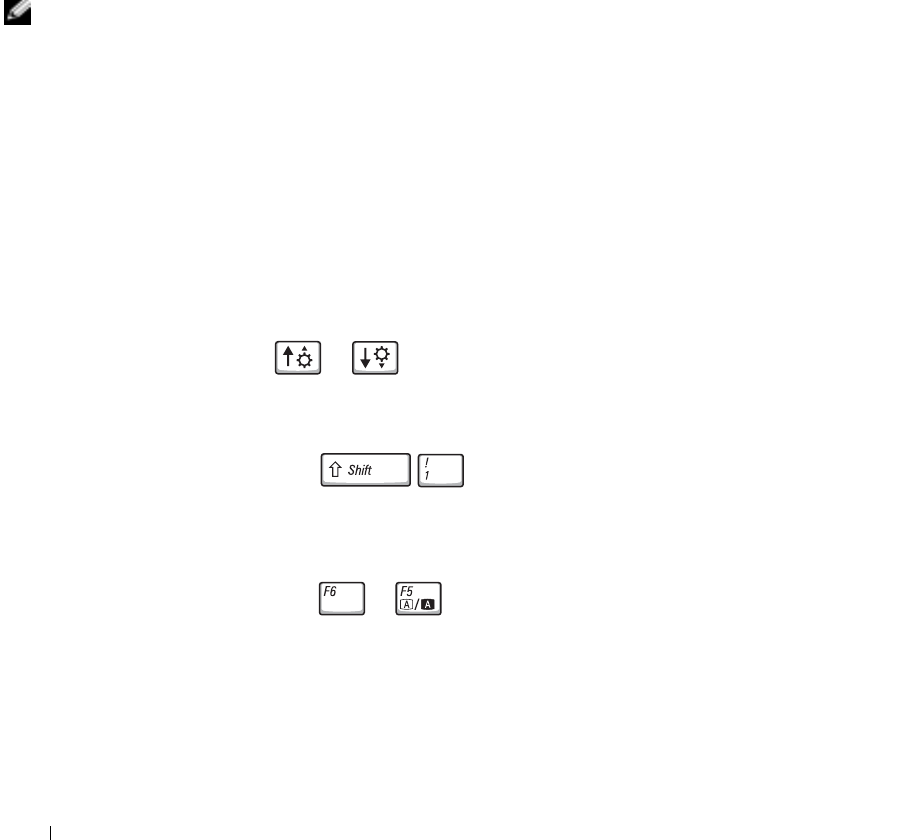
118 Appendix
www.dell.com | support.dell.com
Commonly Used Options
Certain options require that you reboot the computer for new settings to
take effect.
Changing the Boot Sequence
The boot sequence, or boot order, tells the computer where to look to find the
software needed to start the operating system. You can control the boot
sequence and enable/disable devices using the Boot Order page of the
system setup program.
NOTE: To change the
boot sequence on a one-
time-only basis, see
page 119.
The Boot Order page displays a general list of the bootable devices that may
be installed in your computer, including but not limited to the following:
•Diskette Drive
•Modular bay HDD
•Internal HDD
•CD/DVD/CD-RW drive
During the boot routine, the computer starts at the top of the list and scans
each enabled device for the operating system start-up files. When the
computer finds the files, it stops searching and starts the operating system.
To control the boot devices, select (highlight) a device by pressing the
or key, and then enable or disable the device or change its
order in the list.
• To enable or disable a device, highlight the item and press
. Enabled items appear as white and display an
exclamation point to the left; disabled items appear blue or dimmed
without a triangle.
• To reorder a device in the list, highlight the device and then press
or (not case-sensitive) to move the highlighted device up
or down.
Boot sequence changes take effect as soon as you save the changes and exit
the system setup program.

Appendix 119
Performing a One-Time Boot
You can set a one-time-only boot sequence without entering the system
setup program. (You can also use this procedure to boot the Dell
Diagnostics on the diagnostics utility partition on your hard drive.)
1Turn off the computer.
2If the computer is connected to a docking device (docked), undock it.
See the documentation that came with your docking device for
instructions.
3Connect the computer to an electrical outlet.
4Turn on the computer. When the DELL logo appears, press
immediately. If you wait too long and the Windows logo appears,
continue to wait until you see the Windows desktop. Then shut down
your computer and try again.
5When the boot device list appears, highlight the device from which
you want to boot and press .
The computer boots to the selected device.
The next time you reboot the computer, the previous boot order is restored.
System and Battery Performance
Optimization
System Performance Overview
System performance may be reduced under specific conditions to prevent
automatic system shutdown and potential data loss. Conditions under
which performance is reduced include:
PROCESSOR GETS HOT —Performance is reduced when system temperature
exceeds established thermal parameters. This performance reduction helps to
regulate the system and surface temperatures, which prevents the computer from
shutting down due to excessive processor temperatures.
AC ADAPTER THROUGHPUT —Performance is reduced when the computer is
running on AC power and power consumption exceeds the established parameters of
the AC Adapter. This performance reduction ensures that the system does not try to
consume more power than the AC adapter can provide.

120 Appendix
www.dell.com | support.dell.com
BATTERY CAPACITY —Performance is reduced when the computer is running
on battery power and power consumption exceeds the established parameters of the
battery’s rated capacity or exceeds allowable safe discharge levels, or when the
battery surface temperature exceeds 60°C.
Optimizing Power Consumption and Battery Charge Time
The AC adapter charges a completely discharged battery in approximately
3 hours with the computer turned off. Charge time is significantly longer if
the computer is on and running at high processor speeds and system activity
levels. If you run your computer at high system activity levels for extended
periods of time and your battery is not charging, try running your system in
Low Power Mode. Low Power Mode can improve battery charge time and
battery life. Depending on system activity levels, system performance may
be reduced. To set Low Power Mode:
NOTE: You can also click
the power meter icon on
the taskbar.
1Click the Start button→ Control Panel→ Performance and
Maintenance→ Power Options.
2Click the Power Schemes tab.
3In the Power schemes drop-down menu, click Low Power Mode.
For more information on power management, see the Tell Me How help file.
To access the help file, see page 74.
Variable Speed Fan
The computer uses a variable speed fan to prevent the computer from
overheating. The fan runs constantly, and fan speed may vary depending on
usage. Fan noise is normal and does not indicate a problem with the fan or
the computer.

Appendix 121
Dell Technical Support Policy
(U.S. Only)
Technician-assisted technical support requires the cooperation and
participation of the customer in the troubleshooting process and provides
for restoration of the operating system, software programs, and hardware
drivers to the original default configuration as shipped from Dell, as well as
the verification of appropriate functionality of the computer and all Dell-
installed hardware. In addition to this technician-assisted technical support,
online technical support is available at support.dell.com. Additional
technical support options may be available for purchase.
Dell provides limited technical support for the computer and any "Dell-
installed" software and peripherals1. Support for third-party software and
peripherals is provided by the original manufacturer, including those
purchased and/or installed through Dell Software and Peripherals,
Readyware, and Custom Factory Integration2.
1 Repair services are provided pursuant to the terms and conditions of your limited
warranty and any optional support service contract purchased with the
computer.
2 All Dell-standard components included in a Custom Factory Integration (CFI)
project are covered by the standard Dell limited warranty for your computer.
However, Dell also extends a parts replacement program to cover all nonstand-
ard, third-party hardware components integrated through CFI for the duration
of the computer’s service contract.
Definition of "Dell-Installed" Software and Peripherals
Dell-installed software includes the operating system and some of the
software program that is installed on the computer during the
manufacturing process (Microsoft Office, Norton Antivirus, and so on).
Dell-installed peripherals include any internal expansion cards, or Dell-
branded module bay or PC Card accessories. In addition, any Dell-branded
monitors, keyboards, mice, speakers, microphones for telephonic modems,
docking stations/port replicators, networking products, and all associated
cabling are included.
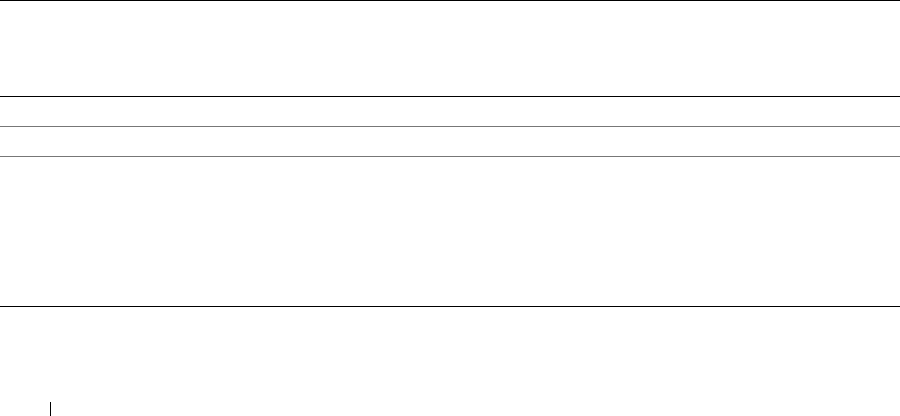
122 Appendix
www.dell.com | support.dell.com
Definition of "Third-Party" Software and Peripherals
Third-party software and peripherals include any peripheral, accessory, or
software program sold by Dell not under the Dell brand (printers, scanners,
cameras, games, and so on). Support for all third-party software and
peripherals is provided by the original manufacturer of the product.
Contacting Dell
To contact Dell electronically, you can access the following websites:
•www.dell.com
•support.dell.com (technical support)
•premiersupport.dell.com (technical support for educational,
government, healthcare, and medium/large business customers,
including Premier, Platinum, and Gold customers)
For specific web addresses for your country, find the appropriate country
section in the table below.
NOTE: Toll-free numbers are for use within the country for which they are listed.
When you need to contact Dell, use the electronic addresses, telephone
numbers, and codes provided in the following table. If you need assistance
in determining which codes to use, contact a local or an international
operator.
Country (City)
International Access Code
Country Code
City Code
Department Name or Service Area,
Website and E-Mail Address Area Codes,
Local Numbers, and
Toll-Free Numbers
Anguilla General Support toll-free: 800-335-0031
Antigua and Barbuda General Support 1-800-805-5924
Argentina (Buenos Aires)
International Access Code: 00
Country Code: 54
City Code: 11
Website: www.dell.com.ar
Tech Support and Customer Care toll-free: 0-800-444-0733
Sales 0-810-444-3355
Tech Support Fax 11 4515 7139
Customer Care Fax 11 4515 7138

Appendix 123
Aruba General Support toll-free: 800-1578
Australia (Sydney)
International Access Code: 0011
Country Code: 61
City Code: 2
E-mail (Australia): au_tech_support@dell.com
E-mail (New Zealand): nz_tech_support@dell.com
Home and Small Business 1-300-65-55-33
Government and Business toll-free: 1-800-633-559
Preferred Accounts Division (PAD) toll-free: 1-800-060-889
Customer Care toll-free: 1-800-819-339
Corporate Sales toll-free: 1-800-808-385
Transaction Sales toll-free: 1-800-808-312
Fax toll-free: 1-800-818-341
Austria (Vienna)
International Access Code: 900
Country Code: 43
City Code: 1
Website: support.euro.dell.com
E-mail: tech_support_central_europe@dell.com
Home/Small Business Sales 01 795 67602
Home/Small Business Fax 01 795 67605
Home/Small Business Customer Care 01 795 67603
Preferred Accounts/Corporate Customer Care 0660 8056
Home/Small Business Technical Support 01 795 67604
Preferred Accounts/Corporate Technical Support 0660 8779
Switchboard 01 491 04 0
Bahamas General Support toll-free: 1-866-278-6818
Barbados General Support 1-800-534-3066
Country (City)
International Access Code
Country Code
City Code
Department Name or Service Area,
Website and E-Mail Address Area Codes,
Local Numbers, and
Toll-Free Numbers

124 Appendix
www.dell.com | support.dell.com
Belgium (Brussels)
International Access Code: 00
Country Code: 32
City Code: 2
Website: support.euro.dell.com
E-mail: tech_be@dell.com
E-mail for French Speaking Customers:
support.euro.dell.com/be/fr/emaildell/
Technical Support 02 481 92 88
Customer Care 02 481 91 19
Home/Small Business Sales toll-free: 0800 16884
Corporate Sales 02 481 91 00
Fax 02 481 92 99
Switchboard 02 481 91 00
Bermuda General Support 1-800-342-0671
Bolivia General Support toll-free: 800-10-0238
Brazil
International Access Code: 00
Country Code: 55
City Code: 51
Website: www.dell.com/br
Customer Support, Technical Support 0800 90 3355
Tech Support Fax 51 481 5470
Customer Care Fax 51 481 5480
Sales 0800 90 3390
British Virgin Islands General Support toll-free: 1-866-278-6820
Brunei
Country Code: 673
Customer Technical Support (Penang, Malaysia) 604 633 4966
Customer Service (Penang, Malaysia) 604 633 4949
Transaction Sales (Penang, Malaysia) 604 633 4955
Country (City)
International Access Code
Country Code
City Code
Department Name or Service Area,
Website and E-Mail Address Area Codes,
Local Numbers, and
Toll-Free Numbers

Appendix 125
Canada (North York, Ontario)
International Access Code: 011
Automated Order-Status System toll-free: 1-800-433-9014
AutoTech (automated technical support) toll-free: 1-800-247-9362
TechFax toll-free: 1-800-950-1329
Customer Care (home/small business) toll-free: 1-800-847-4096
Customer Care (med./large business, government) toll-free: 1-800-326-9463
Technical Support (home/small business) toll-free: 1-800-847-4096
Technical Support (med./large bus., government) toll-free: 1-800-847-4096
Sales (direct sales—from outside Toronto) toll-free: 1-800-387-5752
Sales (direct sales—from within Toronto) 416 758-2200
Sales (federal government, education, and medical) toll-free: 1-800-567-7542
Cayman Islands General Support 1-800-805-7541
Chile (Santiago)
Country Code: 56
City Code: 2
Sales, Customer Support, and Technical Support toll-free: 1230-020-4823
Country (City)
International Access Code
Country Code
City Code
Department Name or Service Area,
Website and E-Mail Address Area Codes,
Local Numbers, and
Toll-Free Numbers

126 Appendix
www.dell.com | support.dell.com
China (Xiamen)
Country Code: 86
City Code: 592
Tech Support website: support.ap.dell.com/china
Tech Support E-mail: cn_support@dell.com
Tech Support Fax 818 1350
Home and Small Business Technical Support toll-free: 800 858 2437
Corporate Accounts Technical Support toll-free: 800 858 2333
Customer Experience toll-free: 800 858 2060
Home and Small Business toll-free: 800 858 2222
Preferred Accounts Division toll-free: 800 858 2062
Large Corporate Accounts GCP toll-free: 800 858 2055
Large Corporate Accounts Key Accounts toll-free: 800 858 2628
Large Corporate Accounts North toll-free: 800 858 2999
Large Corporate Accounts North Government and
Education toll-free: 800 858 2955
Large Corporate Accounts East toll-free: 800 858 2020
Large Corporate Accounts East Government and
Education toll-free: 800 858 2669
Large Corporate Accounts Queue Team toll-free: 800 858 2572
Large Corporate Accounts South toll-free: 800 858 2355
Large Corporate Accounts West toll-free: 800 858 2811
Large Corporate Accounts Spare Parts toll-free: 800 858 2621
Colombia General Support 980-9-15-3978
Costa Rica General Support 0800-012-0435
Czech Republic (Prague)
International Access Code: 00
Country Code: 420
City Code: 2
Website: support.euro.dell.com
E-mail: czech_dell@dell.com
Technical Support 02 22 83 27 27
Customer Care 02 22 83 27 11
Fax 02 22 83 27 14
TechFax 02 22 83 27 28
Switchboard 02 22 83 27 11
Country (City)
International Access Code
Country Code
City Code
Department Name or Service Area,
Website and E-Mail Address Area Codes,
Local Numbers, and
Toll-Free Numbers

Appendix 127
Denmark (Copenhagen)
International Access Code: 00
Country Code: 45
Website: support.euro.dell.com
E-mail Support (portable computers):
den_nbk_support@dell.com
E-mail Support (desktop computers):
den_support@dell.com
E-mail Support (servers):
Nordic_server_support@dell.com
Technical Support 7023 0182
Customer Care (Relational) 7023 0184
Home/Small Business Customer Care 3287 5505
Switchboard (Relational) 3287 1200
Fax Switchboard (Relational) 3287 1201
Switchboard (Home/Small Business) 3287 5000
Fax Switchboard (Home/Small Business) 3287 5001
Dominica General Support toll-free: 1-866-278-6821
Dominican Republic General Support 1-800-148-0530
Ecuador General Support toll-free: 999-119
El Salvador General Support 01-899-753-0777
Finland (Helsinki)
International Access Code: 990
Country Code: 358
City Code: 9
Website: support.euro.dell.com
E-mail: fin_support@dell.com
E-mail Support (servers):
Nordic_support@dell.com
Technical Support 09 253 313 60
Technical Support Fax 09 253 313 81
Relational Customer Care 09 253 313 38
Home/Small Business Customer Care 09 693 791 94
Fax 09 253 313 99
Switchboard 09 253 313 00
Country (City)
International Access Code
Country Code
City Code
Department Name or Service Area,
Website and E-Mail Address Area Codes,
Local Numbers, and
Toll-Free Numbers

128 Appendix
www.dell.com | support.dell.com
France (Paris) (Montpellier)
International Access Code: 00
Country Code: 33
City Codes: (1) (4)
Website: support.euro.dell.com
E-mail: support.euro.dell.com/fr/fr/emaildell/
Home and Small Business
Technical Support 0825 387 270
Customer Care 0825 823 833
Switchboard 0825 004 700
Switchboard (calls from outside of France) 04 99 75 40 00
Sales 0825 004 700
Fax 0825 004 701
Fax (calls from outside of France) 04 99 75 40 01
Corporate
Technical Support 0825 004 719
Customer Care 0825 338 339
Switchboard 0155947100
Sales 0155947100
Fax 0155947101
Germany (Langen)
International Access Code: 00
Country Code: 49
City Code: 6103
Website: support.euro.dell.com
E-mail: tech_support_central_europe@dell.com
Technical Support 06103 766-7200
Home/Small Business Customer Care 0180-5-224400
Global Segment Customer Care 06103 766-9570
Preferred Accounts Customer Care 06103 766-9420
Large Accounts Customer Care 06103 766-9560
Public Accounts Customer Care 06103 766-9555
Switchboard 06103 766-7000
Grenada General Support toll-free: 1-866-540-3355
Guatemala General Support 1-800-999-0136
Guyana General Support toll-free: 1-877-270-4609
Country (City)
International Access Code
Country Code
City Code
Department Name or Service Area,
Website and E-Mail Address Area Codes,
Local Numbers, and
Toll-Free Numbers

Appendix 129
Hong Kong
International Access Code: 001
Country Code: 852
Technical Support (Dimension™ and Inspiron™) 296 93188
Technical Support (OptiPlex™, Latitude™, and
Dell Precision™) 296 93191
Customer Service (non-technical, post-sales issues) 800 93 8291
Transaction Sales toll-free: 800 96 4109
Large Corporate Accounts HK toll-free: 800 96 4108
Large Corporate Accounts GCP HK toll-free: 800 90 3708
India Technical Support 1600 33 8045
Sales 1600 33 8044
Ireland (Cherrywood)
International Access Code: 16
Country Code: 353
City Code: 1
Website: support.euro.dell.com
E-mail: dell_direct_support@dell.com
Ireland Technical Support 1850 543 543
U.K. Technical Support (dial within U.K. only) 0870 908 0800
Home User Customer Care 01 204 4095
Small Business Customer Care 01 204 4444
U.K. Customer Care (dial within U.K. only) 0870 906 0010
Corporate Customer Care 01 204 4003
Ireland Sales 01 204 4444
U.K. Sales (dial within U.K. only) 0870 907 4000
SalesFax 01 204 0144
Fax 01 204 5960
Switchboard 01 204 4444
Country (City)
International Access Code
Country Code
City Code
Department Name or Service Area,
Website and E-Mail Address Area Codes,
Local Numbers, and
Toll-Free Numbers

130 Appendix
www.dell.com | support.dell.com
Italy (Milan)
International Access Code: 00
Country Code: 39
City Code: 02
Website: support.euro.dell.com
E-mail: support.euro.dell.com/it/it/emaildell/
Home and Small Business
Technical Support 02 577 826 90
Customer Care 02 696 821 14
Fax 02 696 821 13
Switchboard 02 696 821 12
Corporate
Technical Support 02 577 826 90
Customer Care 02 577 825 55
Fax 02 575 035 30
Switchboard 02 577 821
Jamaica General Support (dial from within Jamaica only) 1-800-682-3639
Country (City)
International Access Code
Country Code
City Code
Department Name or Service Area,
Website and E-Mail Address Area Codes,
Local Numbers, and
Toll-Free Numbers

Appendix 131
Japan (Kawasaki)
International Access Code: 001
Country Code: 81
City Code: 44
Website: support.jp.dell.com
Technical Support (servers) toll-free: 0120-198-498
Technical Support outside of Japan (servers) 81-44-556-4162
Technical Support (Dimension™ and Inspiron™) toll-free: 0120-198-226
Technical Support outside of Japan (Dimension and
Inspiron) 81-44-520-1435
Technical Support (Dell Precision™, OptiPlex™,
and Latitude™) toll-free:0120-198-433
Technical Support outside of Japan (Dell Precision,
OptiPlex, and Latitude) 81-44-556-3894
24-Hour Automated Order Service 044-556-3801
Customer Care 044-556-4240
Business Sales Division (up to 400 employees) 044-556-1465
Preferred Accounts Division Sales (over 400
employees) 044-556-3433
Large Corporate Accounts Sales (over 3500
employees) 044-556-3430
Public Sales (government agencies, educational
institutions, and medical institutions) 044-556-1469
Global Segment Japan 044-556-3469
Individual User 044-556-1760
Faxbox Service 044-556-3490
Switchboard 044-556-4300
Korea (Seoul)
International Access Code: 001
Country Code: 82
City Code: 2
Technical Support toll-free: 080-200-3800
Sales toll-free: 080-200-3600
Customer Service (Seoul, Korea) toll-free: 080-200-3800
Customer Service (Penang, Malaysia) 604 633 4949
Fax 2194-6202
Switchboard 2194-6000
Country (City)
International Access Code
Country Code
City Code
Department Name or Service Area,
Website and E-Mail Address Area Codes,
Local Numbers, and
Toll-Free Numbers

132 Appendix
www.dell.com | support.dell.com
Latin America Customer Technical Support (Austin, Texas,
U.S.A.) 512 728-4093
Customer Service (Austin, Texas, U.S.A.) 512 728-3619
Fax (Technical Support and Customer Service)
(Austin, Texas, U.S.A.) 512 728-3883
Sales (Austin, Texas, U.S.A.) 512 728-4397
SalesFax (Austin, Texas, U.S.A.) 512 728-4600
or 512 728-3772
Luxembourg
International Access Code: 00
Country Code: 352
Website: support.euro.dell.com
E-mail: tech_be@dell.com
Technical Support (Brussels, Belgium) 02 481 92 88
Home/Small Business Sales (Brussels, Belgium) toll-free: 080016884
Corporate Sales (Brussels, Belgium) 02 481 91 00
Customer Care (Brussels, Belgium) 02 481 91 19
Fax (Brussels, Belgium) 02 481 92 99
Switchboard (Brussels, Belgium) 02 481 91 00
Macao
Country Code: 853
Technical Support toll-free: 0800 582
Customer Service (Penang, Malaysia) 604 633 4949
Transaction Sales toll-free: 0800 581
Malaysia (Penang)
International Access Code: 00
Country Code: 60
City Code: 4
Technical Support toll-free: 1 800 888 298
Customer Service 04 633 4949
Transaction Sales toll-free: 1 800 888 202
Corporate Sales toll-free: 1 800 888 213
Country (City)
International Access Code
Country Code
City Code
Department Name or Service Area,
Website and E-Mail Address Area Codes,
Local Numbers, and
Toll-Free Numbers

Appendix 133
Mexico
International Access Code: 00
Country Code: 52
Customer Technical Support 001-877-384-8979
or 001-877-269-3383
Sales 50-81-8800
or 01-800-888-3355
Customer Service 001-877-384-8979
or 001-877-269-3383
Main 50-81-8800
or 01-800-888-3355
Montserrat General Support toll-free: 1-866-278-6822
Netherlands Antilles General Support 001-800-882-1519
Netherlands (Amsterdam)
International Access Code: 00
Country Code: 31
City Code: 20
Website: support.euro.dell.com
E-mail (Technical Support):
(Enterprise): nl_server_support@dell.com
(Latitude): nl_latitude_support@dell.com
(Inspiron): nl_inspiron_support@dell.com
(Dimension): nl_dimension_support@dell.com
(OptiPlex): nl_optiplex_support@dell.com
(Dell Precision): nl_workstation_support@dell.com
Technical Support 020 674 45 00
Technical Support Fax 020 674 47 66
Home/Small Business Customer Care 020 674 42 00
Relational Customer Care 020 674 4325
Home/Small Business Sales 020 674 55 00
Relational Sales 020 674 50 00
Home/Small Business Sales Fax 020 674 47 75
Relational Sales Fax 020 674 47 50
Switchboard 020 674 50 00
Switchboard Fax 020 674 47 50
Country (City)
International Access Code
Country Code
City Code
Department Name or Service Area,
Website and E-Mail Address Area Codes,
Local Numbers, and
Toll-Free Numbers

134 Appendix
www.dell.com | support.dell.com
New Zealand
International Access Code: 00
Country Code: 64
E-mail (New Zealand): nz_tech_support@dell.com
E-mail (Australia): au_tech_support@dell.com
Home and Small Business 0800 446 255
Government and Business 0800 444 617
Sales 0800 441 567
Fax 0800 441 566
Nicaragua General Support 001-800-220-1006
Norway (Lysaker)
International Access Code: 00
Country Code: 47
Website: support.euro.dell.com
E-mail Support (portable computers):
nor_nbk_support@dell.com
E-mail Support (desktop computers):
nor_support@dell.com
E-mail Support (servers):
nordic_server_support@dell.com
Technical Support 671 16882
Relational Customer Care 671 17514
Home/Small Business Customer Care 23162298
Switchboard 671 16800
Fax Switchboard 671 16865
Panama General Support 001-800-507-0962
Peru General Support 0800-50-669
Poland (Warsaw)
International Access Code: 011
Country Code: 48
City Code: 22
Website: support.euro.dell.com
E-mail: pl_support@dell.com
Customer Service Phone 57 95 700
Customer Care 57 95 999
Sales 57 95 999
Customer Service Fax 57 95 806
Reception Desk Fax 57 95 998
Switchboard 57 95 999
Country (City)
International Access Code
Country Code
City Code
Department Name or Service Area,
Website and E-Mail Address Area Codes,
Local Numbers, and
Toll-Free Numbers

Appendix 135
Portugal
International Access Code: 00
Country Code: 35
E-mail: support.euro.dell.com/es/es/emaildell/
Technical Support 800 834 077
Customer Care 800 300 415 or
800 834 075
Sales 800 300 410 or 800 300 411 or
800 300 412 or 121 422 07 10
Fax 121 424 01 12
Puerto Rico General Support 1-800-805-7545
St. Kitts and Nevis General Support toll-free: 1-877-441-4731
St. Lucia General Support 1-800-882-1521
St. Vincent and the Grenadines General Support toll-free: 1-877-270-4609
Singapore (Singapore)
International Access Code: 005
Country Code: 65
Technical Support toll-free: 800 6011 051
Customer Service (Penang, Malaysia) 604 633 4949
Transaction Sales toll-free: 800 6011 054
Corporate Sales toll-free: 800 6011 053
South Africa (Johannesburg)
International Access Code:
09/091
Country Code: 27
City Code: 11
Website: support.euro.dell.com
E-mail: dell_za_support@dell.com
Technical Support 011 709 7710
Customer Care 011 709 7707
Sales 011 709 7700
Fax 011 706 0495
Switchboard 011 709 7700
Southeast Asian and Pacific
Countries Customer Technical Support, Customer Service,
and Sales (Penang, Malaysia) 604 633 4810
Country (City)
International Access Code
Country Code
City Code
Department Name or Service Area,
Website and E-Mail Address Area Codes,
Local Numbers, and
Toll-Free Numbers

136 Appendix
www.dell.com | support.dell.com
Spain (Madrid)
International Access Code: 00
Country Code: 34
City Code: 91
Website: support.euro.dell.com
E-mail: support.euro.dell.com/es/es/emaildell/
Home and Small Business
Technical Support 902 100 130
Customer Care 902 118 540
Sales 902 118 541
Switchboard 902 118 541
Fax 902 118 539
Corporate
Technical Support 902 100 130
Customer Care 902 118 546
Switchboard 91 722 92 00
Fax 91 722 95 83
Sweden (Upplands Vasby)
International Access Code: 00
Country Code: 46
City Code: 8
Website: support.euro.dell.com
E-mail: swe_support@dell.com
E-mail Support for Latitude and Inspiron:
Swe-nbk_kats@dell.com
E-mail Support for OptiPlex: Swe_kats@dell.com
E-mail Support for Servers:
Nordic_server_support@dell.com
Technical Support 08 590 05 199
Relational Customer Care 08 590 05 642
Home/Small Business Customer Care 08 587 70 527
Employee Purchase Program (EPP) Support 20 140 14 44
Fax Technical Support 08 590 05 594
Sales 08 590 05 185
Country (City)
International Access Code
Country Code
City Code
Department Name or Service Area,
Website and E-Mail Address Area Codes,
Local Numbers, and
Toll-Free Numbers

Appendix 137
Switzerland (Geneva)
International Access Code: 00
Country Code: 41
City Code: 22
Website: support.euro.dell.com
E-mail: swisstech@dell.com
E-mail for French-speaking HSB and Corporate
Customers: support.euro.dell.com/ch/fr/emaildell/
Technical Support (Home and Small Business) 0844 811 411
Technical Support (Corporate) 0844 822 844
Customer Care (Home and Small Business) 0848 802 202
Customer Care (Corporate) 0848 821 721
Fax 022 799 01 90
Switchboard 022 799 01 01
Taiwan
International Access Code: 002
Country Code: 886
Technical Support (portable and desktop
computers) toll-free: 00801 86 1011
Technical Support (servers) toll-free: 0080 60 1256
Transaction Sales toll-free: 0080 651 228
or 0800 33 556
Corporate Sales toll-free: 0080 651 227
or 0800 33 555
Thailand
International Access Code: 001
Country Code: 66
Technical Support toll-free: 0880 060 07
Customer Service (Penang, Malaysia) 604 633 4949
Sales toll-free: 0880 060 09
Trinidad/Tobago General Support 1-800-805-8035
Turks and Caicos Islands General Support toll-free: 1-866-540-3355
Country (City)
International Access Code
Country Code
City Code
Department Name or Service Area,
Website and E-Mail Address Area Codes,
Local Numbers, and
Toll-Free Numbers

138 Appendix
www.dell.com | support.dell.com
U.K. (Bracknell)
International Access Code: 00
Country Code: 44
City Code: 1344
Website: support.euro.dell.com
Customer Care website:
dell.co.uk/lca/customerservices
E-mail: dell_direct_support@dell.com
Technical Support (Corporate/Preferred
Accounts/PAD [1000+ employees]) 0870 908 0500
Technical Support (direct/PAD and general) 0870 908 0800
Global Accounts Customer Care 01344 373 185
or 01344 373 186
Home and Small Business Customer Care 0870 906 0010
Corporate Customer Care 0870 908 0500
Preferred Accounts (500–5000 employees)
Customer Care 01344 373 196
Central Government Customer Care 01344 373 193
Local Government & Education Customer Care 01344 373 199
Health Customer Care 01344 373 194
Home and Small Business Sales 0870 907 4000
Corporate/Public Sector Sales 01344 860 456
Uruguay General Support toll-free: 000-413-598-2521
Country (City)
International Access Code
Country Code
City Code
Department Name or Service Area,
Website and E-Mail Address Area Codes,
Local Numbers, and
Toll-Free Numbers

Appendix 139
U.S.A. (Austin, Texas)
International Access Code: 011
Country Code: 1
Automated Order-Status Service toll-free: 1-800-433-9014
AutoTech (portable and desktop computers) toll-free: 1-800-247-9362
Consumer (Home and Home Office)
Technical Support toll-free: 1-800-624-9896
Customer Service toll-free: 1-800-624-9897
DellNet™ Service and Support toll-free: 1-877-Dellnet
(1-877-335-5638)
Employee Purchase Program (EPP) Customers toll-free: 1-800-695-8133
Financial Services website: www.dellfinancialservices.com
Financial Services (lease/loans) toll-free: 1-877-577-3355
Financial Services (Dell Preferred Accounts [DPA]) toll-free: 1-800-283-2210
Business
Customer Service and Technical Support toll-free: 1-800-822-8965
Employee Purchase Program (EPP) Customers toll-free: 1-800-695-8133
Projectors Technical Support toll-free: 1-877-459-7298
Public (government, education, and healthcare)
Customer Service and Technical Support toll-free: 1-800-456-3355
Employee Purchase Program (EPP) Customers toll-free: 1-800-234-1490
Dell Sales toll-free: 1-800-289-3355
or toll-free: 1-800-879-3355
Dell Outlet Store (Dell refurbished computers) toll-free: 1-888-798-7561
Software and Peripherals Sales toll-free: 1-800-671-3355
Spare Parts Sales toll-free: 1-800-357-3355
Extended Service and Warranty Sales toll-free: 1-800-247-4618
Fax toll-free: 1-800-727-8320
Dell Services for the Deaf, Hard-of-Hearing, or
Speech-Impaired toll-free: 1-877-DELLTTY
(1-877-335-5889)
U.S. Virgin Islands General Support 1-877-673-3355
Venezuela General Support 8001-3605
Country (City)
International Access Code
Country Code
City Code
Department Name or Service Area,
Website and E-Mail Address Area Codes,
Local Numbers, and
Toll-Free Numbers

140 Appendix
www.dell.com | support.dell.com
Regulatory Notices
Electromagnetic Interference (EMI) is any signal or emission, radiated in
free space or conducted along power or signal leads, that endangers the
functioning of a radio navigation or other safety service or seriously
degrades, obstructs, or repeatedly interrupts a licensed radio
communications service. Radio communications services include but are
not limited to AM/FM commercial broadcast, television, cellular services,
radar, air-traffic control, pager, and Personal Communication Services
(PCS). These licensed services, along with unintentional radiators such as
digital devices, including computers, contribute to the electromagnetic
environment.
Electromagnetic Compatibility (EMC) is the ability of items of electronic
equipment to function properly together in the electronic environment.
While this computer has been designed and determined to be compliant
with regulatory agency limits for EMI, there is no guarantee that
interference will not occur in a particular installation. If this equipment
does cause interference with radio communications services, which can be
determined by turning the equipment off and on, you are encouraged to try
to correct the interference by one or more of the following measures:
• Reorient the receiving antenna.
• Relocate the computer with respect to the receiver.
• Move the computer away from the receiver.
• Plug the computer into a different outlet so that the computer and the
receiver are on different branch circuits.
If necessary, consult a Dell Technical Support representative or an
experienced radio/television technician for additional suggestions.
For additional regulatory information, see the Tell Me How help file that
accompanied your computer. To access the help file, see page 74.

Appendix 141
NOM Information (Mexico Only)
The following information is provided on the device(s) described in this
document in compliance with the requirements of the official Mexican
standards (NOM):
Exporter: Dell Computer Corporation
One Dell Way
Round Rock, TX 78682
Importer: Dell Computer de México,
S.A. de C.V.
Paseo de la Reforma 2620 - 11° Piso
Col. Lomas Altas
11950 México, D.F.
Ship to: Dell Computer de México,
S.A. de C.V. al Cuidado de Kuehne &
Nagel de México S. de R.I.
Avenida Soles No. 55
Col. Peñon de los Baños
15520 México, D.F.
Model number: PP07L
Supply voltage: 100–240 VAC
Frequency: 50–60 Hz
Current Consumption: 1.5 A
Output voltage: 20 VDC
Output current: 4.5 A

142 Appendix
www.dell.com | support.dell.com

Appendix 143
Limited Warranties and Return Policy
Dell-branded hardware products purchased in the U.S. or Canada come with either a 90-day (U.S. only), one-year,
two-year, three-year, or four-year limited warranty. To determine which warranty you purchased, see the invoice
that accompanied your hardware product(s). The following sections describe the limited warranties and return
policy for the U.S., the limited warranties and return policy for Canada, and the manufacturer guarantee for Latin
America and the Caribbean.
Limited Warranty for the U.S.
What is covered by this limited warranty?
This limited warranty covers defects in materials and workmanship in your—our end-user customer's—Dell-
branded hardware products, including Dell-branded peripheral products.
What is not covered by this limited warranty?
This limited warranty does not cover:
• Software, including the operating system and software added to the Dell-branded hardware products
through our factory-integration system, third-party software, or the reloading of software
• Non-Dell-branded products and accessories
• Problems that result from:
– External causes such as accident, abuse, misuse, or problems with electrical power
– Servicing not authorized by us
– Usage that is not in accordance with product instructions
– Failure to follow the product instructions or failure to perform preventive maintenance
– Problems caused by using accessories, parts, or components not supplied by us
• Products with missing or altered service tags or serial numbers
• Products for which we have not received payment
THIS WARRANTY GIVES YOU SPECIFIC LEGAL RIGHTS, AND YOU MAY ALSO HAVE OTHER
RIGHTS WHICH VARY FROM STATE TO STATE (OR JURISDICTION TO JURISDICTION). DELL'S
RESPONSIBILITY FOR MALFUNCITONS AND DEFECTS IN HARDWARE IS LIMITED TO REPAIR
AND REPLACEMENT AS SET FORTH IN THIS WARRANTY STATEMENT. ALL EXPRESS AND
IMPLIED WARRANTIES FOR THE PRODUCT, INCLUDING BUT NOT LIMITED TO ANY IMPLIED
WARRANTIES AND CONDITIONS OF MERCHANTABILITY AND FITNESS FOR A PARTICULAR
PURPOSE, ARE LIMITED IN TIME TO THE TERM OF THE LIMITED WARRANTY PERIOD
REFLECTED ON YOUR INVOICE. NO WARRANTIES, WHETHER EXPRESS OR IMPLIED, WILL
APPLY AFTER THE LIMITED WARRANTY PERIOD HAS EXPIRED. SOME STATES DO NOT ALLOW
LIMITATIONS ON HOW LONG AN IMPLIED WARRANTY LASTS, SO THIS LIMITATION MAY NOT
APPLY TO YOU.
WE DO NOT ACCEPT LIABILITY BEYOND THE REMEDIES PROVIDED FOR IN THIS LIMITED
WARRANTY OR FOR CONSEQUENTIAL OR INCIDENTAL DAMAGES, INCLUDING, WITHOUT
LIMITATION, ANY LIABILTY FOR THIRD PARTY CLAIMS AGAINST YOU FOR DAMAGES, FOR
PRODUCTS NOT BEING AVAILABLE FOR USE, OR FOR LOST DATA OR LOST SOFTWARE. OUR
LIABILITY WILL BE NO MORE THAN THE AMOUNT YOU PAID FOR THE PRODUCT THAT IS THE
SUBJECT OF A CLAIM. THIS IS THE MAXIMUM AMOUNT FOR WHICH WE ARE RESPONSIBLE.

144 Appendix
www.dell.com | support.dell.com
SOME STATES DO NOT ALLOW THE EXCLUSION OR LIMITATION OF INCIDENTAL OR
CONSEQUENTIAL DAMAGES, SO THE ABOVE LIMITATION OR EXCLUSION MAY NOT APPLY TO
YOU.
How long does this limited warranty last?
This limited warranty lasts for the time period indicated on your invoice, except that the limited warranty on Dell-
branded batteries lasts only one year and the limited warranty on the lamps for Dell-branded projectors lasts only
ninety days. The limited warranty begins on the date of the invoice. The warranty period is not extended if we
repair or replace a warranted product or any parts. Dell may change the availability of limited warranties, at its
discretion, but any changes will not be retroactive.
What do I do if I need warranty service?
Before the warranty expires, please call us at the relevant number listed in the following table. Please also have your
Dell service tag number or order number available.
What will Dell do?
During the first 90 days of the 90-day limited warranty and the first year of all other limited warranties: For the
first 90 days of the 90-day limited warranty and the first year of all other limited warranties, we will repair any Dell-
branded hardware products returned to us that prove to be defective in materials or workmanship. If we are not
able to repair the product, we will replace it with a comparable product that is new or refurbished.
When you contact us, we will issue a Return Material Authorization Number for you to include with your return.
You must return the products to us in their original or equivalent packaging, prepay shipping charges, and insure
the shipment or accept the risk if the product is lost or damaged in shipment. We will return the repaired or
replacement products to you. We will pay to ship the repaired or replaced products to you if you use an address in
the United States (excluding Puerto Rico and U.S. possessions and territories). Otherwise, we will ship the product
to you freight collect.
Individual Home Consumers:
Technical Support 1-800-624-9896
Customer Service 1-800-624-9897
Individual Home Consumers who purchased through
an Employee Purchase Program:
Technical Support and Customer Service 1-800-822-8965
Home and Small Business Commercial Customers:
Technical Support and Customer Service 1-800-456-3355
Medium, Large, or Global Commercial Customers,
Healthcare Customers, and Value Added Resellers
(VARs):
Technical Support and Customer Service 1-800-822-8965
Government and Education Customers:
Technical Support and Customer Service 1-800-234-1490
Dell-Branded Memory 1-888-363-5150

Appendix 145
If we determine that the product is not covered under this warranty, we will notify you and inform you of service
alternatives that are available to you on a fee basis.
NOTE: Before you ship the product(s) to us, make sure to back up the data on the hard drive(s) and any other
storage device(s) in the product(s). Remove any confidential, proprietary, or personal information and removable
media such as floppy disks, CDs, or PC Cards. We are not responsible for any of your confidential, proprietary, or
personal information; lost or corrupted data; or damaged or lost removable media.
During the remaining years: For the remaining period of the limited warranty, we will replace any defective part
with new or refurbished parts, if we agree that it needs to be replaced. When you contact us, we will require a valid
credit card number at the time you request a replacement part, but we will not charge you for the replacement part
as long as you return the original part to us within thirty days after we ship the replacement part to you. If we do
not receive the original part within thirty days, we will charge to your credit card the then-current standard price for
that part.
We will pay to ship the part to you if you use an address in the United States (excluding Puerto Rico and U.S.
possessions and territories). Otherwise, we will ship the part freight collect. We will also include a prepaid shipping
container with each replacement part for your use in returning the replaced part to us.
NOTE: Before you replace parts, make sure to back up the data on the hard drive(s) and any other storage
device(s) in the product(s). We are not responsible for lost or corrupted data.
What if I purchased a service contract?
If your on-site service contract is with Dell, on-site service will be provided to you under the terms of the on-site
service agreement. Please refer to that contract for details on how to obtain service.
If you purchased through us a service contract with one of our third-party service providers, please refer to that
contract for details on how to obtain service.
How will you fix my product?
We use new and refurbished parts made by various manufacturers in performing warranty repairs and in building
replacement parts and systems. Refurbished parts and systems are parts or systems that have been returned to Dell,
some of which were never used by a customer. All parts and systems are inspected and tested for quality.
Replacement parts and systems are covered for the remaining period of the limited warranty for the product you
bought.

146 Appendix
www.dell.com | support.dell.com
What do I do if I am not satisfied?
We pride ourselves on our great customer service. If you are not satisfied with the service you receive under this
limited warranty, please let us know. We have found that the best way to resolve issues regarding our limited
warranty is to work together. If, after those discussions, you are still not satisfied, we believe arbitration is the most
expeditious way to resolve your concerns. Therefore, ANY CLAIM, DISPUTE, OR CONTROVERSY
(WHETHER IN CONTRACT, TORT, OR OTHERWISE, WHETHER PREEXISTING, PRESENT, OR
FUTURE, AND INCLUDING STATUTORY, COMMON LAW, INTENTIONAL TORT, AND EQUITABLE
CLAIMS) AGAINST DELL arising from or relating to this limited warranty, its interpretation, or the breach,
termination, or validity thereof, the relationships which result from this limited warranty (including, to the full
extent permitted by applicable law, relationships with third parties), Dell's advertising, or any related purchase
SHALL BE RESOLVED EXCLUSIVELY AND FINALLY BY BINDING ARBITRATION ADMINISTERED
BY THE NATIONAL ARBITRATION FORUM (NAF) under its Code of Procedure then in effect (available via
the Internet at www.arb-forum.com/ or via telephone at 1-800-474-2371). The arbitration will be limited solely to
the dispute or controversy between you and Dell. Any award of the arbitrator(s) shall be final and binding on each
of the parties, and may be entered as a judgment in any court of competent jurisdiction. Information may be
obtained and claims may be filed with the NAF at P.O. Box 50191, Minneapolis, MN 55405. This provision applies
only to individual home consumers and consumers who purchased through an employee purchase program. It does
not apply to small, medium, large, and global commercial customers or government, education, and healthcare
customers.
May I transfer the limited warranty?
Limited warranties on systems may be transferred if the current owner transfers ownership of the system and
records the transfer with us. The limited warranty on Dell-branded memory may not be transferred. You may
record your transfer by going to Dell's website:
• If you are an Individual Home Consumer, go to www.dell.com/us/en/dhs/topics/sbtopic_015_ccare.htm
• If you are a Small, Medium, Large, or Global Commercial Customer, go to
www.dell.com/us/en/biz/topics/sbtopic_ccare_nav_015_ccare.htm
• If you are a Government, Education, or Healthcare Customer, or an Individual Consumer who purchased
through an employee purchase program, go to www.dell.com/us/en/pub/topics/sbtopic_015_ccare.htm
If you do not have Internet access, call your customer care representative or call 1-800-624-9897.
"Total Satisfaction" Return Policy (U.S. Only)
We value our relationship with you and want to make sure that you're satisfied with your purchases. That's why we
offer a "Total Satisfaction" return policy for most products that you—the end-user customer—purchase directly
from Dell. Under this policy, you may return to Dell products that you purchased directly from Dell for a credit or
a refund of the purchase price paid, less shipping and handling and applicable restocking fees as follows:
•New Hardware Products and Accessories — All new hardware, accessories, parts, and unopened software
still in its sealed package, excluding the products listed below, may be returned within thirty days from the
invoice date. To return applications software or an operating system that has been installed by Dell, you
must return the entire computer. A different return policy applies to nondefective products purchased
through Dell's Software and Peripherals division by customers of our Small and Medium Business divisions.
Those products may be returned within thirty days from the invoice date, but a fifteen percent (15%)
restocking fee will be deducted from any refund or credit. The "Total Satisfaction" Return Policy and
Software and Peripherals division return policy are not available for Dell | EMC storage products, EMC-
branded products, or enterprise software.

Appendix 147
•Reconditioned or Refurbished Dell-Branded Hardware Products and Parts — All reconditioned or
refurbished Dell-branded server and storage products may be returned within thirty days from the invoice
date. All other reconditioned or refurbished Dell-branded hardware products and parts may be returned
within fourteen days of the invoice date.
To return products, e-mail or call Dell customer service to receive a Credit Return Authorization Number within
the return policy period applicable to the product you want to return. You must obtain a Credit Return
Authorization Number in order to return the product. See "Contacting Dell" on page 122 (or
www.dell.com/us/en/gen/contact.htm) to find the appropriate contact information for obtaining customer
assistance.
You must ship the products to Dell within five days of the date that Dell issues the Credit Return Authorization
Number. You must also return the products to Dell in their original packaging, in as-new condition along with any
media, documentation, and all other items that were included in the original shipment, prepay shipping charges,
and insure the shipment or accept the risk of loss or damage during shipment.
Limited Warranty Terms for Canada
What is covered by this limited warranty?
This limited warranty covers defects in materials and workmanship in your—our end-user customer's—Dell-
branded hardware products, including Dell-branded peripheral products.
What is not covered by this limited warranty?
This limited warranty does not cover:
• Software, including the operating system and software added to the Dell-branded hardware products
through our factory-integration system, or the reloading of the software
• Non-Dell branded products and accessories
• Problems that result from:
– External causes such as accident, abuse, misuse, or problems with electrical power
– Servicing not authorized by us
– Usage that is not in accordance with product instructions
– Failure to follow the product instructions or failure to perform preventive maintenance
– Problems caused by using accessories, parts, or components not supplied by us
• Products with missing or altered service tags or serial numbers
• Products for which we have not received payment
THIS WARRANTY GIVES YOU SPECIFIC LEGAL RIGHTS, AND YOU MAY ALSO HAVE OTHER
RIGHTS WHICH VARY FROM PROVINCE TO PROVINCE. DELL'S RESPONSIBILITY FOR
MALFUNCTIONS AND DEFECTS IN PRODUCT IS LIMITED TO REPAIR AND REPLACEMENT AS
SET FORTH IN THIS WARRANTY STATEMENT, FOR THE TERM OF THE WARRANTY PERIOD
REFLECTED ON YOUR INVOICE. EXCEPT FOR THE EXPRESS WARRANTIES CONTAINED IN
THIS WARRANTY STATEMENT, DELL DISCLAIMS ALL OTHER WARRANTIES AND CONDITIONS,
EXPRESS OR IMPLIED, INCLUDING WITHOUT LIMITATION IMPLIED WARRANTIES AND
CONDITIONS OF MERCHANTABILITY AND FITNESS FOR A PARTICULAR PURPOSE, STATUTORY
OR OTHERWISE. SOME PROVINCES DO NOT ALLOW THE EXCLUSION OF CERTAIN IMPLIED
WARRANTIES OR CONDITIONS, OR LIMITATIONS ON HOW LONG AN IMPLIED WARRANTY OR
CONDITION LASTS. THEREFORE, THE FOREGOING EXCLUSIONS AND LIMITATIONS MAY NOT
APPLY TO YOU.

148 Appendix
www.dell.com | support.dell.com
WE DO NOT ACCEPT LIABILITY BEYOND THE REMEDIES PROVIDED FOR IN THIS WARRANTY
STATEMENT OR FOR SPECIAL, INDIRECT, CONSEQUENTIAL, OR INCIDENTAL DAMAGES,
INCLUDING, WITHOUT LIMITATION, ANY LIABILTY FOR THIRD PARTY CLAIMS AGAINST YOU
FOR DAMAGES, FOR PRODUCTS NOT BEING AVAILABLE FOR USE, OR FOR LOST DATA OR LOST
SOFTWARE. OUR LIABILITY WILL BE NO MORE THAN THE AMOUNT YOU PAID FOR THE
PRODUCT THAT IS THE SUBJECT OF A CLAIM. THIS IS THE MAXIMUM AMOUNT FOR WHICH
WE ARE RESPONSIBLE.
SOME PROVINCES DO NOT ALLOW THE EXCLUSION OR LIMITATION OF SPECIAL, INDIRECT,
INCIDENTAL, OR CONSEQUENTIAL DAMAGES, SO THE ABOVE LIMITATION OR EXCLUSION
MAY NOT APPLY TO YOU.
How long does this limited warranty last?
This limited warranty lasts for the time period indicated on your invoice, except that the limited warranty on Dell-
branded batteries lasts only one year and the limited warranty on the lamps for Dell-branded projectors lasts only
ninety days. The limited warranty begins on the date of the invoice. The warranty period is not extended if we
repair or replace a warranted product or any parts. Dell may change the terms and availability of limited warranties,
at its discretion, but any changes will not be retroactive (that is, the warranty terms in place at the time of purchase
will apply to your purchase).
What do I do if I need warranty service?
Before the warranty expires, please call us at the relevant number listed in the following table. Please also have your
Dell service tag number or order number available.
What will Dell do?
During the first year of all limited warranties: During the first year of all limited warranties, we will repair any
Dell-branded hardware products returned to us that prove to be defective in materials or workmanship. If we are
not able to repair the product, we will replace it with a comparable product that is new or refurbished.
Individual Home Consumers; Home Office and Small
Business Customers:
Technical Support and Customer Service 1-800-847-4096
Medium, Large, and Global Commercial Customers;
Government, Education, and Healthcare Customers;
and Value Added Resellers (VARs):
Technical Support 1-800-387-5757
Customer Service 1-800-326-9463
Government or Education Customers, or Individual
Home Consumers who purchased through an
Employee Purchase Program:
Technical Support 1-800-387-5757
Customer Service 1-800-326-9463 (Extension 8221 for Individual
Consumers)
Dell-Branded Memory 1-888-363-5150

Appendix 149
When you contact us, we will issue a Return Material Authorization Number for you to include with your return.
You must return the products to us in their original or equivalent packaging, prepay shipping charges, and insure
the shipment or accept the risk if the product is lost or damaged in shipment. We will return the repaired or
replacement products to you. We will pay to ship the repaired or replaced products to you if you use an address in
Canada. Otherwise, we will ship the product to you freight collect.
If we determine that the problem is not covered under this warranty, we will notify you and inform you of service
alternatives that are available to you on a fee basis.
NOTE: Before you ship the product(s) to us, make sure to back up the data on the hard drive(s) and any other
storage device(s) in the product(s). Remove any confidential, proprietary or personal information, removable
media, such as floppy disks, CDs, or PC Cards. We are not responsible for any of your confidential, proprietary or
personal information; lost or corrupted data; or damaged or lost removable media.
During the remaining years following the first year of all limited warranties: We will replace any defective part
with new or refurbished parts, if we agree that it needs to be replaced. When you contact us, we will require a valid
credit card number at the time you request a replacement part, but we will not charge you for the replacement part
as long as you return the original part to us within thirty days after we ship the replacement part to you. If we do
not receive the original part within thirty days, we will charge to your credit card the then-current standard price for
that part.
We will pay to ship the part to you if you use an address in Canada. Otherwise, we will ship the part freight collect.
We will also include a prepaid shipping container with each replacement part for your use in returning the replaced
part to us.
NOTE: Before you replace parts, make sure to back up the data on the hard drive(s) and any other storage
device(s) in the product(s). We are not responsible for lost or corrupted data.
What if I purchased an on-site service contract?
If your service contract is with Dell, service will be provided to you under the terms of the service contract. Please
refer to that contract for details on how to obtain service. Dell's service contracts can be found online at
www.dell.ca or by calling Customer Care at 1-800-847-4096. If you purchased through us a service contract with
one of our third-party service providers, please refer to that contract (mailed to you with your invoice) for details
on how to obtain service.
How will you fix my product?
We use new and refurbished parts made by various manufacturers in performing warranty repairs and in building
replacement parts and systems. Refurbished parts and systems are parts or systems that have been returned to Dell,
some of which were never used by a customer. All parts and systems are inspected and tested for quality.
Replacement parts and systems are covered for the remaining period of the limited warranty for the product you
bought. Dell owns all parts removed from repaired products.

150 Appendix
www.dell.com | support.dell.com
What do I do if I am not satisfied?
We pride ourselves on our great customer service. If you are not satisfied with the service you receive under this
limited warranty, please let us know. We have found that the best way to resolve issues regarding our limited
warranty is to work together. If, after those discussions, you are still not satisfied, we believe arbitration is the most
expeditious way to resolve your concerns. Therefore, ANY CLAIM, DISPUTE, OR CONTROVERSY
(WHETHER IN CONTRACT, TORT, OR OTHERWISE, WHETHER PREEXISTING, PRESENT OR
FUTURE, AND INCLUDING STATUTORY, COMMON LAW, INTENTIONAL TORT, AND EQUITABLE
CLAIMS) AGAINST DELL arising from or relating to this limited warranty, its interpretation, or the breach,
termination or validity thereof, the relationships which result from this limited warranty (including, to the full
extent permitted by applicable law, relationships with third parties), Dell's advertising, or any related purchase
SHALL BE RESOLVED EXCLUSIVELY AND FINALLY BY BINDING ARBITRATION ADMINISTERED
BY THE NATIONAL ARBITRATION FORUM (NAF) under its Code of Procedure then in effect (available via
the Internet at www.arb-forum.com/, or via telephone at 1-800-474-2371). The arbitration will be limited solely to
the dispute or controversy between you and Dell. Any award of the arbitrator(s) shall be final and binding on each
of the parties, and may be entered as a judgment in any court of competent jurisdiction. Information may be
obtained and claims may be filed with the NAF at P.O. Box 50191, Minneapolis, MN 55405.
May I transfer the limited warranty?
Limited warranties on systems may be transferred if the current owner transfers ownership of the system and
records the transfer with us. The limited warranty on Dell-branded memory may not be transferred. You may
record your transfer by going to our website:
• If you are an Individual Home Consumer, go to www.dell.com/us/en/dhs/topics/sbtopic_016_ccare.htm
• If you are a Home Office, Small, Medium, Large, or Global Commercial Customer, go to
www.dell.com/us/en/biz/topics/sbtopic_ccare_nav_016_ccare.htm
• If you are a Government, Education, or Healthcare Customer, or an Individual Home Consumer who
purchased through an Employee Purchase Program, go to
www.dell.com/us/en/pub/topics/sbtopic_016_ccare.htm
If you do not have Internet access, please call Dell at 1-800-326-9463.
"Total Satisfaction" Return Policy (Canada Only)
If you are an end-user customer who bought new products directly from Dell, you may return them to Dell up to
30 days after you receive them for a refund or credit of the product purchase price. If you are an end-user customer
who bought reconditioned or refurbished products from Dell, you may return them to Dell within 14 days after the
date of invoice for a refund or credit of the product purchase price. In either case, the refund or credit will not
include any shipping and handling charges shown on your invoice and will be subject to a fifteen percent (15%)
restocking fee, unless otherwise prohibited by law. If you are an organization that bought the products under a
written agreement with Dell, the agreement may contain different terms for the return of products than specified
by this policy.

Appendix 151
To return products, you must call Dell Customer Service at 1-800-387-5759 to receive a Credit Return
Authorization Number. To expedite the process of your refund or credit, Dell expects you to return the products to
Dell in their original packaging within five days of the date that Dell issues the Credit Return Authorization
Number. You must also prepay shipping charges and insure the shipment or accept the risk of loss or damage
during shipment. You may return software for a refund or credit only if the sealed package containing the floppy
disk(s) or CD(s) is unopened. Returned products must be in as-new condition, and all of the manuals, floppy
disk(s), CD(s), power cables, and other items included with a product must be returned with it. For customers who
want to return, for refund or credit only, either application or operating system software that has been installed by
Dell, the whole system must be returned, along with any media and documentation that may have been included
in the original shipment.
The "Total Satisfaction" Return Policy does not apply to Dell | EMC storage products. It also does not apply to
products purchased through Dell's Software and Peripherals division. For those products, please instead refer to
Dell's Software and Peripheral's then-current return policy (see the following section, "Dell Software and
Peripherals (Canada Only)").
Dell Software and Peripherals (Canada Only)
Third-Party Software and Peripherals Products
Similar to other resellers of software and peripherals, Dell does not warrant third-party products. Third-party
software and peripheral products are covered by the warranties provided by the original manufacturer or publisher
only. Third party manufacturer warranties vary from product to product. Consult your product documentation for
specific warranty information. More information may also be available from the manufacturer or publisher.
While Dell offers a wide selection of software and peripheral products, we do not specifically test or guarantee that
all of the products we offer work with any or all of the various models of Dell computers, nor do we test or
guarantee all of the products we sell on the hundreds of different brands of computers available today. If you have
questions about compatibility, we recommend and encourage you to contact the third-party software and
peripheral product manufacturer or publisher directly.
Dell-Branded Peripheral Products
Dell does provide a limited warranty for new Dell-branded peripheral products (products for which Dell is listed as
the manufacturer) such as monitors, batteries, memory, docking stations, and projectors). To determine which
limited warranty applies to the product you purchased, see the Dell invoice and/or the product documentation
that accompanied your product. Descriptions of Dell's limited warranties are described in preceding sections.
Return Policy
If you are an end-user customer who bought Dell Software and Peripherals products directly from a Dell company,
you may return Dell Software and Peripherals products that are in as-new condition to Dell up to 30 days from the
date of invoice for a refund of the product purchase price if already paid. This refund will not include any shipping
and handling charges shown on your invoice; you are responsible for those.
To return products, you must call Dell Customer Service at 1-800-387-5759 to receive a Credit Return
Authorization Number. You must ship the Dell Software and Peripherals products back to Dell in their original
manufacturer's packaging (which must be in as-new condition), prepay shipping charges, and insure the shipment
or accept the risk of loss or damage during shipment.
To qualify for refund or replacement, returned products must be in as-new condition, software products must be
unopened, and all of the manuals, floppy disk(s), CD(s), power cables, and other items included with a product
must be returned with it.

152 Appendix
www.dell.com | support.dell.com
One-Year End-User Manufacturer Guarantee (Latin America and the
Caribbean Only)
Guarantee
Dell Computer Corporation ("Dell") warrants to the end user in accordance with the following provisions that its
branded hardware products, purchased by the end user from a Dell company or an authorized Dell distributor in
Latin America or the Caribbean, will be free from defects in materials, workmanship, and design affecting normal
use, for a period of one year from the original purchase date. Products for which proper claims are made will, at
Dell’s option, be repaired or replaced at Dell’s expense. Dell owns all parts removed from repaired products. Dell
uses new and reconditioned parts made by various manufacturers in performing repairs and building replacement
products.
Exclusions
This Guarantee does not apply to defects resulting from: improper or inadequate installation, use, or maintenance;
actions or modifications by unauthorized third parties or the end user; accidental or willful damage; or normal wear
and tear.
Making a Claim
Claims must be made in Latin America or the Caribbean by contacting the Dell point of sale within the guarantee
period. The end user must always supply proof of purchase, indicating name and address of the seller, date of
purchase, model and serial number, name and address of the customer, and details of symptoms and configuration
at the time of malfunction, including peripherals and software used. Otherwise, Dell may refuse the guarantee
claim. Upon diagnosis of a warranted defect, Dell will make arrangements and pay for ground freight and insurance
to and from Dell’s repair/replacement center. The end user must ensure that the defective product is available for
collection properly packed in original or equally protective packaging together with the details listed above and the
return number provided to the end user by Dell.
Limitation and Statutory Rights
Dell makes no other warranty, guarantee or like statement other than as explicitly stated above, and this Guarantee
is given in place of all other guarantees whatsoever, to the fullest extent permitted by law. In the absence of
applicable legislation, this Guarantee will be the end user’s sole and exclusive remedy against Dell or any of its
affiliates, and neither Dell nor any of its affiliates shall be liable for loss of profit or contracts, or any other indirect
or consequential loss arising from negligence, breach of contract, or howsoever.
This Guarantee does not impair or affect mandatory statutory rights of the end user against and/or any rights
resulting from other contracts concluded by the end user with Dell and/or any other seller.
Dell World Trade LP
One Dell Way, Round Rock, TX 78682, USA
Dell Computadores do Brasil Ltda (CNPJ No. 72.381.189/0001-10)/
Dell Commercial do Brasil Ltda (CNPJ No. 03 405 822/0001-40)
Avenida Industrial Belgraf, 400
92990-000 - Eldorado do Sul – RS - Brasil
Dell Computer de Chile Ltda
Coyancura 2283, Piso 3- Of.302,
Providencia, Santiago - Chile

Appendix 153
Dell Computer de Colombia Corporation
Carrera 7 #115-33 Oficina 603
Bogota, Colombia
Dell Computer de Mexico SA de CV
Paseo de la Reforma 2620 - 11° Piso
Col. Lomas Altas
11950 México, D.F.
Intel® Warranty Statement for Pentium® and Celeron® Processors Only
(U.S. and Canada Only)
Intel’s Three Year Limited Warranty
Limited Warranty
Intel warrants that its family of Pentium® and Celeron® processors, if properly used and installed, will be free from defects in materials and workmanship and will substantially
conform to Intel’s publicly available specifications for a period of three (3) years after the date the Pentium or Celeron processor was purchased (whether purchased separately
or as part of a computer system).
If the Pentium or Celeron processor, which is the subject of this Limited Warranty, fails during the warranty period for reasons covered by this Limited Warranty, Intel, at its option, will:
• REPAIR the Pentium or Celeron processor by means of hardware and/or software; OR
• REPLACE the Pentium or Celeron processor with another Pentium or Celeron processor; OR
if Intel is unable to repair or replace the particular Pentium or Celeron processor,
• REFUND the then-current value of the Pentium or Celeron processor.
THIS LIMITED WARRANTY, AND ANY IMPLIED WARRANTIES THAT MAY EXIST UNDER STATE LAW, APPLY ONLY TO THE ORIGINAL PURCHASER OF THE
PENTIUM OR CELERON PROCESSOR, OR PENTIUM OR CELERON PROCESSOR-BASED COMPUTER AND LAST ONLY FOR AS LONG AS SUCH PURCHASER
CONTINUES TO OWN THE PROCESSOR.
Extent of Limited Warranty
Intel does not warrant that your Pentium or Celeron processor will be free from design defects or errors known as "errata." Current characterized errata are available upon request.
This limited warranty is for purchasers in the United States and Canada only. The limited warranty does not cover any costs relating to removal or replacement of any Pentium or
Celeron processors that are soldered or otherwise permanently affixed to your system’s motherboard.
This limited warranty does not cover damages due to external causes, including accident, problems with electrical power, usage not in accordance with product instructions,
misuse, neglect, alteration, repair, improper installation, or improper testing.
How to Obtain Warranty Service
To obtain warranty service for your Pentium or Celeron processor, you may contact your computer system manufacturer in accordance with its instructions, or you may contact Intel.
To request warranty service from Intel, you should call Intel at 1-800-628-8686 during the warranty period during normal business hours (Pacific Time), excluding holidays. Please
be prepared to provide:
(1) your name, address, and telephone numbers;
(2) proof of purchase;
(3) this Intel warranty card;
(4) a description of the computer system including the brand and model; and
(5) an explanation of the problem.
[Note: The Customer Service Representative may need additional information from you depending on the nature of the problem.]
The replacement processor is warranted under this written warranty and is subject to the same limitations and exclusions for the remainder of the original warranty period or one
(1) year, whichever is longer.
WARRANTY LIMITATIONS AND EXCLUSIONS
THESE WARRANTIES REPLACE ALL OTHER WARRANTIES, EXPRESS OR IMPLIED INCLUDING, BUT NOT LIMITED TO, THE IMPLIED WARRANTIES OF
MERCHANTABILITY AND FITNESS FOR A PARTICULAR PURPOSE. INTEL MAKES NO EXPRESS WARRANTIES BEYOND THOSE STATED HERE. INTEL
DISCLAIMS ALL OTHER WARRANTIES, EXPRESS OR IMPLIED, INCLUDING, WITHOUT LIMITATION, IMPLIED WARRANTIES OF MERCHANTABILITY
AND FITNESS FOR A PARTICULAR PURPOSE.
SOME LAWS DO NOT ALLOW THE EXCLUSION OF IMPLIED WARRANTIES SO THIS LIMITATION MAY NOT APPLY TO YOU. IF THESE LAWS APPLY, THEN ALL
EXPRESS AND IMPLIED WARRANTIES ARE LIMITED IN DURATION TO THE LIMITED WARRANTY PERIOD. NO WARRANTIES APPLY AFTER THAT PERIOD.
SOME LAWS DO NOT ALLOW LIMITATIONS ON HOW LONG AN IMPLIED WARRANTY LASTS, SO THIS LIMITATION MAY NOT APPLY TO YOU.
LIMITATIONS OF LIABILITY
INTEL’S RESPONSIBILITY UNDER THIS, OR ANY OTHER WARRANTY, IMPLIED OR EXPRESS, IS LIMITED TO REPAIR, REPLACEMENT OR REFUND, AS SET
FORTH ABOVE. THESE REMEDIES ARE THE SOLE AND EXCLUSIVE REMEDIES FOR ANY BREACH OF WARRANTY. INTEL IS NOT RESPONSIBLE FOR INDIRECT,
SPECIAL, INCIDENTAL, OR CONSEQUENTIAL DAMAGES RESULTING FROM ANY BREACH OF WARRANTY OR UNDER ANY OTHER LEGAL THEORY
INCLUDING, BUT NOT LIMITED TO, LOST PROFITS, DOWNTIME, GOODWILL, DAMAGE TO OR REPLACEMENT OF EQUIPMENT AND PROPERTY, AND ANY
COSTS OF RECOVERING, REPROGRAMMING, OR REPRODUCING ANY PROGRAM OR DATA STORED IN OR USED WITH A SYSTEM CONTAINING YOUR
PENTIUM PROCESSOR. SOME JURISDICTIONS DO NOT ALLOW THE EXCLUSION OR LIMITATION OF INCIDENTAL OR CONSEQUENTIAL DAMAGES, SO THE
ABOVE LIMITATIONS OR EXCLUSIONS MAY NOT APPLY TO YOU.
THE LIMITED WARRANTY GIVES YOU SPECIFIC LEGAL RIGHTS, AND YOU MAY ALSO HAVE OTHER RIGHTS THAT VARY FROM JURISDICTION TO JURISDICTION.

154 Appendix
www.dell.com | support.dell.com
Intel Pentium® and Celeron® Processors are backed by a three-year limited warranty.
Please refer to the reverse side of this card for complete warranty details.
Intel’s Commitment to Quality
Intel is committed to producing the highest quality processors available. That’s why we have hundreds of people dedicated to continuously improve our design, manufacturing,
and testing technology.
We put every one of our Pentium® and Celeron® processors through a rigorous battery of tests during the design and manufacturing processes.
To verify that the new chip will correctly run the software written for Intel Architecture processors, a team of Intel engineers is dedicated to compatibility testing. In a state-of-art lab,
this group runs an extensive set of operating systems, applications, network tests and stress tests repeatedly to ensure that the processor is compatible with representative software.
Just as importantly, we work with hardware and software companies in the computer industry to ensure that our processors are compatible with their products.
Additionally, a sampling of Intel processors are subjected to a rigorous "burn-in" test whereby the chip is operated at higher-than-normal temperatures and voltages. During this
burn-in period, the processor experiences the equivalent of weeks of normal usage. These units are monitored for failures as part of our ongoing quality assurance process.
As a result, today’s microprocessors from Intel are among the most reliable components in computers.
What are ’Errata’?
Exhaustive product testing can highlight differences between the actual behavior of the microprocessor and its specifications. Sometimes the discrepancies are caused by a design
defect or error, which we call errata. Rigorous validation identifies most errata during the development of the processor, but we do detect additional errata during the life cycle of
a microprocessor.
When an erratum is identified, our engineers work to characterize it and find a solution. We work with system designers and software developers to ensure that the discrepancy does
not affect their products. If necessary, special software or hardware solutions (sometimes known as "work arounds") are implemented in the system design to prevent computer
users from encountering the problem. Errata may then be corrected in future revisions of the microprocessor.
No microprocessor is perfect, and Intel recognizes that some consumers want to know about any errata, whether or not the errata affect them. Intel makes documentation of all
characterized Pentium and Celeron processor errata publicly available through our Technical Documentation Service.
At Intel, our goal is to make every computer user satisfied with his or her Pentium or Celeron processor. Should you have any questions, comments or concerns about your Intel
microprocessor, please call us at 1-800-628-8686.
©1997, 1998 Intel Corporation. All rights reserved.

Index 155
Index
A
AccessDirect button
description, 23
system view, 23
air vents
description, 25-26, 29
system view, 25-26, 29
audio connectors
description, 24
system view, 24
B
battery
charging, 44
checking the charge, 43
description, 25, 29
installing, 45
low-battery warning, 43
performance, 42
power meter, 43
removing, 44
storing, 45
system view, 25, 29
battery latch release
description, 30
system view, 30
C
CD or DVD drive
description, 24
replacing, 102
system view, 24
characters
unexpected, 53
computer
crashes, 80
specifications, 110
conflicts
resolving software and
hardware
incompatibilities, 86
copying CDs
general information, 58
helpful tips, 59
how to copy a CD, 60
crashes, 80
D
damaged computer
testing, 82
device status lights
description, 22
display
description, 20
system view, 20
display latch
description, 20
system view, 20
drivers
reinstalling, 83
drives
fixing problems, 78
See hard drive
DVD drive
See CD or DVD drive
E
e-mail
fixing problems, 34
F
finding solutions, 72
floppy drive
fixing problems, 78
H
hard drive
description, 30
replacing, 100
returning to Dell, 102
system view, 30

156 Index
156 Index
Hardware Troubleshooter, 86
help file
accessing, 74
I
IEEE 1394 connector
description, 28
system view, 28
Internet connection
about, 32
options, 32
setting up, 32
IRQ conflicts, 86
K
keyboard
description, 21
fixing problems, 53
replacing, 104
shortcuts, 49
system view, 21
unexpected characters, 53
keyboard status lights
description, 21
system view, 21
keypad
numeric, 48
L
line conditioners, 39
M
memory
removing, 95
memory module cover
description, 30
system view, 30
modem
adding, 97
modem connector
description, 25
system view, 25
modem/Mini PCI card cover
description, 29
system view, 29
N
network
fixing problems, 69
network connector
description, 28
system view, 28
O
operating system
reinstallation, 89
P
PC Card slot
description, 23
system view, 23
PC Cards
fixing problems, 79
power
fixing problems, 45
protection devices, 38
turning off your computer, 39
power button
description, 23
system view, 23
printer
cable, 37
connecting, 36
setting up, 36
USB, 37
programs
crashes, 80
not responding, 80
R
reinstalling
drivers, 83
Windows XP, 89
S
safety instructions, 11
scanner
fixing problems, 77
security cable slot
description, 25
system view, 25
shutting down your
computer, 39
software
fixing problems, 80
reinstalling software, 83

Index 157
speakers
description, 21
system view, 21
specifications, 110
surge protectors, 38
S-video TV-out connector
description, 28
system view, 28
System Restore, 87
system setup program
commonly used options, 118
purpose, 117
screens, 117
viewing, 117
system views
back, 26
bottom, 26, 29
front, 20
left side, 23
right side, 24
T
Tell Me How help file
accessing, 74
touch pad, 50
customizing, 51
description, 22
system view, 22
touch pad buttons
description, 22
system view, 22
track stick, 51
troubleshooting
about, 72
cannot save to floppy disk, 78
conflicts, 86
dropped or damaged
computer, 82
e-mail problems, 34
Hardware Troubleshooter, 86
network problems, 69
PC Card problems, 79
power problems, 45
program crash, 80
program stopped
responding, 80
reinstalling Windows XP, 89
scanner problems, 77
System Restore, 87
unexpected characters, 53
wet computer, 81
turning off your computer, 39
U
uninterruptible power
supplies
See UPS
UPS, 39
USB connector
description, 28
system view, 28
V
video connector
description, 28
system view, 28
W
warranty, 143
wet computer, 81
Windows XP
Device Driver Rollback, 83
Hardware Troubleshooter, 86
help, 74
printer, 38
reinstalling, 89
System Restore, 87

158 Index
158 Index







